Svalbard Wildlife Photo Expedition
TRIP REPORT, 2013
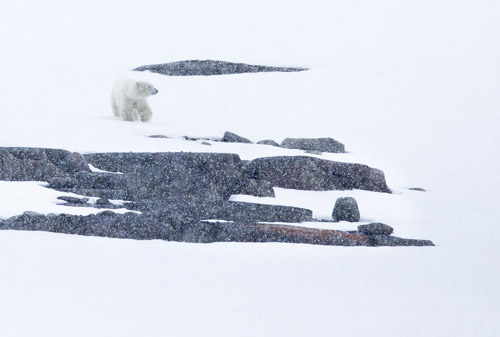
Attention! As early as 2016 small ship travel to the Arctic may be prohibited, including ships as large as 50 passengers or more. Our 2014 trip is full, but we will be offering what may be the last small passenger expedition to Svalbard in 2015! If interested, this may be your last and only chance. Contact our office ASAP!
Read our Brochure.
A trip to the far north, to Svalbard's north country above 82 degrees latitude, is not the usual photo tour or photo safari. These polar trips are more properly addressed as expeditions, as indeed we are at the extremes of the earth, just 8 degrees from the North Pole. Weather, ice, sea conditions, all can be a factor in making a trip a success or a failure, but always an adventure.
This was our first trip with a group, as last year we scouted this area on a larger boat in weather and conditions quite different from this year, where winds and advancing ice from the north significantly influenced the trip. Although we did have the same number of polar bears as last year we did not have the same luck, as our bears either slept or stayed some distance from shore. This was, of course, a disappointment, but except for the lack of bear photography opportunities we had, with all our other subjects, incredible success. We photographed three species of seal quite well, including Harbor, Bearded, and Ringed Seal, and their close cousin, the improbable Walrus. Birds, including Rock Ptarmigan, Common Eider, Common Murre, Red Phalarope, Black-legged Kittiwakes, Northern Fulmar and a few other species, and wild Reindeer rounded out our wildlife subjects. Landscape photography was extraordinary, and for our guide one day in a usually fog-bound fjord was the best he'd ever seen.
Our awareness that this was indeed an expedition was heightened when, at our most eastern point on the trip, we were nearly 'iced in' as northerly winds blew the drift ice south, nearly blocking off the entire northern archipelago. We made it through the ice in time and thus were not ice-bound, but the ships following us were locked out of this area until the winds shifted once more from the south.
This, our first true tour-expedition to this area, was quite different from last year's scouting trip, highlighting the fact that every trip is different. In contrast to last year, when we were on a 50 passenger ship with 5 guides, this year we used what I must say is the best ship I've ever been on for photography. We had eight participants, one great guide, and more room and deck space for photography than I've ever had before. Coupled with spectacular food and an extremely enthusiastic and attentive crew, eight for our eleven passengers, we thoroughly enjoyed the cruise. Our only regret was, quite honestly, that we could not book two trips back-to-back, as we were not ready to leave and now we're quite anxious to return. We will be doing this trip again in 2014 (which is already booked full) and 2015 and beyond. We hope you'll join us.
In the meantime, here's the Trip Report!
June 6. Our flight to Oslo went uneventfully, but our in-country transfer to Svalbard was a nightmare. We had about 1.5 hours for the transfer, which included our collecting our luggage, going through customs, and rechecking the luggage upstairs. One of our participant’s luggage was among the last to appear at the console, and, pressed for time, Mary and I left to scout out where we went next, to recheck the luggage on to Longyearbyen. That exercise took forever, as we had contradictory and misleading information, sending us from one line to another. With our departure imminent, Mary jumped into a Business Class check in, explained the problem, and all three of us, Mary, Nancy, and I, had our luggage checked in and, miraculously, the luggage made it onto the plane. Last year, we had some concern that our carry-on bags might be taken from us for the flight to Longyearbyen, and that action was subject to the whims of the airport staff at that time. They didn't, and this year we didn't even make a contingency plan if they would. Again, however, they did not and we had plenty of overhead luggage space for our camera bags.
Right before the trip Mary and I got our new Bataflae camera backpacks from Gura Gear which is a larger and improved version of their original Kiboko backpack. In addition to what they call their butterfly flaps for opening only one compartment at a time without opening the entire bag, the new bag has snaps to open the entire flap like a traditional backpack. The back is also deeper, so the bag zippers shut easily even when my 800mm was mounted inside. We loved the upgrade.
At the airport we were met by our guide, Morton, and our chartered bus driver, for the short drive to Longyearbyen. Mary and I rented two vehicles that we planned to use with the group over the next two days, exploring and photographing the wildlife around the town.
Although some ate at the hotel, Mary and I walked uptown looking for a bank. The bank was closed, 3:30PM, so we continued to the super market where Mary hoped to find gloves. There we grabbed lunch – two whole chicken legs (drum sticks and thighs), two Coke Zeroes, and three chocolate bars – for $30! Incredible.
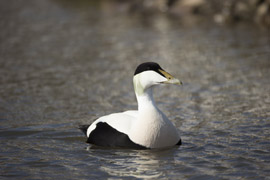
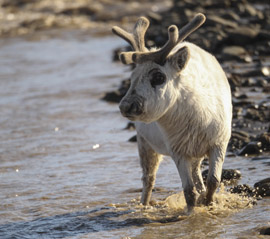
We had rented two vans and after a quick lunch we met at 4:30 for a drive into the countryside to look for reindeer, ptarmigan, loons, and eider ducks. Not far from town we had a small herd of four reindeer that crossed a distant braided stream bed and trotted across the spongy tundra, coming quite close to the road. They almost immediately turned around and ran back, then crossed the dirt road in front of us, and crossed another stream. The three joined another group of four which slowly moved upriver, tentatively trying to cross the rushing stream several times. We moved parallel with the herd and our patience was rewarded when the entire group finally crossed the stream in front of us, quite close, as they negotiated the fast water.
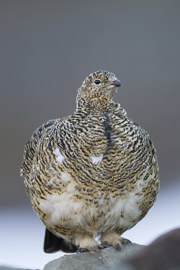 Morton, our guide, directed us to a spot near our hotel where the Svalbard Rock Ptarmigan is occasionally seen, and Judy spotted a well-camouflaged hen sitting atop a rock wall. The ptarmigan stayed in one spot as we kept a respectful distance, although Morton had said that the birds were incredibly tame. When we finished, Morton moved in close, about 15 feet from the bird which he then photographed with a wide-angle lens.
Morton, our guide, directed us to a spot near our hotel where the Svalbard Rock Ptarmigan is occasionally seen, and Judy spotted a well-camouflaged hen sitting atop a rock wall. The ptarmigan stayed in one spot as we kept a respectful distance, although Morton had said that the birds were incredibly tame. When we finished, Morton moved in close, about 15 feet from the bird which he then photographed with a wide-angle lens.
Although none of us were really hungry we assembled for dinner, and as some started we discovered that the mediocre buffet was $70/head, and the set menu entree’ was over $100. Since some had already ordered the rest of us picked the buffet as well, eating ourselves silly trying to recoup the exorbitant price for a dinner. By 9 we quit, bone-tired from the flight.
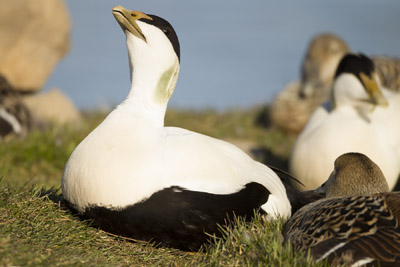
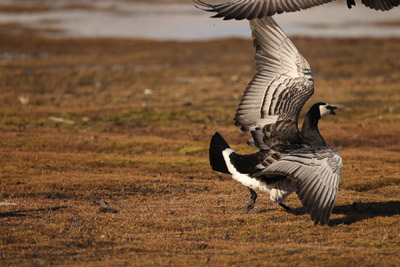
June 7. After breakfast we drove out to the Eider colony where, in a stiff wind, we photographed the Common Eiders nesting in the safety of a nearby sledge dog kennel. All of the birds were on nests, although a few males swam about, occasionally raising their heads skyward in a honking display that lasted only a second or two. Barnacle Geese contested tundra in the lowlands, occasionally flying into another’s territory and triggering a brief chase or squabble, and the rare pair flew and circled overhead.
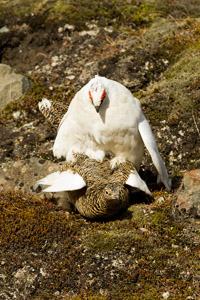
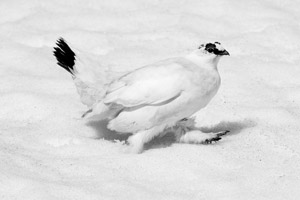
By 10 we had exhausted the subject and headed back to the Ptarmigan, hoping for another session in better light. Judy, once again, spotted a hen, this time some distance away beneath the wreckage of an old coal mine. I’d driven on, and not finding our bird from yesterday I did a U-turn and headed back downhill where, a few hundred yards away, I saw Mary’s vehicle parked. They were on the Ptarmigan, this time a pair, with the male still in its brilliant winter white plumage. The pair mated once before we arrived, but now, with all of us shooting, the pair walked downhill and quite close to us, offering some great shots that completed our morning.
After lunch and an hour or so visit to the Museum all of us walked to the Stockholm, our ship and home for the next six days. We left dock before 5, in a wind and rougher seas than I’d experienced previously here. Doris, Shirley, Judy, and Randy all had varying degrees of sea-sickness, and everyone else was simply exhausted from the time change and the day’s activities, leading to a very early turn in.

June 8. Mary and I slept for nearly 11 hours, and still awoke groggy and wishing for another few hour’s sleep. During the night we had sailed up the western coast of Svalbard, at times in very smooth waters protected by an outlying long island that blocked the western wind. We headed into a semi-protected fjord, searching for sea birds and polar bears, but we had no luck with the latter. Mary tried climbing to the Crow’s Nest, but with clogs she worried that her shoes would fall off as she negotiated the ropes for the final few feet.
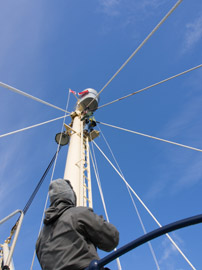 Heading out, we threaded a narrow passage between rocks where our guide said no other boat would go, as the water was too shallow and rocky, and this prompted some humorous scenarios and comments. We continued to the face of another glacier still blocked by fast ice, the sheet of ice still attached to shore. Close to the glacier front Morton spotted a mother Polar Bear with two young cubs that was hunting seals, but the distance was over a mile and the shooting virtually impossible. Our boat had cut a long channel through the fast ice getting us about a third of a mile deeper into the ice. I’d been on deck alone, attempting to shoot seabirds, when Mary found me with some chocolate she’d purchased in Longyearbyen, when a Walrus suddenly surfaced before us. It must have followed the open water and stayed for several minutes, long enough for Mary to run back inside, alert everyone and get her gear, before it did a final dive and disappeared. I expected it to resurface and to swim away down the lead but it did not. After the final dive it swam off under the ice and was gone.
Heading out, we threaded a narrow passage between rocks where our guide said no other boat would go, as the water was too shallow and rocky, and this prompted some humorous scenarios and comments. We continued to the face of another glacier still blocked by fast ice, the sheet of ice still attached to shore. Close to the glacier front Morton spotted a mother Polar Bear with two young cubs that was hunting seals, but the distance was over a mile and the shooting virtually impossible. Our boat had cut a long channel through the fast ice getting us about a third of a mile deeper into the ice. I’d been on deck alone, attempting to shoot seabirds, when Mary found me with some chocolate she’d purchased in Longyearbyen, when a Walrus suddenly surfaced before us. It must have followed the open water and stayed for several minutes, long enough for Mary to run back inside, alert everyone and get her gear, before it did a final dive and disappeared. I expected it to resurface and to swim away down the lead but it did not. After the final dive it swam off under the ice and was gone.
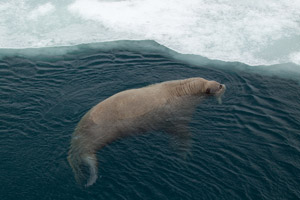
We stayed in the area until 5 hoping that the polar bear might grow curious and investigate the boat, but the bear stayed distant. We headed out, finally reaching another fjord and a tall sea cliff where Common Murres and Northern Skuas sailed overhead. The gale force wind we’d had all day was either blocked or had died down and we photographed the birds until dinner in surprisingly clement weather.
Summary: June 8 – Svitjobreen, harbor seals.
Roudfjorden – polar bear with two cubs
and walrus on ice
Hamiltonbunta – bird cliff for murres

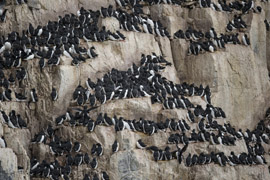 June 9. We sailed north and east, and during the night a force 5 gale slowed our progress. Although some slept entirely through it, Morton, Mary, and I did not, as we rode the waves, our stomachs sometimes lifting high as we were swept up a three or four meter wave, or jolted as the ship slammed back down into the sea. By 3:30AM our captain had maneuvered the ship into the lee of the wind and into some protection from the islands and the seas calmed, finally drawing us back into a sound sleep.
June 9. We sailed north and east, and during the night a force 5 gale slowed our progress. Although some slept entirely through it, Morton, Mary, and I did not, as we rode the waves, our stomachs sometimes lifting high as we were swept up a three or four meter wave, or jolted as the ship slammed back down into the sea. By 3:30AM our captain had maneuvered the ship into the lee of the wind and into some protection from the islands and the seas calmed, finally drawing us back into a sound sleep.
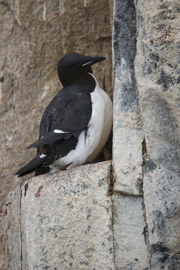 Our goal was the spectacular bird cliffs of the Hinlopen Straits where 100,000 pairs of Common Murres nest. Last year, on a larger boat, we visited these cliffs by zodiac, giving us a very intimate experience where, at times, we could almost touch the cliffs, but a difficult base for photography. In the zodiacs, despite the relatively calm seas, we were tossed about constantly, and framing, even with a short lens, was problematic. With the shallow draft of the Stockholm, only three or four meters, we sailed directly to the cliff edge with our boat. Our shooting platform was both quite sturdy and rather diverse, as shooters had the option of climbing to the sun deck or shooting forward, at the bow, where birds were within twenty yards of the ship.
Our goal was the spectacular bird cliffs of the Hinlopen Straits where 100,000 pairs of Common Murres nest. Last year, on a larger boat, we visited these cliffs by zodiac, giving us a very intimate experience where, at times, we could almost touch the cliffs, but a difficult base for photography. In the zodiacs, despite the relatively calm seas, we were tossed about constantly, and framing, even with a short lens, was problematic. With the shallow draft of the Stockholm, only three or four meters, we sailed directly to the cliff edge with our boat. Our shooting platform was both quite sturdy and rather diverse, as shooters had the option of climbing to the sun deck or shooting forward, at the bow, where birds were within twenty yards of the ship.
Murres nest on steep cliffs as protection from terrestrial predators like arctic fox, where they lay a single, quite oblong egg on a narrow shelf of rock. Tapered as it is, should the egg roll it does so in a circle, rather than rolling along straight, and by doing so the egg is less likely to roll off the ledge and into the sea. Birds were packed tightly on appropriate shelves, other singly on narrow, jutting projections, or upon snow banks that still covered their traditional nesting spot. Occasionally much of a cliff’s 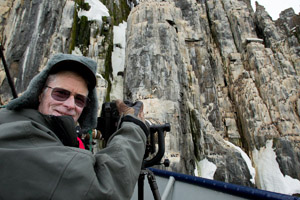 edge would erupt in a flash of black and white wings as birds launched themselves in union, angling downward until momentum and tiny, furiously beating wings pulled them into level flight.
edge would erupt in a flash of black and white wings as birds launched themselves in union, angling downward until momentum and tiny, furiously beating wings pulled them into level flight.
Occasionally a pair of murres would hit the water, squaring off for a moment before closing in a vicious, stabbing, grabbing tussle as two birds fought. Wings flapped, birds were dunked, and the fight continued, as our boat, following the pull of the tide, slipped along beside the sea cliffs. Two Glaucous Gulls fought over a murre casualty, bobbing in the tossing seas as they slowly pulled apart a carcass. I wondered if this carcass was the result of a fight like the one I'd just seen, or with 100,000 or more breeding pairs it was just a natural death.
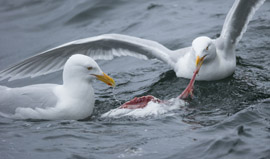
We saw no eggs, but the birds generally lay and hatch in synchrony, so that when the vulnerable young fledge, gliding seaward to crash awkwardly into the sea or, for birds nesting on cliffs with solid ground below, to crash and bounce and roll across tundra or rocks. Leaving the nest in synchrony, the birds overwhelm their predators with numbers so that predators are quickly sated and otherwise exposed young, those landing in fox-country, may still have a chance to shuffle into the sea.
We did two long runs along the cliff, letting the southern current guide our ship as we fired away. The shoot lasted about an hour before we headed further south, where pack ice still closed the southern end of the strait and where we hoped to find another bear. We hadn’t traveled far when Morten spotted another bear on 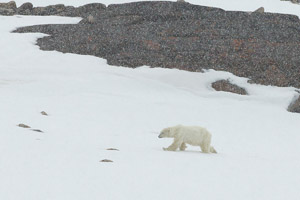 shore, crossing the sloping bank of a glacier. The bear disappeared quickly but reappeared, walking through a broken landscape of snow and rock that reminded me of the setting for a Bev Doolittle painting, painted horses and winter-clad Sioux Indians. The bear was moving toward us but stopped short of the shore, lying down and apparently falling asleep. We launched a zodiac in hopes that the bear might grow curious and approach but by the time we reached the bay the bear had overlooked, it was gone. We found it again, high up on a ledge overlooking the sea, but the angle was tough and only the bear’s head was visible above the rocks.
shore, crossing the sloping bank of a glacier. The bear disappeared quickly but reappeared, walking through a broken landscape of snow and rock that reminded me of the setting for a Bev Doolittle painting, painted horses and winter-clad Sioux Indians. The bear was moving toward us but stopped short of the shore, lying down and apparently falling asleep. We launched a zodiac in hopes that the bear might grow curious and approach but by the time we reached the bay the bear had overlooked, it was gone. We found it again, high up on a ledge overlooking the sea, but the angle was tough and only the bear’s head was visible above the rocks.
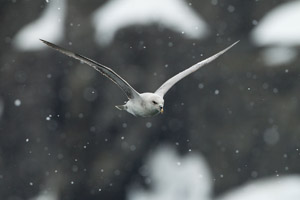
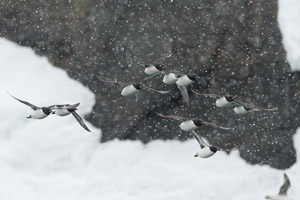
We continued south, encountering pack ice and pancake ice intermittently until, by late afternoon, the solid pack stopped our progress. We turned north, hoping to inspect a whale carcass where a bear, or bears, had been feeding last fall and this spring, but we didn’t reach that bay until 12:30AM. Everyone had gone to bed but a few of us, Tom, Bill, Doris, Morten, Mary, and I got up to check. A bear was present, but distant, and collared, and the carcass was an almost indistinguishable yellowish-white hump of flesh and bone. The near-dusk light was pretty, with squalls of snow shrouding distant mountain ranges and a black storm cloud framing a far off, sun-lit glacier face.
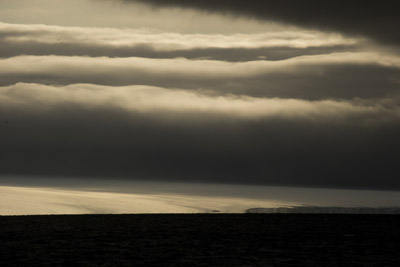
Summary: June 9 – Alkefjellet – Hinlopen Bird cliff for Murres
Tommelpynten – polar bear
Lomfjordon – whale carcass and polar bear
June 10. We continued north through the night, hoping to reach the far northwestern corner of the easternmost big island, Nordaustlandet, where fjords still holding fast ice (ice still attached to the shoreline) and a closer pack ice should harbor walruses and bears. Shortly after breakfast, in rather shallow water just a few meters deeper than our draft, we passed by two Walruses lying on an ice sheet. The walruses, males, raised their heads in turn but stayed still otherwise, and with the shallow water our maneuverability was compromised, requiring us to shoot as we sailed on past.
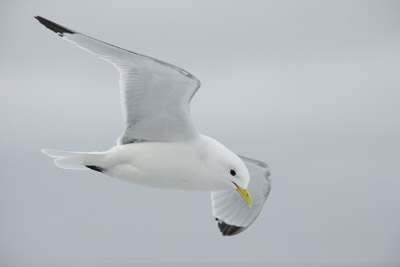
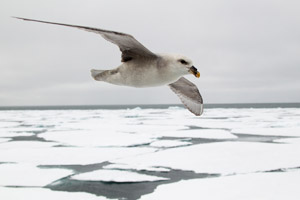
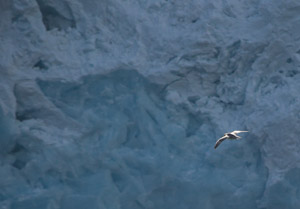
Northern Fulmars glided by constantly as we sailed, sometimes barely an arm’s length from the boat, and periodically small flocks of Black-legged Kittiwakes, small gulls with wingtips ‘dipped in ink’, would join in and flitter by. With winds coming from the north and northwest our concern now was the moving pack ice, and as we traveled north we wondered if we’d be stopped by impenetrable ice and, even worse, have our western route blocked as we begin to sail back to Longyearbyen.
After lunch we reached our easternmost point of travel, and enroute we met another small group of three male walruses lying on a flat sheet of ice amidst the scattered ice field. The walruses were about a quarter mile into the ice from the open sea, but our captain slowly, very slowly, and carefully maneuvered the boat closer and closer until the walruses were frame-filling at 500mm. One male grew shy and slowly slid into the water, while the other two remained calm, periodically raising their heads to look about. A second walrus slowly worked its way into the sea and, with the ice drifting our boat into ever shallower water, we backed out and continued onward.
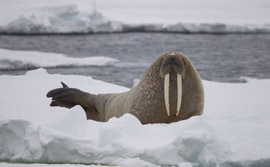
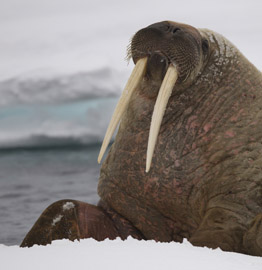
The walruses we’d seen were all males, which is typical around Svalbard as the females and calves frequent areas to the far northeast. Unlike most seals the raising of young in walruses lasts over two years. In contrast, the almost equally large hooded seal nurses and weans its single baby in less then ten days, whereupon it deserts its young to the ice. While I say ‘seal,’ the exact classification of walruses is debated, as these huge animals have characteristics of both the true seals and the eared seals. True seals have hind flippers that point backward, like a fish’s fin, and are not used in locomotion. To crawl across the ice true seals hump along like a fat caterpillar, using their fore-flippers to help with traction. True seals are earless as well, in contrast to the ‘eared seals,’ the sea lions and fur seals who also have hind flippers that can extend forward under their body and can be used for dynamic motion. Fur and sea lions can literally gallop across a beach, and are said to be able to outrun a man. Two years ago, in South Georgia, a fur seal galloped at speed at me, which I stopped just feet away when I stuck my tripod legs in its face. Twenty minutes later that same fur seal charged another guide, one without a tripod, and knocked him down, then bit and ripped his knee. Walruses are earless, but they have hind flippers like a fur seal, hence the debate.
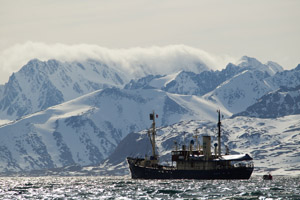
We were waiting for the 3PM ice report to determine our route. This being Monday, our last report was on Friday as forecasts or reports are not delivered over the weekend. Our concern was the wind, as the ice was traveling south at about 1 km per hour and, by this point, our last report was 30 hours earlier. When the report arrived we found that the tongue of ice that had extended south toward Hinlopen was now nearly to the point, and the entire ice sheet was very close to blocking our westward escape. We headed west.
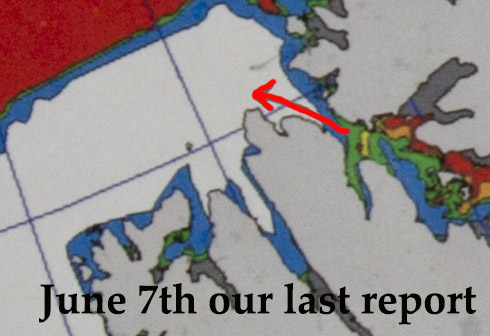

Our last ice report was transmitted on Friday, June 7th. As you can see, the ice was far above our intended route and the entire area was ice-free. On June 10th, the northern winds had pushed the ice south, and now threatened to close our route west. Had this not occured, we would have continued traveling to the northeast.
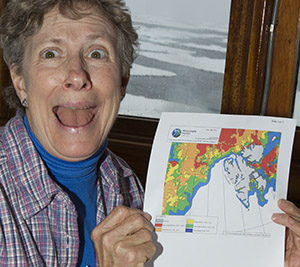
Mary reacts to the new, June 10th map, and the prospects of being ice-bound with me. I was worried when Mary started referring to the Donner Party!
As we neared the critical gap we discovered that indeed the drift ice had moved far south, and our route was now an ice-choked channel. Along the western horizon we could see variations in the sky, light most spots, dark in one tiny area. These light areas are known as ‘light blinks,’ and are the reflections of ice on clouds or low fog, 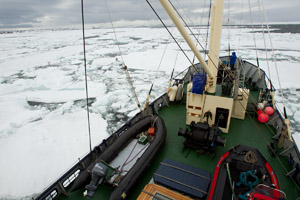 although, of course, these blinks would not be visible on clear-sky days. With a dark line, a ‘dark blink’ if you will, we hoped that we would have sufficient open water to push through. The next two hours, however, were tension-filled, and virtually everyone was on the bridge watching and assessing our progress as we slowly plowed through ice cakes to break into the twisted, narrow leads of open water. Drift ice is rated on a scale, from 1/10 to 10/10, with a one signifying little ice and plenty of open water, while a ten indicates unbroken pack ice. We were traveling through 9/10 ice, a very serious obstacle, and with the wind continuing to blow from the north more and more ice was gradually compacting the drift ice into one unbroken mass. Several times our progress appeared to be stalled, as only the line of solid white ice cloaked the horizon, but each time, as we drew closer, another stretch of open water was revealed. In that way, we advanced, until a long dark line indicated open sea and through binoculars the tiny stripes of whitecaps indicated open sea. We made it!
although, of course, these blinks would not be visible on clear-sky days. With a dark line, a ‘dark blink’ if you will, we hoped that we would have sufficient open water to push through. The next two hours, however, were tension-filled, and virtually everyone was on the bridge watching and assessing our progress as we slowly plowed through ice cakes to break into the twisted, narrow leads of open water. Drift ice is rated on a scale, from 1/10 to 10/10, with a one signifying little ice and plenty of open water, while a ten indicates unbroken pack ice. We were traveling through 9/10 ice, a very serious obstacle, and with the wind continuing to blow from the north more and more ice was gradually compacting the drift ice into one unbroken mass. Several times our progress appeared to be stalled, as only the line of solid white ice cloaked the horizon, but each time, as we drew closer, another stretch of open water was revealed. In that way, we advanced, until a long dark line indicated open sea and through binoculars the tiny stripes of whitecaps indicated open sea. We made it!
The company’s sister ship was scheduled to pass eastward through these waters tomorrow but it will be interesting to learn whether or not they do. As it stands now, the next cruise might be limited only to the waters of the northwest, missing the wonderful bird cliffs, the walruses, and the ice pack that may harbor bears. Ironically, this same passage had been open since April, and June is usually the least windy month. This year, in contrast to last, which was a typical year without wind, winds started from the northwest a few days ago and are predicted to continue at least another week. If this holds, more and more ice will jam itself onto the northern shores, making the area impassable until summer’s warmth or southern winds clear the area once more.
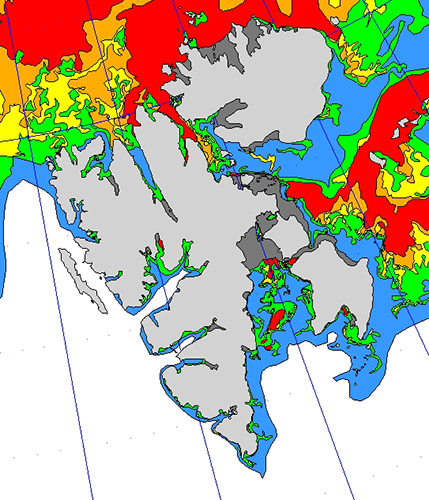
This is an ice map of June 14th, the day we anchored back in Longyearbyen. As you can see, the ice pack continued to be pushed south after we made it through the northern gap and, as of June 14th, this entire area would be inaccessible to ships.
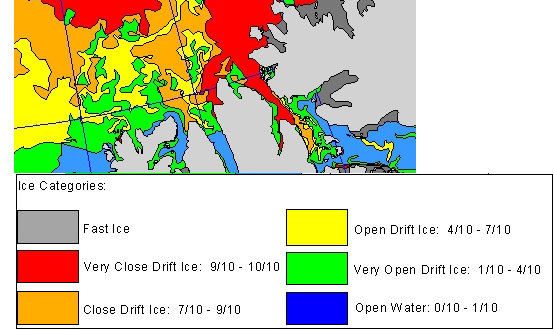
The chart explains the colors, with the lightest gray area denoting land. The red color on the center-right side of the map is now extending far into the Hinlopen Straits where we sailed for the bird colony and then moved south to look for bears. That area is now completely blocked by ice! Last year, at this same time, there was no ice in these areas, and this area had been open and ice free from April until
the winds started blowing from the north on June 9th! Obviously, every year is different! Maps courtesy of the Meteorologisk institutt, met.no., forecasting division for Northern Norway.
Summary: June 10 - walruses on ice
Breaking free through the 9/10 drift ice
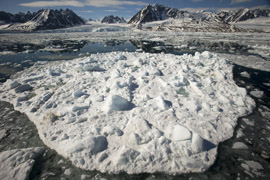 June 11. At approximately 3AM our ship reached Woodfjorden, a fjord with fast ice where we hoped to find bears. The ship jammed itself into the ice to hold fast, and if bears were present we hoped that they might investigate the boat. There were no bears, but over a half dozen Bearded Seals dotted the fast ice extending to the distant shoreline. The landscape, ice and mountains under a beautiful, clear day, were spectacular, and we spent the first part of the morning scanning for bears and photographing the landscape.
June 11. At approximately 3AM our ship reached Woodfjorden, a fjord with fast ice where we hoped to find bears. The ship jammed itself into the ice to hold fast, and if bears were present we hoped that they might investigate the boat. There were no bears, but over a half dozen Bearded Seals dotted the fast ice extending to the distant shoreline. The landscape, ice and mountains under a beautiful, clear day, were spectacular, and we spent the first part of the morning scanning for bears and photographing the landscape.
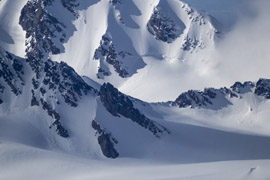
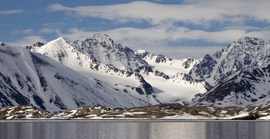
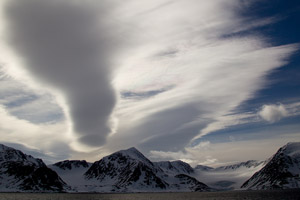
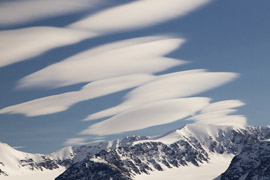
Morton, our guide, had been in the fjord many times, but never with the ice and the clear skies we enjoyed today, and this turned out to be his favorite day of the trip. As we were about to reverse ourselves out of the ice a bearded seal 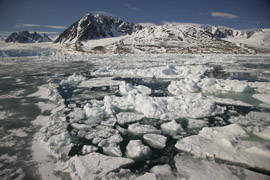 hauled out on the ice relatively close to the open water. After making our first, throw-away shots from the boat’s anchored position the boat slowly approached the seal, breaking into the thin fast ice as we moved closer. Eventually we were within full-frame distance with an 800mm, and within good image size for smaller lenses, where we stayed and photographed until we again backed off, leaving the seal undisturbed on the ice.
hauled out on the ice relatively close to the open water. After making our first, throw-away shots from the boat’s anchored position the boat slowly approached the seal, breaking into the thin fast ice as we moved closer. Eventually we were within full-frame distance with an 800mm, and within good image size for smaller lenses, where we stayed and photographed until we again backed off, leaving the seal undisturbed on the ice.
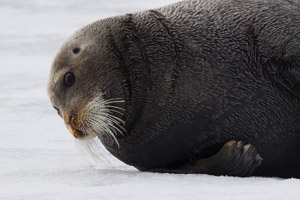
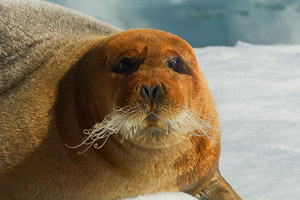
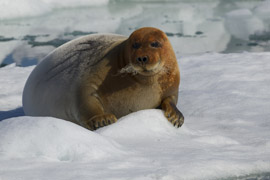
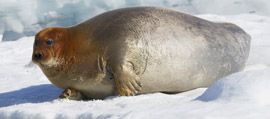
We continued onward to Liefterfjorden, where at its end an extensive glacial front stretched across the horizon. Flying saucer-shaped lenticular clouds dotted the sky above the ridges, and broken fast ice created a jumble of pressure ridges, snow/ice piles, and stretches of open water. The captain turned off the engine and over lunch we ate in a frozen world of silence, scanning the ice near and far for a bear we felt simply had to be there. Six different seals were visible at one time lying on ice or perched a bit higher on low ridges, and I could practically picture a bear suddenly materializing from behind an ice floe. We approached three different bearded seals for great photos, with one slipping back into the sea and, in doing so, showing a tattered, gutty pile of tissue that we didn’t notice until looking at our images later. Although we’re still not sure, whether the tissue is old afterbirth still attached or the tattered flipper from a bear attack, but we believe the latter.
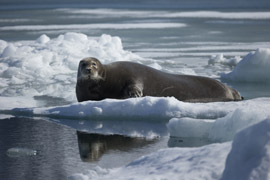
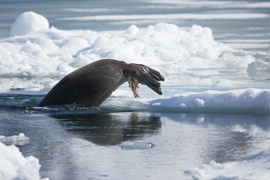
Nonetheless, a bear never appeared and at 3PM we moved out, following the shoreline as we headed out to some islands where we’d again look for bear.
Closer to the mouth of the fjord we disembarked into zodiacs and the Svalbard’s unique motor craft, the Articcirkel, a cross between an outboard and a zodiac, to search the island shorelines for bear. Minutes after Morten and Mary’s zodiac reached the water they spotted a bear, but before they could get close it slipped over the horizon. When we approached, terns and gulls were screaming and I guessed a bear was about, which Mary then confirmed when we joined up. Following the shoreline, we spotted the bear again, lying atop the ridge line, asleep, with terns and jaegers and gulls periodically swooping in, harassing the oblivious bear.
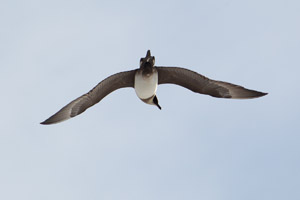
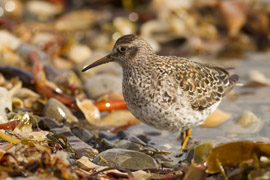
We grounded the boats, hoping that the bear might grow curious and come closer, but it did little but rise, shift position, and lie down again. Purple Sandpipers approached, the males actively courting females by raising one wing flat and vertical, then dropping the wing as they chased after the reluctant mate. Red Phalaropes landed close-by, white-faced and red-bodied. Female phalaropes are the bright colored sex, and the males are drab, and unlike most birds, females are polygamous, mating with several males that end up tending separate clutches. Arctic Terns, the first we’ve seen this season, were common, hovering nearby and periodically diving close for fish. The bear never moved, and since Morton felt the bear was settled we returned to the boat where we could be warm and watch the bear, should it decide to move.
It didn’t, and a stiff west wind developed, turning the sea into a froth of small whitecaps that discouraged us from waiting further. With a stiff western wind predicted we headed out, hoping to beat the roughest seas as we continued on to our next destination.
Summary: June 11 – Fast Ice and seals at glacier at Woodfjorden
Monaco Glacier, ice and bearded seals PM
PM – Andoyane – polar bear asleep on island, from zodiacs
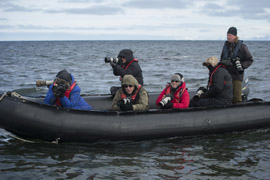 June 12. Shortly after breakfast we headed into a bay called Fuglehuken where one of the most northern populations of Harbor Seals regularly haul out on rocks a few feet off shore. Other than these isolated, remote harbor seals here on Svalbard, the next nearest northern population is around 800 miles further south. Some wonder if their presence here is a relic population from a warmer time when the seals moved north, but if so, then one has to wonder what happened to the polar bears during this warming trend. Sea ice obviously shrank, and presumably stressed the bears as much as our modern warming trend is doing, but the bears rebounded and survived. Harbor seals themselves probably suffer little predation from polar bears on this, the western edge of the archipelago, but a disproportionate number of adult seals disappear. Research seems to indicate that this may be due to predation of the Greenland Shark, the third largest species after the whale shark and basking shark. Unlike the other two, Greenland sharks are predacious, not filter-feeders, and could be responsible for these disappearances. Elsewhere in their range, harbor seals live as long as 30-35 years, but here most live only to twenty.
June 12. Shortly after breakfast we headed into a bay called Fuglehuken where one of the most northern populations of Harbor Seals regularly haul out on rocks a few feet off shore. Other than these isolated, remote harbor seals here on Svalbard, the next nearest northern population is around 800 miles further south. Some wonder if their presence here is a relic population from a warmer time when the seals moved north, but if so, then one has to wonder what happened to the polar bears during this warming trend. Sea ice obviously shrank, and presumably stressed the bears as much as our modern warming trend is doing, but the bears rebounded and survived. Harbor seals themselves probably suffer little predation from polar bears on this, the western edge of the archipelago, but a disproportionate number of adult seals disappear. Research seems to indicate that this may be due to predation of the Greenland Shark, the third largest species after the whale shark and basking shark. Unlike the other two, Greenland sharks are predacious, not filter-feeders, and could be responsible for these disappearances. Elsewhere in their range, harbor seals live as long as 30-35 years, but here most live only to twenty.
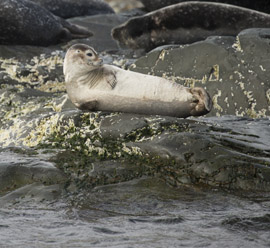 The surrounding waters were shallow, so our zodiac and arcticirkle boat rides in were long, but relatively dry. As we approached about a dozen seals slipped off the rocks into the sea, causing us some worry that the seals would not cooperate. Our worries, however, proved unfounded, as the majority of the seals remained on various rocks, their coats often blending perfectly into the wet rocks to practically disappear. Periodically one or more seals would swim out to inspect us, sometimes lingering for several seconds above water, their heads clearly visible, though most gave us a maritime version of a ‘whack a mole,’ as the seals popped up and disappeared faster than we could point a camera. Nonetheless, we had multiple opportunities and everyone got some nice shots.
The surrounding waters were shallow, so our zodiac and arcticirkle boat rides in were long, but relatively dry. As we approached about a dozen seals slipped off the rocks into the sea, causing us some worry that the seals would not cooperate. Our worries, however, proved unfounded, as the majority of the seals remained on various rocks, their coats often blending perfectly into the wet rocks to practically disappear. Periodically one or more seals would swim out to inspect us, sometimes lingering for several seconds above water, their heads clearly visible, though most gave us a maritime version of a ‘whack a mole,’ as the seals popped up and disappeared faster than we could point a camera. Nonetheless, we had multiple opportunities and everyone got some nice shots.
The strong winds forecasted for later in the day arose while we were still with the seals and our return to the ship was a small adventure. Johann, the boatman for the Arcticirkle gunned his engine and rode with the bow high, sparing us from most sprays of surf. However, at the ship the hard sides of our craft made boarding difficult, as we bounced about in the waves and banged against the loading ladder. Judy was first off, and nearly slipped in a swell, and got a little banged up before getting her footing and getting up the ladder. Don went next, and another bump sent him falling back into the boat, fortunately without injury. We aborted our attempt at that point, and the Svalbard hauled anchor and swung around in the wind, and from this new position blocked most of the swells, allowing us to safely board via the ladder. Still, the waves were too turbulent to bother passing gear and instead our dry bags stayed in the boat which was then winched back on board. At one point, the craft almost went vertical in a wave, and we worried that our gear would spill into the sea. None did, and everything got back on board safely.
With heavy winds we headed south, hoping to reach a beach where walruses might be basking on shore. En route we passed another spot where, by chance, about a dozen walruses were lying on the sand. The wind was high, and the waves sufficient that everyone boarded one zodiac, making for a heavy craft with eleven people, tripods, and backpacks for a shore excursion. Although we rode lower in the water than usual, the ride was surprisingly dry and we reached shore without event.
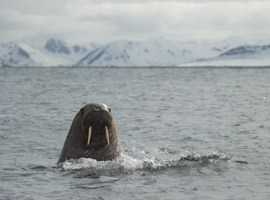
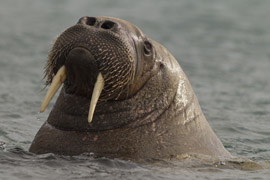
Wind whipped our plastic bags covering our backpacks as we disembarked, but the high winds slowed considerably as we walked the few hundred yards to the walruses. Most lay on the beach like huge brown sea slugs but two, a young male with tiny tusks and another, older male with relatively good ivory, played and wrestled in the surf. Slowly and carefully we moved closer, working our way to the shoreline to be closest to the pair and, as we expected, they grew curious and swam quite close to us several times.
Those on the beach did nothing but an occasional scratch, but towards the end of the shoot three more walruses swam to us, fast and direct, coming quite close to the beach. Again the shooting was spectacular with everyone getting nice shots. An added bonus were the Arctic Terns hovering and diving in the waters nearby and a Purple Sandpiper that worked the surf line, almost foraging right into us for some very close shots.
The ride back was uneventful as we motored with the wind but we were warned that at the ship we’d be turning, and probably getting wet. I was sitting up front and caught a good soaking as a wave broke over our bow, but otherwise the boarding back onto the ship went effortlessly. We sailed on, hitting another fjord where we hoped to find fast ice but the winds had broken up all the ice, and in the evening light we were treated only to a spectacular view of the mountains surrounding the broad bay.
Summary: June 12 – Fuglehuken – Harbor seals
Murraypynten – Walruses and arctic terns
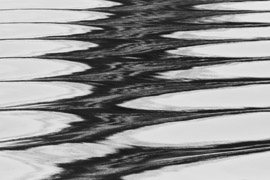 June 13. We motored through the night, passing Longyearbyen as we headed east to our final fjords where, ten days ago, a mother bear with two yearling cubs had been frequenting for weeks. When we started our cruise a week ago this fjord, Templefjorpon, was covered in fast ice five miles or more from the glacier front, and a bear, then, could have been anywhere. Now, with ice quickly melting, we hoped that the diminishing fast ice would constrict the bears to an area where we could get close, if they were there.
June 13. We motored through the night, passing Longyearbyen as we headed east to our final fjords where, ten days ago, a mother bear with two yearling cubs had been frequenting for weeks. When we started our cruise a week ago this fjord, Templefjorpon, was covered in fast ice five miles or more from the glacier front, and a bear, then, could have been anywhere. Now, with ice quickly melting, we hoped that the diminishing fast ice would constrict the bears to an area where we could get close, if they were there.
Seals were everywhere on the remaining fast ice and we cruised up and down the face, watching for bears and being treated to the best Northern Fulmar flight photography possible. At one point, nearly a hundred birds were in the air flying 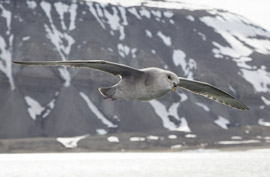 behind the boat and coming close, but my wide-angle, perfect for this shot, was down below. By the time I got the lens that show was over, but fulmars flew so close that I, and Judy later, did some great shots of birds flying by with the Cathedral sandstone cliffs visible in the background, making wonderful bird in habitat shots with big birds! Several Atlantic Puffins flew across the ice and several of us got shots, although the birds never passed close.
behind the boat and coming close, but my wide-angle, perfect for this shot, was down below. By the time I got the lens that show was over, but fulmars flew so close that I, and Judy later, did some great shots of birds flying by with the Cathedral sandstone cliffs visible in the background, making wonderful bird in habitat shots with big birds! Several Atlantic Puffins flew across the ice and several of us got shots, although the birds never passed close.
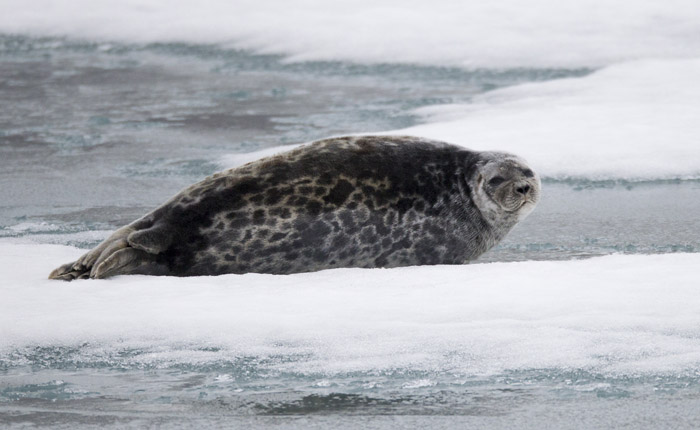
We traveled into the fast ice as far as possible, and then parked in the ice for several hours, hoping that the bear might materialize. It did not. In the late afternoon we moved back out of the ice, anchored for the late afternoon, and moved quite close to one of the Arctic's most elusive and shy seals, the Ringed Seal. I'd never seen one before, but the seal is unmistakeable with its mottled coat, circumscribed with black rings that give the seal its name.
After dinner we had a group slide show of the images made during the expedition. Since we were anchored the entire crew could join us, after what was perhaps the best meal I’ve had on any boat – hand-sliced potatoes in thin strips, a venison loin that was cooked to medium rare perfection, and an incredibly tasty dessert. After the show we motored on, and some time during the night we reached the outskirts of Longyearbyen.
Summary: June 13 - Templefjorpon
Puffins, Northern Fulmar, Ringed Seal
June 14. We anchored at nine, meeting our bus for a transport to the hotel where we remained until nearly 1 for another bus ride to the airport. A group of 57 Chinese tourists were also departing, but we beat them to the airport and checked in without too much of a problem.
However, at Tromso, we had to depart the plane, collect all of our luggage, and go through official Norwegian customs, as Svalbard is actually out of the European Union and is considered its own international destination. Luggage was late, and after collecting it we waited in a long line where, when we reached the ticket counter, we were told we couldn’t transfer our luggage via that counter. I had the guy make a phone call as we moved to the end of another very long line, and when he was finished, luckily, the ticket agent bumped all of us up to the front of that line to recheck our baggage. By that time, our flight to Oslo was far into boarding and all overhead spaces were full. We kept our bags at our feet for the last 1.5 hour flight.
Everyone’s luggage arrived, as it was the only plane, although some people had some confusion as their luggage was tagged straight through to the US, or, as with Tom, one piece was while he had to collect his other piece. As we were staying in two different hotels we said good-bye at the airport and went our separate ways… for now, as everyone will be on a trip with us within six months, or sooner!
While we didn’t have the type of photo-luck with polar bears that we had last year, we still had six bears, and we had had incredible luck with seals and walruses and birds, as well as some of the best scenery our guide, Morton, had ever had. Two of our nine people are already signed up for next year, and two others will, if we have the space, which is true testimony to how wonderful this trip is. For us, we can’t wait to get back, and we wish our schedule would have allowed us to do two back-to-back trips during this dynamic, late Spring, early Summer season.
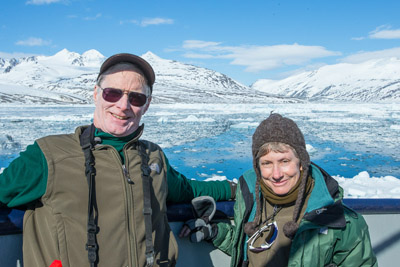
June 15. The flight home was uneventful without any of the stress we had making our first connection to Longyearbyen a week earlier. We flew SAS and I must say, Mary and I felt the food was the best airplane meals we've had on a trans-Atlantic flight. The movie selection was good, too!
The end of the trip almost culminated in a disaster, however, when we were loading ourselves into the limo we contracted for our ride from Newark, NJ to my sister's home in eastern Pa. In the parking lot a fast moving car almost hit me as he sped by, missing my backward-extended leg by just inches. He never stopped -- welcome back to the US! Otherwise, after nearly 24 hours of no sleep we arrived home, safely, to conclude the journey.
Although we are booked full for 2014 there could always be an unexpected cancellation, so if you are interested in next year's trip please contact the office.
There may still be spaces available for our 2015 expedition, please contact our office to be on our First Contact List. We always go on a first-come, first-contacted basis, so please let us know if you are interested.
For more details on this area, refer to our 2012 Scouting Trip Report or
to our Brochure (available shortly!)
About Your Leaders
Contact us by e-mail at
info@hoothollow.com
Office Phone: 717 543-6423
Or FAX us at: (717) 543-5342.
Return to HomePage or to photo tours general information.
Svalbard Wildlife Photo Expedition
TRIP REPORT, 2013

Attention! As early as 2016 small ship travel to the Arctic may be prohibited, including ships as large as 50 passengers or more. Our 2014 trip is full, but we will be offering what may be the last small passenger expedition to Svalbard in 2015! If interested, this may be your last and only chance. Contact our office ASAP!
Read our Brochure.
A trip to the far north, to Svalbard's north country above 82 degrees latitude, is not the usual photo tour or photo safari. These polar trips are more properly addressed as expeditions, as indeed we are at the extremes of the earth, just 8 degrees from the North Pole. Weather, ice, sea conditions, all can be a factor in making a trip a success or a failure, but always an adventure.
This was our first trip with a group, as last year we scouted this area on a larger boat in weather and conditions quite different from this year, where winds and advancing ice from the north significantly influenced the trip. Although we did have the same number of polar bears as last year we did not have the same luck, as our bears either slept or stayed some distance from shore. This was, of course, a disappointment, but except for the lack of bear photography opportunities we had, with all our other subjects, incredible success. We photographed three species of seal quite well, including Harbor, Bearded, and Ringed Seal, and their close cousin, the improbable Walrus. Birds, including Rock Ptarmigan, Common Eider, Common Murre, Red Phalarope, Black-legged Kittiwakes, Northern Fulmar and a few other species, and wild Reindeer rounded out our wildlife subjects. Landscape photography was extraordinary, and for our guide one day in a usually fog-bound fjord was the best he'd ever seen.
Our awareness that this was indeed an expedition was heightened when, at our most eastern point on the trip, we were nearly 'iced in' as northerly winds blew the drift ice south, nearly blocking off the entire northern archipelago. We made it through the ice in time and thus were not ice-bound, but the ships following us were locked out of this area until the winds shifted once more from the south.
This, our first true tour-expedition to this area, was quite different from last year's scouting trip, highlighting the fact that every trip is different. In contrast to last year, when we were on a 50 passenger ship with 5 guides, this year we used what I must say is the best ship I've ever been on for photography. We had eight participants, one great guide, and more room and deck space for photography than I've ever had before. Coupled with spectacular food and an extremely enthusiastic and attentive crew, eight for our eleven passengers, we thoroughly enjoyed the cruise. Our only regret was, quite honestly, that we could not book two trips back-to-back, as we were not ready to leave and now we're quite anxious to return. We will be doing this trip again in 2014 (which is already booked full) and 2015 and beyond. We hope you'll join us.
In the meantime, here's the Trip Report!
June 6. Our flight to Oslo went uneventfully, but our in-country transfer to Svalbard was a nightmare. We had about 1.5 hours for the transfer, which included our collecting our luggage, going through customs, and rechecking the luggage upstairs. One of our participant’s luggage was among the last to appear at the console, and, pressed for time, Mary and I left to scout out where we went next, to recheck the luggage on to Longyearbyen. That exercise took forever, as we had contradictory and misleading information, sending us from one line to another. With our departure imminent, Mary jumped into a Business Class check in, explained the problem, and all three of us, Mary, Nancy, and I, had our luggage checked in and, miraculously, the luggage made it onto the plane. Last year, we had some concern that our carry-on bags might be taken from us for the flight to Longyearbyen, and that action was subject to the whims of the airport staff at that time. They didn't, and this year we didn't even make a contingency plan if they would. Again, however, they did not and we had plenty of overhead luggage space for our camera bags.
Right before the trip Mary and I got our new Bataflae camera backpacks from Gura Gear which is a larger and improved version of their original Kiboko backpack. In addition to what they call their butterfly flaps for opening only one compartment at a time without opening the entire bag, the new bag has snaps to open the entire flap like a traditional backpack. The back is also deeper, so the bag zippers shut easily even when my 800mm was mounted inside. We loved the upgrade.
At the airport we were met by our guide, Morton, and our chartered bus driver, for the short drive to Longyearbyen. Mary and I rented two vehicles that we planned to use with the group over the next two days, exploring and photographing the wildlife around the town.
Although some ate at the hotel, Mary and I walked uptown looking for a bank. The bank was closed, 3:30PM, so we continued to the super market where Mary hoped to find gloves. There we grabbed lunch – two whole chicken legs (drum sticks and thighs), two Coke Zeroes, and three chocolate bars – for $30! Incredible.


We had rented two vans and after a quick lunch we met at 4:30 for a drive into the countryside to look for reindeer, ptarmigan, loons, and eider ducks. Not far from town we had a small herd of four reindeer that crossed a distant braided stream bed and trotted across the spongy tundra, coming quite close to the road. They almost immediately turned around and ran back, then crossed the dirt road in front of us, and crossed another stream. The three joined another group of four which slowly moved upriver, tentatively trying to cross the rushing stream several times. We moved parallel with the herd and our patience was rewarded when the entire group finally crossed the stream in front of us, quite close, as they negotiated the fast water.
 Morton, our guide, directed us to a spot near our hotel where the Svalbard Rock Ptarmigan is occasionally seen, and Judy spotted a well-camouflaged hen sitting atop a rock wall. The ptarmigan stayed in one spot as we kept a respectful distance, although Morton had said that the birds were incredibly tame. When we finished, Morton moved in close, about 15 feet from the bird which he then photographed with a wide-angle lens.
Morton, our guide, directed us to a spot near our hotel where the Svalbard Rock Ptarmigan is occasionally seen, and Judy spotted a well-camouflaged hen sitting atop a rock wall. The ptarmigan stayed in one spot as we kept a respectful distance, although Morton had said that the birds were incredibly tame. When we finished, Morton moved in close, about 15 feet from the bird which he then photographed with a wide-angle lens.
Although none of us were really hungry we assembled for dinner, and as some started we discovered that the mediocre buffet was $70/head, and the set menu entree’ was over $100. Since some had already ordered the rest of us picked the buffet as well, eating ourselves silly trying to recoup the exorbitant price for a dinner. By 9 we quit, bone-tired from the flight.


June 7. After breakfast we drove out to the Eider colony where, in a stiff wind, we photographed the Common Eiders nesting in the safety of a nearby sledge dog kennel. All of the birds were on nests, although a few males swam about, occasionally raising their heads skyward in a honking display that lasted only a second or two. Barnacle Geese contested tundra in the lowlands, occasionally flying into another’s territory and triggering a brief chase or squabble, and the rare pair flew and circled overhead.


By 10 we had exhausted the subject and headed back to the Ptarmigan, hoping for another session in better light. Judy, once again, spotted a hen, this time some distance away beneath the wreckage of an old coal mine. I’d driven on, and not finding our bird from yesterday I did a U-turn and headed back downhill where, a few hundred yards away, I saw Mary’s vehicle parked. They were on the Ptarmigan, this time a pair, with the male still in its brilliant winter white plumage. The pair mated once before we arrived, but now, with all of us shooting, the pair walked downhill and quite close to us, offering some great shots that completed our morning.
After lunch and an hour or so visit to the Museum all of us walked to the Stockholm, our ship and home for the next six days. We left dock before 5, in a wind and rougher seas than I’d experienced previously here. Doris, Shirley, Judy, and Randy all had varying degrees of sea-sickness, and everyone else was simply exhausted from the time change and the day’s activities, leading to a very early turn in.

June 8. Mary and I slept for nearly 11 hours, and still awoke groggy and wishing for another few hour’s sleep. During the night we had sailed up the western coast of Svalbard, at times in very smooth waters protected by an outlying long island that blocked the western wind. We headed into a semi-protected fjord, searching for sea birds and polar bears, but we had no luck with the latter. Mary tried climbing to the Crow’s Nest, but with clogs she worried that her shoes would fall off as she negotiated the ropes for the final few feet.
 Heading out, we threaded a narrow passage between rocks where our guide said no other boat would go, as the water was too shallow and rocky, and this prompted some humorous scenarios and comments. We continued to the face of another glacier still blocked by fast ice, the sheet of ice still attached to shore. Close to the glacier front Morton spotted a mother Polar Bear with two young cubs that was hunting seals, but the distance was over a mile and the shooting virtually impossible. Our boat had cut a long channel through the fast ice getting us about a third of a mile deeper into the ice. I’d been on deck alone, attempting to shoot seabirds, when Mary found me with some chocolate she’d purchased in Longyearbyen, when a Walrus suddenly surfaced before us. It must have followed the open water and stayed for several minutes, long enough for Mary to run back inside, alert everyone and get her gear, before it did a final dive and disappeared. I expected it to resurface and to swim away down the lead but it did not. After the final dive it swam off under the ice and was gone.
Heading out, we threaded a narrow passage between rocks where our guide said no other boat would go, as the water was too shallow and rocky, and this prompted some humorous scenarios and comments. We continued to the face of another glacier still blocked by fast ice, the sheet of ice still attached to shore. Close to the glacier front Morton spotted a mother Polar Bear with two young cubs that was hunting seals, but the distance was over a mile and the shooting virtually impossible. Our boat had cut a long channel through the fast ice getting us about a third of a mile deeper into the ice. I’d been on deck alone, attempting to shoot seabirds, when Mary found me with some chocolate she’d purchased in Longyearbyen, when a Walrus suddenly surfaced before us. It must have followed the open water and stayed for several minutes, long enough for Mary to run back inside, alert everyone and get her gear, before it did a final dive and disappeared. I expected it to resurface and to swim away down the lead but it did not. After the final dive it swam off under the ice and was gone.

We stayed in the area until 5 hoping that the polar bear might grow curious and investigate the boat, but the bear stayed distant. We headed out, finally reaching another fjord and a tall sea cliff where Common Murres and Northern Skuas sailed overhead. The gale force wind we’d had all day was either blocked or had died down and we photographed the birds until dinner in surprisingly clement weather.
Summary: June 8 – Svitjobreen, harbor seals.
Roudfjorden – polar bear with two cubs
and walrus on ice
Hamiltonbunta – bird cliff for murres

 June 9. We sailed north and east, and during the night a force 5 gale slowed our progress. Although some slept entirely through it, Morton, Mary, and I did not, as we rode the waves, our stomachs sometimes lifting high as we were swept up a three or four meter wave, or jolted as the ship slammed back down into the sea. By 3:30AM our captain had maneuvered the ship into the lee of the wind and into some protection from the islands and the seas calmed, finally drawing us back into a sound sleep.
June 9. We sailed north and east, and during the night a force 5 gale slowed our progress. Although some slept entirely through it, Morton, Mary, and I did not, as we rode the waves, our stomachs sometimes lifting high as we were swept up a three or four meter wave, or jolted as the ship slammed back down into the sea. By 3:30AM our captain had maneuvered the ship into the lee of the wind and into some protection from the islands and the seas calmed, finally drawing us back into a sound sleep.
 Our goal was the spectacular bird cliffs of the Hinlopen Straits where 100,000 pairs of Common Murres nest. Last year, on a larger boat, we visited these cliffs by zodiac, giving us a very intimate experience where, at times, we could almost touch the cliffs, but a difficult base for photography. In the zodiacs, despite the relatively calm seas, we were tossed about constantly, and framing, even with a short lens, was problematic. With the shallow draft of the Stockholm, only three or four meters, we sailed directly to the cliff edge with our boat. Our shooting platform was both quite sturdy and rather diverse, as shooters had the option of climbing to the sun deck or shooting forward, at the bow, where birds were within twenty yards of the ship.
Our goal was the spectacular bird cliffs of the Hinlopen Straits where 100,000 pairs of Common Murres nest. Last year, on a larger boat, we visited these cliffs by zodiac, giving us a very intimate experience where, at times, we could almost touch the cliffs, but a difficult base for photography. In the zodiacs, despite the relatively calm seas, we were tossed about constantly, and framing, even with a short lens, was problematic. With the shallow draft of the Stockholm, only three or four meters, we sailed directly to the cliff edge with our boat. Our shooting platform was both quite sturdy and rather diverse, as shooters had the option of climbing to the sun deck or shooting forward, at the bow, where birds were within twenty yards of the ship.
Murres nest on steep cliffs as protection from terrestrial predators like arctic fox, where they lay a single, quite oblong egg on a narrow shelf of rock. Tapered as it is, should the egg roll it does so in a circle, rather than rolling along straight, and by doing so the egg is less likely to roll off the ledge and into the sea. Birds were packed tightly on appropriate shelves, other singly on narrow, jutting projections, or upon snow banks that still covered their traditional nesting spot. Occasionally much of a cliff’s  edge would erupt in a flash of black and white wings as birds launched themselves in union, angling downward until momentum and tiny, furiously beating wings pulled them into level flight.
edge would erupt in a flash of black and white wings as birds launched themselves in union, angling downward until momentum and tiny, furiously beating wings pulled them into level flight.
Occasionally a pair of murres would hit the water, squaring off for a moment before closing in a vicious, stabbing, grabbing tussle as two birds fought. Wings flapped, birds were dunked, and the fight continued, as our boat, following the pull of the tide, slipped along beside the sea cliffs. Two Glaucous Gulls fought over a murre casualty, bobbing in the tossing seas as they slowly pulled apart a carcass. I wondered if this carcass was the result of a fight like the one I'd just seen, or with 100,000 or more breeding pairs it was just a natural death.

We saw no eggs, but the birds generally lay and hatch in synchrony, so that when the vulnerable young fledge, gliding seaward to crash awkwardly into the sea or, for birds nesting on cliffs with solid ground below, to crash and bounce and roll across tundra or rocks. Leaving the nest in synchrony, the birds overwhelm their predators with numbers so that predators are quickly sated and otherwise exposed young, those landing in fox-country, may still have a chance to shuffle into the sea.
We did two long runs along the cliff, letting the southern current guide our ship as we fired away. The shoot lasted about an hour before we headed further south, where pack ice still closed the southern end of the strait and where we hoped to find another bear. We hadn’t traveled far when Morten spotted another bear on  shore, crossing the sloping bank of a glacier. The bear disappeared quickly but reappeared, walking through a broken landscape of snow and rock that reminded me of the setting for a Bev Doolittle painting, painted horses and winter-clad Sioux Indians. The bear was moving toward us but stopped short of the shore, lying down and apparently falling asleep. We launched a zodiac in hopes that the bear might grow curious and approach but by the time we reached the bay the bear had overlooked, it was gone. We found it again, high up on a ledge overlooking the sea, but the angle was tough and only the bear’s head was visible above the rocks.
shore, crossing the sloping bank of a glacier. The bear disappeared quickly but reappeared, walking through a broken landscape of snow and rock that reminded me of the setting for a Bev Doolittle painting, painted horses and winter-clad Sioux Indians. The bear was moving toward us but stopped short of the shore, lying down and apparently falling asleep. We launched a zodiac in hopes that the bear might grow curious and approach but by the time we reached the bay the bear had overlooked, it was gone. We found it again, high up on a ledge overlooking the sea, but the angle was tough and only the bear’s head was visible above the rocks.


We continued south, encountering pack ice and pancake ice intermittently until, by late afternoon, the solid pack stopped our progress. We turned north, hoping to inspect a whale carcass where a bear, or bears, had been feeding last fall and this spring, but we didn’t reach that bay until 12:30AM. Everyone had gone to bed but a few of us, Tom, Bill, Doris, Morten, Mary, and I got up to check. A bear was present, but distant, and collared, and the carcass was an almost indistinguishable yellowish-white hump of flesh and bone. The near-dusk light was pretty, with squalls of snow shrouding distant mountain ranges and a black storm cloud framing a far off, sun-lit glacier face.

Summary: June 9 – Alkefjellet – Hinlopen Bird cliff for Murres
Tommelpynten – polar bear
Lomfjordon – whale carcass and polar bear
June 10. We continued north through the night, hoping to reach the far northwestern corner of the easternmost big island, Nordaustlandet, where fjords still holding fast ice (ice still attached to the shoreline) and a closer pack ice should harbor walruses and bears. Shortly after breakfast, in rather shallow water just a few meters deeper than our draft, we passed by two Walruses lying on an ice sheet. The walruses, males, raised their heads in turn but stayed still otherwise, and with the shallow water our maneuverability was compromised, requiring us to shoot as we sailed on past.



Northern Fulmars glided by constantly as we sailed, sometimes barely an arm’s length from the boat, and periodically small flocks of Black-legged Kittiwakes, small gulls with wingtips ‘dipped in ink’, would join in and flitter by. With winds coming from the north and northwest our concern now was the moving pack ice, and as we traveled north we wondered if we’d be stopped by impenetrable ice and, even worse, have our western route blocked as we begin to sail back to Longyearbyen.
After lunch we reached our easternmost point of travel, and enroute we met another small group of three male walruses lying on a flat sheet of ice amidst the scattered ice field. The walruses were about a quarter mile into the ice from the open sea, but our captain slowly, very slowly, and carefully maneuvered the boat closer and closer until the walruses were frame-filling at 500mm. One male grew shy and slowly slid into the water, while the other two remained calm, periodically raising their heads to look about. A second walrus slowly worked its way into the sea and, with the ice drifting our boat into ever shallower water, we backed out and continued onward.


The walruses we’d seen were all males, which is typical around Svalbard as the females and calves frequent areas to the far northeast. Unlike most seals the raising of young in walruses lasts over two years. In contrast, the almost equally large hooded seal nurses and weans its single baby in less then ten days, whereupon it deserts its young to the ice. While I say ‘seal,’ the exact classification of walruses is debated, as these huge animals have characteristics of both the true seals and the eared seals. True seals have hind flippers that point backward, like a fish’s fin, and are not used in locomotion. To crawl across the ice true seals hump along like a fat caterpillar, using their fore-flippers to help with traction. True seals are earless as well, in contrast to the ‘eared seals,’ the sea lions and fur seals who also have hind flippers that can extend forward under their body and can be used for dynamic motion. Fur and sea lions can literally gallop across a beach, and are said to be able to outrun a man. Two years ago, in South Georgia, a fur seal galloped at speed at me, which I stopped just feet away when I stuck my tripod legs in its face. Twenty minutes later that same fur seal charged another guide, one without a tripod, and knocked him down, then bit and ripped his knee. Walruses are earless, but they have hind flippers like a fur seal, hence the debate.

We were waiting for the 3PM ice report to determine our route. This being Monday, our last report was on Friday as forecasts or reports are not delivered over the weekend. Our concern was the wind, as the ice was traveling south at about 1 km per hour and, by this point, our last report was 30 hours earlier. When the report arrived we found that the tongue of ice that had extended south toward Hinlopen was now nearly to the point, and the entire ice sheet was very close to blocking our westward escape. We headed west.


Our last ice report was transmitted on Friday, June 7th. As you can see, the ice was far above our intended route and the entire area was ice-free. On June 10th, the northern winds had pushed the ice south, and now threatened to close our route west. Had this not occured, we would have continued traveling to the northeast.

Mary reacts to the new, June 10th map, and the prospects of being ice-bound with me. I was worried when Mary started referring to the Donner Party!
As we neared the critical gap we discovered that indeed the drift ice had moved far south, and our route was now an ice-choked channel. Along the western horizon we could see variations in the sky, light most spots, dark in one tiny area. These light areas are known as ‘light blinks,’ and are the reflections of ice on clouds or low fog,  although, of course, these blinks would not be visible on clear-sky days. With a dark line, a ‘dark blink’ if you will, we hoped that we would have sufficient open water to push through. The next two hours, however, were tension-filled, and virtually everyone was on the bridge watching and assessing our progress as we slowly plowed through ice cakes to break into the twisted, narrow leads of open water. Drift ice is rated on a scale, from 1/10 to 10/10, with a one signifying little ice and plenty of open water, while a ten indicates unbroken pack ice. We were traveling through 9/10 ice, a very serious obstacle, and with the wind continuing to blow from the north more and more ice was gradually compacting the drift ice into one unbroken mass. Several times our progress appeared to be stalled, as only the line of solid white ice cloaked the horizon, but each time, as we drew closer, another stretch of open water was revealed. In that way, we advanced, until a long dark line indicated open sea and through binoculars the tiny stripes of whitecaps indicated open sea. We made it!
although, of course, these blinks would not be visible on clear-sky days. With a dark line, a ‘dark blink’ if you will, we hoped that we would have sufficient open water to push through. The next two hours, however, were tension-filled, and virtually everyone was on the bridge watching and assessing our progress as we slowly plowed through ice cakes to break into the twisted, narrow leads of open water. Drift ice is rated on a scale, from 1/10 to 10/10, with a one signifying little ice and plenty of open water, while a ten indicates unbroken pack ice. We were traveling through 9/10 ice, a very serious obstacle, and with the wind continuing to blow from the north more and more ice was gradually compacting the drift ice into one unbroken mass. Several times our progress appeared to be stalled, as only the line of solid white ice cloaked the horizon, but each time, as we drew closer, another stretch of open water was revealed. In that way, we advanced, until a long dark line indicated open sea and through binoculars the tiny stripes of whitecaps indicated open sea. We made it!
The company’s sister ship was scheduled to pass eastward through these waters tomorrow but it will be interesting to learn whether or not they do. As it stands now, the next cruise might be limited only to the waters of the northwest, missing the wonderful bird cliffs, the walruses, and the ice pack that may harbor bears. Ironically, this same passage had been open since April, and June is usually the least windy month. This year, in contrast to last, which was a typical year without wind, winds started from the northwest a few days ago and are predicted to continue at least another week. If this holds, more and more ice will jam itself onto the northern shores, making the area impassable until summer’s warmth or southern winds clear the area once more.

This is an ice map of June 14th, the day we anchored back in Longyearbyen. As you can see, the ice pack continued to be pushed south after we made it through the northern gap and, as of June 14th, this entire area would be inaccessible to ships.

The chart explains the colors, with the lightest gray area denoting land. The red color on the center-right side of the map is now extending far into the Hinlopen Straits where we sailed for the bird colony and then moved south to look for bears. That area is now completely blocked by ice! Last year, at this same time, there was no ice in these areas, and this area had been open and ice free from April until
the winds started blowing from the north on June 9th! Obviously, every year is different! Maps courtesy of the Meteorologisk institutt, met.no., forecasting division for Northern Norway.
Summary: June 10 - walruses on ice
Breaking free through the 9/10 drift ice
 June 11. At approximately 3AM our ship reached Woodfjorden, a fjord with fast ice where we hoped to find bears. The ship jammed itself into the ice to hold fast, and if bears were present we hoped that they might investigate the boat. There were no bears, but over a half dozen Bearded Seals dotted the fast ice extending to the distant shoreline. The landscape, ice and mountains under a beautiful, clear day, were spectacular, and we spent the first part of the morning scanning for bears and photographing the landscape.
June 11. At approximately 3AM our ship reached Woodfjorden, a fjord with fast ice where we hoped to find bears. The ship jammed itself into the ice to hold fast, and if bears were present we hoped that they might investigate the boat. There were no bears, but over a half dozen Bearded Seals dotted the fast ice extending to the distant shoreline. The landscape, ice and mountains under a beautiful, clear day, were spectacular, and we spent the first part of the morning scanning for bears and photographing the landscape.




Morton, our guide, had been in the fjord many times, but never with the ice and the clear skies we enjoyed today, and this turned out to be his favorite day of the trip. As we were about to reverse ourselves out of the ice a bearded seal  hauled out on the ice relatively close to the open water. After making our first, throw-away shots from the boat’s anchored position the boat slowly approached the seal, breaking into the thin fast ice as we moved closer. Eventually we were within full-frame distance with an 800mm, and within good image size for smaller lenses, where we stayed and photographed until we again backed off, leaving the seal undisturbed on the ice.
hauled out on the ice relatively close to the open water. After making our first, throw-away shots from the boat’s anchored position the boat slowly approached the seal, breaking into the thin fast ice as we moved closer. Eventually we were within full-frame distance with an 800mm, and within good image size for smaller lenses, where we stayed and photographed until we again backed off, leaving the seal undisturbed on the ice.




We continued onward to Liefterfjorden, where at its end an extensive glacial front stretched across the horizon. Flying saucer-shaped lenticular clouds dotted the sky above the ridges, and broken fast ice created a jumble of pressure ridges, snow/ice piles, and stretches of open water. The captain turned off the engine and over lunch we ate in a frozen world of silence, scanning the ice near and far for a bear we felt simply had to be there. Six different seals were visible at one time lying on ice or perched a bit higher on low ridges, and I could practically picture a bear suddenly materializing from behind an ice floe. We approached three different bearded seals for great photos, with one slipping back into the sea and, in doing so, showing a tattered, gutty pile of tissue that we didn’t notice until looking at our images later. Although we’re still not sure, whether the tissue is old afterbirth still attached or the tattered flipper from a bear attack, but we believe the latter.


Nonetheless, a bear never appeared and at 3PM we moved out, following the shoreline as we headed out to some islands where we’d again look for bear.
Closer to the mouth of the fjord we disembarked into zodiacs and the Svalbard’s unique motor craft, the Articcirkel, a cross between an outboard and a zodiac, to search the island shorelines for bear. Minutes after Morten and Mary’s zodiac reached the water they spotted a bear, but before they could get close it slipped over the horizon. When we approached, terns and gulls were screaming and I guessed a bear was about, which Mary then confirmed when we joined up. Following the shoreline, we spotted the bear again, lying atop the ridge line, asleep, with terns and jaegers and gulls periodically swooping in, harassing the oblivious bear.


We grounded the boats, hoping that the bear might grow curious and come closer, but it did little but rise, shift position, and lie down again. Purple Sandpipers approached, the males actively courting females by raising one wing flat and vertical, then dropping the wing as they chased after the reluctant mate. Red Phalaropes landed close-by, white-faced and red-bodied. Female phalaropes are the bright colored sex, and the males are drab, and unlike most birds, females are polygamous, mating with several males that end up tending separate clutches. Arctic Terns, the first we’ve seen this season, were common, hovering nearby and periodically diving close for fish. The bear never moved, and since Morton felt the bear was settled we returned to the boat where we could be warm and watch the bear, should it decide to move.
It didn’t, and a stiff west wind developed, turning the sea into a froth of small whitecaps that discouraged us from waiting further. With a stiff western wind predicted we headed out, hoping to beat the roughest seas as we continued on to our next destination.
Summary: June 11 – Fast Ice and seals at glacier at Woodfjorden
Monaco Glacier, ice and bearded seals PM
PM – Andoyane – polar bear asleep on island, from zodiacs
 June 12. Shortly after breakfast we headed into a bay called Fuglehuken where one of the most northern populations of Harbor Seals regularly haul out on rocks a few feet off shore. Other than these isolated, remote harbor seals here on Svalbard, the next nearest northern population is around 800 miles further south. Some wonder if their presence here is a relic population from a warmer time when the seals moved north, but if so, then one has to wonder what happened to the polar bears during this warming trend. Sea ice obviously shrank, and presumably stressed the bears as much as our modern warming trend is doing, but the bears rebounded and survived. Harbor seals themselves probably suffer little predation from polar bears on this, the western edge of the archipelago, but a disproportionate number of adult seals disappear. Research seems to indicate that this may be due to predation of the Greenland Shark, the third largest species after the whale shark and basking shark. Unlike the other two, Greenland sharks are predacious, not filter-feeders, and could be responsible for these disappearances. Elsewhere in their range, harbor seals live as long as 30-35 years, but here most live only to twenty.
June 12. Shortly after breakfast we headed into a bay called Fuglehuken where one of the most northern populations of Harbor Seals regularly haul out on rocks a few feet off shore. Other than these isolated, remote harbor seals here on Svalbard, the next nearest northern population is around 800 miles further south. Some wonder if their presence here is a relic population from a warmer time when the seals moved north, but if so, then one has to wonder what happened to the polar bears during this warming trend. Sea ice obviously shrank, and presumably stressed the bears as much as our modern warming trend is doing, but the bears rebounded and survived. Harbor seals themselves probably suffer little predation from polar bears on this, the western edge of the archipelago, but a disproportionate number of adult seals disappear. Research seems to indicate that this may be due to predation of the Greenland Shark, the third largest species after the whale shark and basking shark. Unlike the other two, Greenland sharks are predacious, not filter-feeders, and could be responsible for these disappearances. Elsewhere in their range, harbor seals live as long as 30-35 years, but here most live only to twenty.
 The surrounding waters were shallow, so our zodiac and arcticirkle boat rides in were long, but relatively dry. As we approached about a dozen seals slipped off the rocks into the sea, causing us some worry that the seals would not cooperate. Our worries, however, proved unfounded, as the majority of the seals remained on various rocks, their coats often blending perfectly into the wet rocks to practically disappear. Periodically one or more seals would swim out to inspect us, sometimes lingering for several seconds above water, their heads clearly visible, though most gave us a maritime version of a ‘whack a mole,’ as the seals popped up and disappeared faster than we could point a camera. Nonetheless, we had multiple opportunities and everyone got some nice shots.
The surrounding waters were shallow, so our zodiac and arcticirkle boat rides in were long, but relatively dry. As we approached about a dozen seals slipped off the rocks into the sea, causing us some worry that the seals would not cooperate. Our worries, however, proved unfounded, as the majority of the seals remained on various rocks, their coats often blending perfectly into the wet rocks to practically disappear. Periodically one or more seals would swim out to inspect us, sometimes lingering for several seconds above water, their heads clearly visible, though most gave us a maritime version of a ‘whack a mole,’ as the seals popped up and disappeared faster than we could point a camera. Nonetheless, we had multiple opportunities and everyone got some nice shots.
The strong winds forecasted for later in the day arose while we were still with the seals and our return to the ship was a small adventure. Johann, the boatman for the Arcticirkle gunned his engine and rode with the bow high, sparing us from most sprays of surf. However, at the ship the hard sides of our craft made boarding difficult, as we bounced about in the waves and banged against the loading ladder. Judy was first off, and nearly slipped in a swell, and got a little banged up before getting her footing and getting up the ladder. Don went next, and another bump sent him falling back into the boat, fortunately without injury. We aborted our attempt at that point, and the Svalbard hauled anchor and swung around in the wind, and from this new position blocked most of the swells, allowing us to safely board via the ladder. Still, the waves were too turbulent to bother passing gear and instead our dry bags stayed in the boat which was then winched back on board. At one point, the craft almost went vertical in a wave, and we worried that our gear would spill into the sea. None did, and everything got back on board safely.
With heavy winds we headed south, hoping to reach a beach where walruses might be basking on shore. En route we passed another spot where, by chance, about a dozen walruses were lying on the sand. The wind was high, and the waves sufficient that everyone boarded one zodiac, making for a heavy craft with eleven people, tripods, and backpacks for a shore excursion. Although we rode lower in the water than usual, the ride was surprisingly dry and we reached shore without event.


Wind whipped our plastic bags covering our backpacks as we disembarked, but the high winds slowed considerably as we walked the few hundred yards to the walruses. Most lay on the beach like huge brown sea slugs but two, a young male with tiny tusks and another, older male with relatively good ivory, played and wrestled in the surf. Slowly and carefully we moved closer, working our way to the shoreline to be closest to the pair and, as we expected, they grew curious and swam quite close to us several times.
Those on the beach did nothing but an occasional scratch, but towards the end of the shoot three more walruses swam to us, fast and direct, coming quite close to the beach. Again the shooting was spectacular with everyone getting nice shots. An added bonus were the Arctic Terns hovering and diving in the waters nearby and a Purple Sandpiper that worked the surf line, almost foraging right into us for some very close shots.
The ride back was uneventful as we motored with the wind but we were warned that at the ship we’d be turning, and probably getting wet. I was sitting up front and caught a good soaking as a wave broke over our bow, but otherwise the boarding back onto the ship went effortlessly. We sailed on, hitting another fjord where we hoped to find fast ice but the winds had broken up all the ice, and in the evening light we were treated only to a spectacular view of the mountains surrounding the broad bay.
Summary: June 12 – Fuglehuken – Harbor seals
Murraypynten – Walruses and arctic terns
 June 13. We motored through the night, passing Longyearbyen as we headed east to our final fjords where, ten days ago, a mother bear with two yearling cubs had been frequenting for weeks. When we started our cruise a week ago this fjord, Templefjorpon, was covered in fast ice five miles or more from the glacier front, and a bear, then, could have been anywhere. Now, with ice quickly melting, we hoped that the diminishing fast ice would constrict the bears to an area where we could get close, if they were there.
June 13. We motored through the night, passing Longyearbyen as we headed east to our final fjords where, ten days ago, a mother bear with two yearling cubs had been frequenting for weeks. When we started our cruise a week ago this fjord, Templefjorpon, was covered in fast ice five miles or more from the glacier front, and a bear, then, could have been anywhere. Now, with ice quickly melting, we hoped that the diminishing fast ice would constrict the bears to an area where we could get close, if they were there.
Seals were everywhere on the remaining fast ice and we cruised up and down the face, watching for bears and being treated to the best Northern Fulmar flight photography possible. At one point, nearly a hundred birds were in the air flying  behind the boat and coming close, but my wide-angle, perfect for this shot, was down below. By the time I got the lens that show was over, but fulmars flew so close that I, and Judy later, did some great shots of birds flying by with the Cathedral sandstone cliffs visible in the background, making wonderful bird in habitat shots with big birds! Several Atlantic Puffins flew across the ice and several of us got shots, although the birds never passed close.
behind the boat and coming close, but my wide-angle, perfect for this shot, was down below. By the time I got the lens that show was over, but fulmars flew so close that I, and Judy later, did some great shots of birds flying by with the Cathedral sandstone cliffs visible in the background, making wonderful bird in habitat shots with big birds! Several Atlantic Puffins flew across the ice and several of us got shots, although the birds never passed close.

We traveled into the fast ice as far as possible, and then parked in the ice for several hours, hoping that the bear might materialize. It did not. In the late afternoon we moved back out of the ice, anchored for the late afternoon, and moved quite close to one of the Arctic's most elusive and shy seals, the Ringed Seal. I'd never seen one before, but the seal is unmistakeable with its mottled coat, circumscribed with black rings that give the seal its name.
After dinner we had a group slide show of the images made during the expedition. Since we were anchored the entire crew could join us, after what was perhaps the best meal I’ve had on any boat – hand-sliced potatoes in thin strips, a venison loin that was cooked to medium rare perfection, and an incredibly tasty dessert. After the show we motored on, and some time during the night we reached the outskirts of Longyearbyen.
Summary: June 13 - Templefjorpon
Puffins, Northern Fulmar, Ringed Seal
June 14. We anchored at nine, meeting our bus for a transport to the hotel where we remained until nearly 1 for another bus ride to the airport. A group of 57 Chinese tourists were also departing, but we beat them to the airport and checked in without too much of a problem.
However, at Tromso, we had to depart the plane, collect all of our luggage, and go through official Norwegian customs, as Svalbard is actually out of the European Union and is considered its own international destination. Luggage was late, and after collecting it we waited in a long line where, when we reached the ticket counter, we were told we couldn’t transfer our luggage via that counter. I had the guy make a phone call as we moved to the end of another very long line, and when he was finished, luckily, the ticket agent bumped all of us up to the front of that line to recheck our baggage. By that time, our flight to Oslo was far into boarding and all overhead spaces were full. We kept our bags at our feet for the last 1.5 hour flight.
Everyone’s luggage arrived, as it was the only plane, although some people had some confusion as their luggage was tagged straight through to the US, or, as with Tom, one piece was while he had to collect his other piece. As we were staying in two different hotels we said good-bye at the airport and went our separate ways… for now, as everyone will be on a trip with us within six months, or sooner!
While we didn’t have the type of photo-luck with polar bears that we had last year, we still had six bears, and we had had incredible luck with seals and walruses and birds, as well as some of the best scenery our guide, Morton, had ever had. Two of our nine people are already signed up for next year, and two others will, if we have the space, which is true testimony to how wonderful this trip is. For us, we can’t wait to get back, and we wish our schedule would have allowed us to do two back-to-back trips during this dynamic, late Spring, early Summer season.

June 15. The flight home was uneventful without any of the stress we had making our first connection to Longyearbyen a week earlier. We flew SAS and I must say, Mary and I felt the food was the best airplane meals we've had on a trans-Atlantic flight. The movie selection was good, too!
The end of the trip almost culminated in a disaster, however, when we were loading ourselves into the limo we contracted for our ride from Newark, NJ to my sister's home in eastern Pa. In the parking lot a fast moving car almost hit me as he sped by, missing my backward-extended leg by just inches. He never stopped -- welcome back to the US! Otherwise, after nearly 24 hours of no sleep we arrived home, safely, to conclude the journey.
Although we are booked full for 2014 there could always be an unexpected cancellation, so if you are interested in next year's trip please contact the office.
There may still be spaces available for our 2015 expedition, please contact our office to be on our First Contact List. We always go on a first-come, first-contacted basis, so please let us know if you are interested.
For more details on this area, refer to our 2012 Scouting Trip Report or
to our Brochure (available shortly!)
About Your Leaders
Contact us by e-mail at
info@hoothollow.com
Office Phone: 717 543-6423
Or FAX us at: (717) 543-5342.
Return to HomePage or to photo tours general information.
Svalbard Wildlife Photo Expedition
TRIP REPORT, 2013

Attention! As early as 2016 small ship travel to the Arctic may be prohibited, including ships as large as 50 passengers or more. Our 2014 trip is full, but we will be offering what may be the last small passenger expedition to Svalbard in 2015! If interested, this may be your last and only chance. Contact our office ASAP!
Read our Brochure.
A trip to the far north, to Svalbard's north country above 82 degrees latitude, is not the usual photo tour or photo safari. These polar trips are more properly addressed as expeditions, as indeed we are at the extremes of the earth, just 8 degrees from the North Pole. Weather, ice, sea conditions, all can be a factor in making a trip a success or a failure, but always an adventure.
This was our first trip with a group, as last year we scouted this area on a larger boat in weather and conditions quite different from this year, where winds and advancing ice from the north significantly influenced the trip. Although we did have the same number of polar bears as last year we did not have the same luck, as our bears either slept or stayed some distance from shore. This was, of course, a disappointment, but except for the lack of bear photography opportunities we had, with all our other subjects, incredible success. We photographed three species of seal quite well, including Harbor, Bearded, and Ringed Seal, and their close cousin, the improbable Walrus. Birds, including Rock Ptarmigan, Common Eider, Common Murre, Red Phalarope, Black-legged Kittiwakes, Northern Fulmar and a few other species, and wild Reindeer rounded out our wildlife subjects. Landscape photography was extraordinary, and for our guide one day in a usually fog-bound fjord was the best he'd ever seen.
Our awareness that this was indeed an expedition was heightened when, at our most eastern point on the trip, we were nearly 'iced in' as northerly winds blew the drift ice south, nearly blocking off the entire northern archipelago. We made it through the ice in time and thus were not ice-bound, but the ships following us were locked out of this area until the winds shifted once more from the south.
This, our first true tour-expedition to this area, was quite different from last year's scouting trip, highlighting the fact that every trip is different. In contrast to last year, when we were on a 50 passenger ship with 5 guides, this year we used what I must say is the best ship I've ever been on for photography. We had eight participants, one great guide, and more room and deck space for photography than I've ever had before. Coupled with spectacular food and an extremely enthusiastic and attentive crew, eight for our eleven passengers, we thoroughly enjoyed the cruise. Our only regret was, quite honestly, that we could not book two trips back-to-back, as we were not ready to leave and now we're quite anxious to return. We will be doing this trip again in 2014 (which is already booked full) and 2015 and beyond. We hope you'll join us.
In the meantime, here's the Trip Report!
June 6. Our flight to Oslo went uneventfully, but our in-country transfer to Svalbard was a nightmare. We had about 1.5 hours for the transfer, which included our collecting our luggage, going through customs, and rechecking the luggage upstairs. One of our participant’s luggage was among the last to appear at the console, and, pressed for time, Mary and I left to scout out where we went next, to recheck the luggage on to Longyearbyen. That exercise took forever, as we had contradictory and misleading information, sending us from one line to another. With our departure imminent, Mary jumped into a Business Class check in, explained the problem, and all three of us, Mary, Nancy, and I, had our luggage checked in and, miraculously, the luggage made it onto the plane. Last year, we had some concern that our carry-on bags might be taken from us for the flight to Longyearbyen, and that action was subject to the whims of the airport staff at that time. They didn't, and this year we didn't even make a contingency plan if they would. Again, however, they did not and we had plenty of overhead luggage space for our camera bags.
Right before the trip Mary and I got our new Bataflae camera backpacks from Gura Gear which is a larger and improved version of their original Kiboko backpack. In addition to what they call their butterfly flaps for opening only one compartment at a time without opening the entire bag, the new bag has snaps to open the entire flap like a traditional backpack. The back is also deeper, so the bag zippers shut easily even when my 800mm was mounted inside. We loved the upgrade.
At the airport we were met by our guide, Morton, and our chartered bus driver, for the short drive to Longyearbyen. Mary and I rented two vehicles that we planned to use with the group over the next two days, exploring and photographing the wildlife around the town.
Although some ate at the hotel, Mary and I walked uptown looking for a bank. The bank was closed, 3:30PM, so we continued to the super market where Mary hoped to find gloves. There we grabbed lunch – two whole chicken legs (drum sticks and thighs), two Coke Zeroes, and three chocolate bars – for $30! Incredible.


We had rented two vans and after a quick lunch we met at 4:30 for a drive into the countryside to look for reindeer, ptarmigan, loons, and eider ducks. Not far from town we had a small herd of four reindeer that crossed a distant braided stream bed and trotted across the spongy tundra, coming quite close to the road. They almost immediately turned around and ran back, then crossed the dirt road in front of us, and crossed another stream. The three joined another group of four which slowly moved upriver, tentatively trying to cross the rushing stream several times. We moved parallel with the herd and our patience was rewarded when the entire group finally crossed the stream in front of us, quite close, as they negotiated the fast water.
 Morton, our guide, directed us to a spot near our hotel where the Svalbard Rock Ptarmigan is occasionally seen, and Judy spotted a well-camouflaged hen sitting atop a rock wall. The ptarmigan stayed in one spot as we kept a respectful distance, although Morton had said that the birds were incredibly tame. When we finished, Morton moved in close, about 15 feet from the bird which he then photographed with a wide-angle lens.
Morton, our guide, directed us to a spot near our hotel where the Svalbard Rock Ptarmigan is occasionally seen, and Judy spotted a well-camouflaged hen sitting atop a rock wall. The ptarmigan stayed in one spot as we kept a respectful distance, although Morton had said that the birds were incredibly tame. When we finished, Morton moved in close, about 15 feet from the bird which he then photographed with a wide-angle lens.
Although none of us were really hungry we assembled for dinner, and as some started we discovered that the mediocre buffet was $70/head, and the set menu entree’ was over $100. Since some had already ordered the rest of us picked the buffet as well, eating ourselves silly trying to recoup the exorbitant price for a dinner. By 9 we quit, bone-tired from the flight.


June 7. After breakfast we drove out to the Eider colony where, in a stiff wind, we photographed the Common Eiders nesting in the safety of a nearby sledge dog kennel. All of the birds were on nests, although a few males swam about, occasionally raising their heads skyward in a honking display that lasted only a second or two. Barnacle Geese contested tundra in the lowlands, occasionally flying into another’s territory and triggering a brief chase or squabble, and the rare pair flew and circled overhead.


By 10 we had exhausted the subject and headed back to the Ptarmigan, hoping for another session in better light. Judy, once again, spotted a hen, this time some distance away beneath the wreckage of an old coal mine. I’d driven on, and not finding our bird from yesterday I did a U-turn and headed back downhill where, a few hundred yards away, I saw Mary’s vehicle parked. They were on the Ptarmigan, this time a pair, with the male still in its brilliant winter white plumage. The pair mated once before we arrived, but now, with all of us shooting, the pair walked downhill and quite close to us, offering some great shots that completed our morning.
After lunch and an hour or so visit to the Museum all of us walked to the Stockholm, our ship and home for the next six days. We left dock before 5, in a wind and rougher seas than I’d experienced previously here. Doris, Shirley, Judy, and Randy all had varying degrees of sea-sickness, and everyone else was simply exhausted from the time change and the day’s activities, leading to a very early turn in.

June 8. Mary and I slept for nearly 11 hours, and still awoke groggy and wishing for another few hour’s sleep. During the night we had sailed up the western coast of Svalbard, at times in very smooth waters protected by an outlying long island that blocked the western wind. We headed into a semi-protected fjord, searching for sea birds and polar bears, but we had no luck with the latter. Mary tried climbing to the Crow’s Nest, but with clogs she worried that her shoes would fall off as she negotiated the ropes for the final few feet.
 Heading out, we threaded a narrow passage between rocks where our guide said no other boat would go, as the water was too shallow and rocky, and this prompted some humorous scenarios and comments. We continued to the face of another glacier still blocked by fast ice, the sheet of ice still attached to shore. Close to the glacier front Morton spotted a mother Polar Bear with two young cubs that was hunting seals, but the distance was over a mile and the shooting virtually impossible. Our boat had cut a long channel through the fast ice getting us about a third of a mile deeper into the ice. I’d been on deck alone, attempting to shoot seabirds, when Mary found me with some chocolate she’d purchased in Longyearbyen, when a Walrus suddenly surfaced before us. It must have followed the open water and stayed for several minutes, long enough for Mary to run back inside, alert everyone and get her gear, before it did a final dive and disappeared. I expected it to resurface and to swim away down the lead but it did not. After the final dive it swam off under the ice and was gone.
Heading out, we threaded a narrow passage between rocks where our guide said no other boat would go, as the water was too shallow and rocky, and this prompted some humorous scenarios and comments. We continued to the face of another glacier still blocked by fast ice, the sheet of ice still attached to shore. Close to the glacier front Morton spotted a mother Polar Bear with two young cubs that was hunting seals, but the distance was over a mile and the shooting virtually impossible. Our boat had cut a long channel through the fast ice getting us about a third of a mile deeper into the ice. I’d been on deck alone, attempting to shoot seabirds, when Mary found me with some chocolate she’d purchased in Longyearbyen, when a Walrus suddenly surfaced before us. It must have followed the open water and stayed for several minutes, long enough for Mary to run back inside, alert everyone and get her gear, before it did a final dive and disappeared. I expected it to resurface and to swim away down the lead but it did not. After the final dive it swam off under the ice and was gone.

We stayed in the area until 5 hoping that the polar bear might grow curious and investigate the boat, but the bear stayed distant. We headed out, finally reaching another fjord and a tall sea cliff where Common Murres and Northern Skuas sailed overhead. The gale force wind we’d had all day was either blocked or had died down and we photographed the birds until dinner in surprisingly clement weather.
Summary: June 8 – Svitjobreen, harbor seals.
Roudfjorden – polar bear with two cubs
and walrus on ice
Hamiltonbunta – bird cliff for murres

 June 9. We sailed north and east, and during the night a force 5 gale slowed our progress. Although some slept entirely through it, Morton, Mary, and I did not, as we rode the waves, our stomachs sometimes lifting high as we were swept up a three or four meter wave, or jolted as the ship slammed back down into the sea. By 3:30AM our captain had maneuvered the ship into the lee of the wind and into some protection from the islands and the seas calmed, finally drawing us back into a sound sleep.
June 9. We sailed north and east, and during the night a force 5 gale slowed our progress. Although some slept entirely through it, Morton, Mary, and I did not, as we rode the waves, our stomachs sometimes lifting high as we were swept up a three or four meter wave, or jolted as the ship slammed back down into the sea. By 3:30AM our captain had maneuvered the ship into the lee of the wind and into some protection from the islands and the seas calmed, finally drawing us back into a sound sleep.
 Our goal was the spectacular bird cliffs of the Hinlopen Straits where 100,000 pairs of Common Murres nest. Last year, on a larger boat, we visited these cliffs by zodiac, giving us a very intimate experience where, at times, we could almost touch the cliffs, but a difficult base for photography. In the zodiacs, despite the relatively calm seas, we were tossed about constantly, and framing, even with a short lens, was problematic. With the shallow draft of the Stockholm, only three or four meters, we sailed directly to the cliff edge with our boat. Our shooting platform was both quite sturdy and rather diverse, as shooters had the option of climbing to the sun deck or shooting forward, at the bow, where birds were within twenty yards of the ship.
Our goal was the spectacular bird cliffs of the Hinlopen Straits where 100,000 pairs of Common Murres nest. Last year, on a larger boat, we visited these cliffs by zodiac, giving us a very intimate experience where, at times, we could almost touch the cliffs, but a difficult base for photography. In the zodiacs, despite the relatively calm seas, we were tossed about constantly, and framing, even with a short lens, was problematic. With the shallow draft of the Stockholm, only three or four meters, we sailed directly to the cliff edge with our boat. Our shooting platform was both quite sturdy and rather diverse, as shooters had the option of climbing to the sun deck or shooting forward, at the bow, where birds were within twenty yards of the ship.
Murres nest on steep cliffs as protection from terrestrial predators like arctic fox, where they lay a single, quite oblong egg on a narrow shelf of rock. Tapered as it is, should the egg roll it does so in a circle, rather than rolling along straight, and by doing so the egg is less likely to roll off the ledge and into the sea. Birds were packed tightly on appropriate shelves, other singly on narrow, jutting projections, or upon snow banks that still covered their traditional nesting spot. Occasionally much of a cliff’s  edge would erupt in a flash of black and white wings as birds launched themselves in union, angling downward until momentum and tiny, furiously beating wings pulled them into level flight.
edge would erupt in a flash of black and white wings as birds launched themselves in union, angling downward until momentum and tiny, furiously beating wings pulled them into level flight.
Occasionally a pair of murres would hit the water, squaring off for a moment before closing in a vicious, stabbing, grabbing tussle as two birds fought. Wings flapped, birds were dunked, and the fight continued, as our boat, following the pull of the tide, slipped along beside the sea cliffs. Two Glaucous Gulls fought over a murre casualty, bobbing in the tossing seas as they slowly pulled apart a carcass. I wondered if this carcass was the result of a fight like the one I'd just seen, or with 100,000 or more breeding pairs it was just a natural death.

We saw no eggs, but the birds generally lay and hatch in synchrony, so that when the vulnerable young fledge, gliding seaward to crash awkwardly into the sea or, for birds nesting on cliffs with solid ground below, to crash and bounce and roll across tundra or rocks. Leaving the nest in synchrony, the birds overwhelm their predators with numbers so that predators are quickly sated and otherwise exposed young, those landing in fox-country, may still have a chance to shuffle into the sea.
We did two long runs along the cliff, letting the southern current guide our ship as we fired away. The shoot lasted about an hour before we headed further south, where pack ice still closed the southern end of the strait and where we hoped to find another bear. We hadn’t traveled far when Morten spotted another bear on  shore, crossing the sloping bank of a glacier. The bear disappeared quickly but reappeared, walking through a broken landscape of snow and rock that reminded me of the setting for a Bev Doolittle painting, painted horses and winter-clad Sioux Indians. The bear was moving toward us but stopped short of the shore, lying down and apparently falling asleep. We launched a zodiac in hopes that the bear might grow curious and approach but by the time we reached the bay the bear had overlooked, it was gone. We found it again, high up on a ledge overlooking the sea, but the angle was tough and only the bear’s head was visible above the rocks.
shore, crossing the sloping bank of a glacier. The bear disappeared quickly but reappeared, walking through a broken landscape of snow and rock that reminded me of the setting for a Bev Doolittle painting, painted horses and winter-clad Sioux Indians. The bear was moving toward us but stopped short of the shore, lying down and apparently falling asleep. We launched a zodiac in hopes that the bear might grow curious and approach but by the time we reached the bay the bear had overlooked, it was gone. We found it again, high up on a ledge overlooking the sea, but the angle was tough and only the bear’s head was visible above the rocks.


We continued south, encountering pack ice and pancake ice intermittently until, by late afternoon, the solid pack stopped our progress. We turned north, hoping to inspect a whale carcass where a bear, or bears, had been feeding last fall and this spring, but we didn’t reach that bay until 12:30AM. Everyone had gone to bed but a few of us, Tom, Bill, Doris, Morten, Mary, and I got up to check. A bear was present, but distant, and collared, and the carcass was an almost indistinguishable yellowish-white hump of flesh and bone. The near-dusk light was pretty, with squalls of snow shrouding distant mountain ranges and a black storm cloud framing a far off, sun-lit glacier face.

Summary: June 9 – Alkefjellet – Hinlopen Bird cliff for Murres
Tommelpynten – polar bear
Lomfjordon – whale carcass and polar bear
June 10. We continued north through the night, hoping to reach the far northwestern corner of the easternmost big island, Nordaustlandet, where fjords still holding fast ice (ice still attached to the shoreline) and a closer pack ice should harbor walruses and bears. Shortly after breakfast, in rather shallow water just a few meters deeper than our draft, we passed by two Walruses lying on an ice sheet. The walruses, males, raised their heads in turn but stayed still otherwise, and with the shallow water our maneuverability was compromised, requiring us to shoot as we sailed on past.



Northern Fulmars glided by constantly as we sailed, sometimes barely an arm’s length from the boat, and periodically small flocks of Black-legged Kittiwakes, small gulls with wingtips ‘dipped in ink’, would join in and flitter by. With winds coming from the north and northwest our concern now was the moving pack ice, and as we traveled north we wondered if we’d be stopped by impenetrable ice and, even worse, have our western route blocked as we begin to sail back to Longyearbyen.
After lunch we reached our easternmost point of travel, and enroute we met another small group of three male walruses lying on a flat sheet of ice amidst the scattered ice field. The walruses were about a quarter mile into the ice from the open sea, but our captain slowly, very slowly, and carefully maneuvered the boat closer and closer until the walruses were frame-filling at 500mm. One male grew shy and slowly slid into the water, while the other two remained calm, periodically raising their heads to look about. A second walrus slowly worked its way into the sea and, with the ice drifting our boat into ever shallower water, we backed out and continued onward.


The walruses we’d seen were all males, which is typical around Svalbard as the females and calves frequent areas to the far northeast. Unlike most seals the raising of young in walruses lasts over two years. In contrast, the almost equally large hooded seal nurses and weans its single baby in less then ten days, whereupon it deserts its young to the ice. While I say ‘seal,’ the exact classification of walruses is debated, as these huge animals have characteristics of both the true seals and the eared seals. True seals have hind flippers that point backward, like a fish’s fin, and are not used in locomotion. To crawl across the ice true seals hump along like a fat caterpillar, using their fore-flippers to help with traction. True seals are earless as well, in contrast to the ‘eared seals,’ the sea lions and fur seals who also have hind flippers that can extend forward under their body and can be used for dynamic motion. Fur and sea lions can literally gallop across a beach, and are said to be able to outrun a man. Two years ago, in South Georgia, a fur seal galloped at speed at me, which I stopped just feet away when I stuck my tripod legs in its face. Twenty minutes later that same fur seal charged another guide, one without a tripod, and knocked him down, then bit and ripped his knee. Walruses are earless, but they have hind flippers like a fur seal, hence the debate.

We were waiting for the 3PM ice report to determine our route. This being Monday, our last report was on Friday as forecasts or reports are not delivered over the weekend. Our concern was the wind, as the ice was traveling south at about 1 km per hour and, by this point, our last report was 30 hours earlier. When the report arrived we found that the tongue of ice that had extended south toward Hinlopen was now nearly to the point, and the entire ice sheet was very close to blocking our westward escape. We headed west.


Our last ice report was transmitted on Friday, June 7th. As you can see, the ice was far above our intended route and the entire area was ice-free. On June 10th, the northern winds had pushed the ice south, and now threatened to close our route west. Had this not occured, we would have continued traveling to the northeast.

Mary reacts to the new, June 10th map, and the prospects of being ice-bound with me. I was worried when Mary started referring to the Donner Party!
As we neared the critical gap we discovered that indeed the drift ice had moved far south, and our route was now an ice-choked channel. Along the western horizon we could see variations in the sky, light most spots, dark in one tiny area. These light areas are known as ‘light blinks,’ and are the reflections of ice on clouds or low fog,  although, of course, these blinks would not be visible on clear-sky days. With a dark line, a ‘dark blink’ if you will, we hoped that we would have sufficient open water to push through. The next two hours, however, were tension-filled, and virtually everyone was on the bridge watching and assessing our progress as we slowly plowed through ice cakes to break into the twisted, narrow leads of open water. Drift ice is rated on a scale, from 1/10 to 10/10, with a one signifying little ice and plenty of open water, while a ten indicates unbroken pack ice. We were traveling through 9/10 ice, a very serious obstacle, and with the wind continuing to blow from the north more and more ice was gradually compacting the drift ice into one unbroken mass. Several times our progress appeared to be stalled, as only the line of solid white ice cloaked the horizon, but each time, as we drew closer, another stretch of open water was revealed. In that way, we advanced, until a long dark line indicated open sea and through binoculars the tiny stripes of whitecaps indicated open sea. We made it!
although, of course, these blinks would not be visible on clear-sky days. With a dark line, a ‘dark blink’ if you will, we hoped that we would have sufficient open water to push through. The next two hours, however, were tension-filled, and virtually everyone was on the bridge watching and assessing our progress as we slowly plowed through ice cakes to break into the twisted, narrow leads of open water. Drift ice is rated on a scale, from 1/10 to 10/10, with a one signifying little ice and plenty of open water, while a ten indicates unbroken pack ice. We were traveling through 9/10 ice, a very serious obstacle, and with the wind continuing to blow from the north more and more ice was gradually compacting the drift ice into one unbroken mass. Several times our progress appeared to be stalled, as only the line of solid white ice cloaked the horizon, but each time, as we drew closer, another stretch of open water was revealed. In that way, we advanced, until a long dark line indicated open sea and through binoculars the tiny stripes of whitecaps indicated open sea. We made it!
The company’s sister ship was scheduled to pass eastward through these waters tomorrow but it will be interesting to learn whether or not they do. As it stands now, the next cruise might be limited only to the waters of the northwest, missing the wonderful bird cliffs, the walruses, and the ice pack that may harbor bears. Ironically, this same passage had been open since April, and June is usually the least windy month. This year, in contrast to last, which was a typical year without wind, winds started from the northwest a few days ago and are predicted to continue at least another week. If this holds, more and more ice will jam itself onto the northern shores, making the area impassable until summer’s warmth or southern winds clear the area once more.

This is an ice map of June 14th, the day we anchored back in Longyearbyen. As you can see, the ice pack continued to be pushed south after we made it through the northern gap and, as of June 14th, this entire area would be inaccessible to ships.

The chart explains the colors, with the lightest gray area denoting land. The red color on the center-right side of the map is now extending far into the Hinlopen Straits where we sailed for the bird colony and then moved south to look for bears. That area is now completely blocked by ice! Last year, at this same time, there was no ice in these areas, and this area had been open and ice free from April until
the winds started blowing from the north on June 9th! Obviously, every year is different! Maps courtesy of the Meteorologisk institutt, met.no., forecasting division for Northern Norway.
Summary: June 10 - walruses on ice
Breaking free through the 9/10 drift ice
 June 11. At approximately 3AM our ship reached Woodfjorden, a fjord with fast ice where we hoped to find bears. The ship jammed itself into the ice to hold fast, and if bears were present we hoped that they might investigate the boat. There were no bears, but over a half dozen Bearded Seals dotted the fast ice extending to the distant shoreline. The landscape, ice and mountains under a beautiful, clear day, were spectacular, and we spent the first part of the morning scanning for bears and photographing the landscape.
June 11. At approximately 3AM our ship reached Woodfjorden, a fjord with fast ice where we hoped to find bears. The ship jammed itself into the ice to hold fast, and if bears were present we hoped that they might investigate the boat. There were no bears, but over a half dozen Bearded Seals dotted the fast ice extending to the distant shoreline. The landscape, ice and mountains under a beautiful, clear day, were spectacular, and we spent the first part of the morning scanning for bears and photographing the landscape.




Morton, our guide, had been in the fjord many times, but never with the ice and the clear skies we enjoyed today, and this turned out to be his favorite day of the trip. As we were about to reverse ourselves out of the ice a bearded seal  hauled out on the ice relatively close to the open water. After making our first, throw-away shots from the boat’s anchored position the boat slowly approached the seal, breaking into the thin fast ice as we moved closer. Eventually we were within full-frame distance with an 800mm, and within good image size for smaller lenses, where we stayed and photographed until we again backed off, leaving the seal undisturbed on the ice.
hauled out on the ice relatively close to the open water. After making our first, throw-away shots from the boat’s anchored position the boat slowly approached the seal, breaking into the thin fast ice as we moved closer. Eventually we were within full-frame distance with an 800mm, and within good image size for smaller lenses, where we stayed and photographed until we again backed off, leaving the seal undisturbed on the ice.




We continued onward to Liefterfjorden, where at its end an extensive glacial front stretched across the horizon. Flying saucer-shaped lenticular clouds dotted the sky above the ridges, and broken fast ice created a jumble of pressure ridges, snow/ice piles, and stretches of open water. The captain turned off the engine and over lunch we ate in a frozen world of silence, scanning the ice near and far for a bear we felt simply had to be there. Six different seals were visible at one time lying on ice or perched a bit higher on low ridges, and I could practically picture a bear suddenly materializing from behind an ice floe. We approached three different bearded seals for great photos, with one slipping back into the sea and, in doing so, showing a tattered, gutty pile of tissue that we didn’t notice until looking at our images later. Although we’re still not sure, whether the tissue is old afterbirth still attached or the tattered flipper from a bear attack, but we believe the latter.


Nonetheless, a bear never appeared and at 3PM we moved out, following the shoreline as we headed out to some islands where we’d again look for bear.
Closer to the mouth of the fjord we disembarked into zodiacs and the Svalbard’s unique motor craft, the Articcirkel, a cross between an outboard and a zodiac, to search the island shorelines for bear. Minutes after Morten and Mary’s zodiac reached the water they spotted a bear, but before they could get close it slipped over the horizon. When we approached, terns and gulls were screaming and I guessed a bear was about, which Mary then confirmed when we joined up. Following the shoreline, we spotted the bear again, lying atop the ridge line, asleep, with terns and jaegers and gulls periodically swooping in, harassing the oblivious bear.


We grounded the boats, hoping that the bear might grow curious and come closer, but it did little but rise, shift position, and lie down again. Purple Sandpipers approached, the males actively courting females by raising one wing flat and vertical, then dropping the wing as they chased after the reluctant mate. Red Phalaropes landed close-by, white-faced and red-bodied. Female phalaropes are the bright colored sex, and the males are drab, and unlike most birds, females are polygamous, mating with several males that end up tending separate clutches. Arctic Terns, the first we’ve seen this season, were common, hovering nearby and periodically diving close for fish. The bear never moved, and since Morton felt the bear was settled we returned to the boat where we could be warm and watch the bear, should it decide to move.
It didn’t, and a stiff west wind developed, turning the sea into a froth of small whitecaps that discouraged us from waiting further. With a stiff western wind predicted we headed out, hoping to beat the roughest seas as we continued on to our next destination.
Summary: June 11 – Fast Ice and seals at glacier at Woodfjorden
Monaco Glacier, ice and bearded seals PM
PM – Andoyane – polar bear asleep on island, from zodiacs
 June 12. Shortly after breakfast we headed into a bay called Fuglehuken where one of the most northern populations of Harbor Seals regularly haul out on rocks a few feet off shore. Other than these isolated, remote harbor seals here on Svalbard, the next nearest northern population is around 800 miles further south. Some wonder if their presence here is a relic population from a warmer time when the seals moved north, but if so, then one has to wonder what happened to the polar bears during this warming trend. Sea ice obviously shrank, and presumably stressed the bears as much as our modern warming trend is doing, but the bears rebounded and survived. Harbor seals themselves probably suffer little predation from polar bears on this, the western edge of the archipelago, but a disproportionate number of adult seals disappear. Research seems to indicate that this may be due to predation of the Greenland Shark, the third largest species after the whale shark and basking shark. Unlike the other two, Greenland sharks are predacious, not filter-feeders, and could be responsible for these disappearances. Elsewhere in their range, harbor seals live as long as 30-35 years, but here most live only to twenty.
June 12. Shortly after breakfast we headed into a bay called Fuglehuken where one of the most northern populations of Harbor Seals regularly haul out on rocks a few feet off shore. Other than these isolated, remote harbor seals here on Svalbard, the next nearest northern population is around 800 miles further south. Some wonder if their presence here is a relic population from a warmer time when the seals moved north, but if so, then one has to wonder what happened to the polar bears during this warming trend. Sea ice obviously shrank, and presumably stressed the bears as much as our modern warming trend is doing, but the bears rebounded and survived. Harbor seals themselves probably suffer little predation from polar bears on this, the western edge of the archipelago, but a disproportionate number of adult seals disappear. Research seems to indicate that this may be due to predation of the Greenland Shark, the third largest species after the whale shark and basking shark. Unlike the other two, Greenland sharks are predacious, not filter-feeders, and could be responsible for these disappearances. Elsewhere in their range, harbor seals live as long as 30-35 years, but here most live only to twenty.
 The surrounding waters were shallow, so our zodiac and arcticirkle boat rides in were long, but relatively dry. As we approached about a dozen seals slipped off the rocks into the sea, causing us some worry that the seals would not cooperate. Our worries, however, proved unfounded, as the majority of the seals remained on various rocks, their coats often blending perfectly into the wet rocks to practically disappear. Periodically one or more seals would swim out to inspect us, sometimes lingering for several seconds above water, their heads clearly visible, though most gave us a maritime version of a ‘whack a mole,’ as the seals popped up and disappeared faster than we could point a camera. Nonetheless, we had multiple opportunities and everyone got some nice shots.
The surrounding waters were shallow, so our zodiac and arcticirkle boat rides in were long, but relatively dry. As we approached about a dozen seals slipped off the rocks into the sea, causing us some worry that the seals would not cooperate. Our worries, however, proved unfounded, as the majority of the seals remained on various rocks, their coats often blending perfectly into the wet rocks to practically disappear. Periodically one or more seals would swim out to inspect us, sometimes lingering for several seconds above water, their heads clearly visible, though most gave us a maritime version of a ‘whack a mole,’ as the seals popped up and disappeared faster than we could point a camera. Nonetheless, we had multiple opportunities and everyone got some nice shots.
The strong winds forecasted for later in the day arose while we were still with the seals and our return to the ship was a small adventure. Johann, the boatman for the Arcticirkle gunned his engine and rode with the bow high, sparing us from most sprays of surf. However, at the ship the hard sides of our craft made boarding difficult, as we bounced about in the waves and banged against the loading ladder. Judy was first off, and nearly slipped in a swell, and got a little banged up before getting her footing and getting up the ladder. Don went next, and another bump sent him falling back into the boat, fortunately without injury. We aborted our attempt at that point, and the Svalbard hauled anchor and swung around in the wind, and from this new position blocked most of the swells, allowing us to safely board via the ladder. Still, the waves were too turbulent to bother passing gear and instead our dry bags stayed in the boat which was then winched back on board. At one point, the craft almost went vertical in a wave, and we worried that our gear would spill into the sea. None did, and everything got back on board safely.
With heavy winds we headed south, hoping to reach a beach where walruses might be basking on shore. En route we passed another spot where, by chance, about a dozen walruses were lying on the sand. The wind was high, and the waves sufficient that everyone boarded one zodiac, making for a heavy craft with eleven people, tripods, and backpacks for a shore excursion. Although we rode lower in the water than usual, the ride was surprisingly dry and we reached shore without event.


Wind whipped our plastic bags covering our backpacks as we disembarked, but the high winds slowed considerably as we walked the few hundred yards to the walruses. Most lay on the beach like huge brown sea slugs but two, a young male with tiny tusks and another, older male with relatively good ivory, played and wrestled in the surf. Slowly and carefully we moved closer, working our way to the shoreline to be closest to the pair and, as we expected, they grew curious and swam quite close to us several times.
Those on the beach did nothing but an occasional scratch, but towards the end of the shoot three more walruses swam to us, fast and direct, coming quite close to the beach. Again the shooting was spectacular with everyone getting nice shots. An added bonus were the Arctic Terns hovering and diving in the waters nearby and a Purple Sandpiper that worked the surf line, almost foraging right into us for some very close shots.
The ride back was uneventful as we motored with the wind but we were warned that at the ship we’d be turning, and probably getting wet. I was sitting up front and caught a good soaking as a wave broke over our bow, but otherwise the boarding back onto the ship went effortlessly. We sailed on, hitting another fjord where we hoped to find fast ice but the winds had broken up all the ice, and in the evening light we were treated only to a spectacular view of the mountains surrounding the broad bay.
Summary: June 12 – Fuglehuken – Harbor seals
Murraypynten – Walruses and arctic terns
 June 13. We motored through the night, passing Longyearbyen as we headed east to our final fjords where, ten days ago, a mother bear with two yearling cubs had been frequenting for weeks. When we started our cruise a week ago this fjord, Templefjorpon, was covered in fast ice five miles or more from the glacier front, and a bear, then, could have been anywhere. Now, with ice quickly melting, we hoped that the diminishing fast ice would constrict the bears to an area where we could get close, if they were there.
June 13. We motored through the night, passing Longyearbyen as we headed east to our final fjords where, ten days ago, a mother bear with two yearling cubs had been frequenting for weeks. When we started our cruise a week ago this fjord, Templefjorpon, was covered in fast ice five miles or more from the glacier front, and a bear, then, could have been anywhere. Now, with ice quickly melting, we hoped that the diminishing fast ice would constrict the bears to an area where we could get close, if they were there.
Seals were everywhere on the remaining fast ice and we cruised up and down the face, watching for bears and being treated to the best Northern Fulmar flight photography possible. At one point, nearly a hundred birds were in the air flying  behind the boat and coming close, but my wide-angle, perfect for this shot, was down below. By the time I got the lens that show was over, but fulmars flew so close that I, and Judy later, did some great shots of birds flying by with the Cathedral sandstone cliffs visible in the background, making wonderful bird in habitat shots with big birds! Several Atlantic Puffins flew across the ice and several of us got shots, although the birds never passed close.
behind the boat and coming close, but my wide-angle, perfect for this shot, was down below. By the time I got the lens that show was over, but fulmars flew so close that I, and Judy later, did some great shots of birds flying by with the Cathedral sandstone cliffs visible in the background, making wonderful bird in habitat shots with big birds! Several Atlantic Puffins flew across the ice and several of us got shots, although the birds never passed close.

We traveled into the fast ice as far as possible, and then parked in the ice for several hours, hoping that the bear might materialize. It did not. In the late afternoon we moved back out of the ice, anchored for the late afternoon, and moved quite close to one of the Arctic's most elusive and shy seals, the Ringed Seal. I'd never seen one before, but the seal is unmistakeable with its mottled coat, circumscribed with black rings that give the seal its name.
After dinner we had a group slide show of the images made during the expedition. Since we were anchored the entire crew could join us, after what was perhaps the best meal I’ve had on any boat – hand-sliced potatoes in thin strips, a venison loin that was cooked to medium rare perfection, and an incredibly tasty dessert. After the show we motored on, and some time during the night we reached the outskirts of Longyearbyen.
Summary: June 13 - Templefjorpon
Puffins, Northern Fulmar, Ringed Seal
June 14. We anchored at nine, meeting our bus for a transport to the hotel where we remained until nearly 1 for another bus ride to the airport. A group of 57 Chinese tourists were also departing, but we beat them to the airport and checked in without too much of a problem.
However, at Tromso, we had to depart the plane, collect all of our luggage, and go through official Norwegian customs, as Svalbard is actually out of the European Union and is considered its own international destination. Luggage was late, and after collecting it we waited in a long line where, when we reached the ticket counter, we were told we couldn’t transfer our luggage via that counter. I had the guy make a phone call as we moved to the end of another very long line, and when he was finished, luckily, the ticket agent bumped all of us up to the front of that line to recheck our baggage. By that time, our flight to Oslo was far into boarding and all overhead spaces were full. We kept our bags at our feet for the last 1.5 hour flight.
Everyone’s luggage arrived, as it was the only plane, although some people had some confusion as their luggage was tagged straight through to the US, or, as with Tom, one piece was while he had to collect his other piece. As we were staying in two different hotels we said good-bye at the airport and went our separate ways… for now, as everyone will be on a trip with us within six months, or sooner!
While we didn’t have the type of photo-luck with polar bears that we had last year, we still had six bears, and we had had incredible luck with seals and walruses and birds, as well as some of the best scenery our guide, Morton, had ever had. Two of our nine people are already signed up for next year, and two others will, if we have the space, which is true testimony to how wonderful this trip is. For us, we can’t wait to get back, and we wish our schedule would have allowed us to do two back-to-back trips during this dynamic, late Spring, early Summer season.

June 15. The flight home was uneventful without any of the stress we had making our first connection to Longyearbyen a week earlier. We flew SAS and I must say, Mary and I felt the food was the best airplane meals we've had on a trans-Atlantic flight. The movie selection was good, too!
The end of the trip almost culminated in a disaster, however, when we were loading ourselves into the limo we contracted for our ride from Newark, NJ to my sister's home in eastern Pa. In the parking lot a fast moving car almost hit me as he sped by, missing my backward-extended leg by just inches. He never stopped -- welcome back to the US! Otherwise, after nearly 24 hours of no sleep we arrived home, safely, to conclude the journey.
Although we are booked full for 2014 there could always be an unexpected cancellation, so if you are interested in next year's trip please contact the office.
There may still be spaces available for our 2015 expedition, please contact our office to be on our First Contact List. We always go on a first-come, first-contacted basis, so please let us know if you are interested.
For more details on this area, refer to our 2012 Scouting Trip Report or
to our Brochure (available shortly!)
About Your Leaders
Contact us by e-mail at
info@hoothollow.com
Office Phone: 717 543-6423
Or FAX us at: (717) 543-5342.
Return to HomePage or to photo tours general information.
Svalbard Wildlife Photo Expedition
TRIP REPORT, 2013

Attention! As early as 2016 small ship travel to the Arctic may be prohibited, including ships as large as 50 passengers or more. Our 2014 trip is full, but we will be offering what may be the last small passenger expedition to Svalbard in 2015! If interested, this may be your last and only chance. Contact our office ASAP!
Read our Brochure.
A trip to the far north, to Svalbard's north country above 82 degrees latitude, is not the usual photo tour or photo safari. These polar trips are more properly addressed as expeditions, as indeed we are at the extremes of the earth, just 8 degrees from the North Pole. Weather, ice, sea conditions, all can be a factor in making a trip a success or a failure, but always an adventure.
This was our first trip with a group, as last year we scouted this area on a larger boat in weather and conditions quite different from this year, where winds and advancing ice from the north significantly influenced the trip. Although we did have the same number of polar bears as last year we did not have the same luck, as our bears either slept or stayed some distance from shore. This was, of course, a disappointment, but except for the lack of bear photography opportunities we had, with all our other subjects, incredible success. We photographed three species of seal quite well, including Harbor, Bearded, and Ringed Seal, and their close cousin, the improbable Walrus. Birds, including Rock Ptarmigan, Common Eider, Common Murre, Red Phalarope, Black-legged Kittiwakes, Northern Fulmar and a few other species, and wild Reindeer rounded out our wildlife subjects. Landscape photography was extraordinary, and for our guide one day in a usually fog-bound fjord was the best he'd ever seen.
Our awareness that this was indeed an expedition was heightened when, at our most eastern point on the trip, we were nearly 'iced in' as northerly winds blew the drift ice south, nearly blocking off the entire northern archipelago. We made it through the ice in time and thus were not ice-bound, but the ships following us were locked out of this area until the winds shifted once more from the south.
This, our first true tour-expedition to this area, was quite different from last year's scouting trip, highlighting the fact that every trip is different. In contrast to last year, when we were on a 50 passenger ship with 5 guides, this year we used what I must say is the best ship I've ever been on for photography. We had eight participants, one great guide, and more room and deck space for photography than I've ever had before. Coupled with spectacular food and an extremely enthusiastic and attentive crew, eight for our eleven passengers, we thoroughly enjoyed the cruise. Our only regret was, quite honestly, that we could not book two trips back-to-back, as we were not ready to leave and now we're quite anxious to return. We will be doing this trip again in 2014 (which is already booked full) and 2015 and beyond. We hope you'll join us.
In the meantime, here's the Trip Report!
June 6. Our flight to Oslo went uneventfully, but our in-country transfer to Svalbard was a nightmare. We had about 1.5 hours for the transfer, which included our collecting our luggage, going through customs, and rechecking the luggage upstairs. One of our participant’s luggage was among the last to appear at the console, and, pressed for time, Mary and I left to scout out where we went next, to recheck the luggage on to Longyearbyen. That exercise took forever, as we had contradictory and misleading information, sending us from one line to another. With our departure imminent, Mary jumped into a Business Class check in, explained the problem, and all three of us, Mary, Nancy, and I, had our luggage checked in and, miraculously, the luggage made it onto the plane. Last year, we had some concern that our carry-on bags might be taken from us for the flight to Longyearbyen, and that action was subject to the whims of the airport staff at that time. They didn't, and this year we didn't even make a contingency plan if they would. Again, however, they did not and we had plenty of overhead luggage space for our camera bags.
Right before the trip Mary and I got our new Bataflae camera backpacks from Gura Gear which is a larger and improved version of their original Kiboko backpack. In addition to what they call their butterfly flaps for opening only one compartment at a time without opening the entire bag, the new bag has snaps to open the entire flap like a traditional backpack. The back is also deeper, so the bag zippers shut easily even when my 800mm was mounted inside. We loved the upgrade.
At the airport we were met by our guide, Morton, and our chartered bus driver, for the short drive to Longyearbyen. Mary and I rented two vehicles that we planned to use with the group over the next two days, exploring and photographing the wildlife around the town.
Although some ate at the hotel, Mary and I walked uptown looking for a bank. The bank was closed, 3:30PM, so we continued to the super market where Mary hoped to find gloves. There we grabbed lunch – two whole chicken legs (drum sticks and thighs), two Coke Zeroes, and three chocolate bars – for $30! Incredible.


We had rented two vans and after a quick lunch we met at 4:30 for a drive into the countryside to look for reindeer, ptarmigan, loons, and eider ducks. Not far from town we had a small herd of four reindeer that crossed a distant braided stream bed and trotted across the spongy tundra, coming quite close to the road. They almost immediately turned around and ran back, then crossed the dirt road in front of us, and crossed another stream. The three joined another group of four which slowly moved upriver, tentatively trying to cross the rushing stream several times. We moved parallel with the herd and our patience was rewarded when the entire group finally crossed the stream in front of us, quite close, as they negotiated the fast water.
 Morton, our guide, directed us to a spot near our hotel where the Svalbard Rock Ptarmigan is occasionally seen, and Judy spotted a well-camouflaged hen sitting atop a rock wall. The ptarmigan stayed in one spot as we kept a respectful distance, although Morton had said that the birds were incredibly tame. When we finished, Morton moved in close, about 15 feet from the bird which he then photographed with a wide-angle lens.
Morton, our guide, directed us to a spot near our hotel where the Svalbard Rock Ptarmigan is occasionally seen, and Judy spotted a well-camouflaged hen sitting atop a rock wall. The ptarmigan stayed in one spot as we kept a respectful distance, although Morton had said that the birds were incredibly tame. When we finished, Morton moved in close, about 15 feet from the bird which he then photographed with a wide-angle lens.
Although none of us were really hungry we assembled for dinner, and as some started we discovered that the mediocre buffet was $70/head, and the set menu entree’ was over $100. Since some had already ordered the rest of us picked the buffet as well, eating ourselves silly trying to recoup the exorbitant price for a dinner. By 9 we quit, bone-tired from the flight.


June 7. After breakfast we drove out to the Eider colony where, in a stiff wind, we photographed the Common Eiders nesting in the safety of a nearby sledge dog kennel. All of the birds were on nests, although a few males swam about, occasionally raising their heads skyward in a honking display that lasted only a second or two. Barnacle Geese contested tundra in the lowlands, occasionally flying into another’s territory and triggering a brief chase or squabble, and the rare pair flew and circled overhead.


By 10 we had exhausted the subject and headed back to the Ptarmigan, hoping for another session in better light. Judy, once again, spotted a hen, this time some distance away beneath the wreckage of an old coal mine. I’d driven on, and not finding our bird from yesterday I did a U-turn and headed back downhill where, a few hundred yards away, I saw Mary’s vehicle parked. They were on the Ptarmigan, this time a pair, with the male still in its brilliant winter white plumage. The pair mated once before we arrived, but now, with all of us shooting, the pair walked downhill and quite close to us, offering some great shots that completed our morning.
After lunch and an hour or so visit to the Museum all of us walked to the Stockholm, our ship and home for the next six days. We left dock before 5, in a wind and rougher seas than I’d experienced previously here. Doris, Shirley, Judy, and Randy all had varying degrees of sea-sickness, and everyone else was simply exhausted from the time change and the day’s activities, leading to a very early turn in.

June 8. Mary and I slept for nearly 11 hours, and still awoke groggy and wishing for another few hour’s sleep. During the night we had sailed up the western coast of Svalbard, at times in very smooth waters protected by an outlying long island that blocked the western wind. We headed into a semi-protected fjord, searching for sea birds and polar bears, but we had no luck with the latter. Mary tried climbing to the Crow’s Nest, but with clogs she worried that her shoes would fall off as she negotiated the ropes for the final few feet.
 Heading out, we threaded a narrow passage between rocks where our guide said no other boat would go, as the water was too shallow and rocky, and this prompted some humorous scenarios and comments. We continued to the face of another glacier still blocked by fast ice, the sheet of ice still attached to shore. Close to the glacier front Morton spotted a mother Polar Bear with two young cubs that was hunting seals, but the distance was over a mile and the shooting virtually impossible. Our boat had cut a long channel through the fast ice getting us about a third of a mile deeper into the ice. I’d been on deck alone, attempting to shoot seabirds, when Mary found me with some chocolate she’d purchased in Longyearbyen, when a Walrus suddenly surfaced before us. It must have followed the open water and stayed for several minutes, long enough for Mary to run back inside, alert everyone and get her gear, before it did a final dive and disappeared. I expected it to resurface and to swim away down the lead but it did not. After the final dive it swam off under the ice and was gone.
Heading out, we threaded a narrow passage between rocks where our guide said no other boat would go, as the water was too shallow and rocky, and this prompted some humorous scenarios and comments. We continued to the face of another glacier still blocked by fast ice, the sheet of ice still attached to shore. Close to the glacier front Morton spotted a mother Polar Bear with two young cubs that was hunting seals, but the distance was over a mile and the shooting virtually impossible. Our boat had cut a long channel through the fast ice getting us about a third of a mile deeper into the ice. I’d been on deck alone, attempting to shoot seabirds, when Mary found me with some chocolate she’d purchased in Longyearbyen, when a Walrus suddenly surfaced before us. It must have followed the open water and stayed for several minutes, long enough for Mary to run back inside, alert everyone and get her gear, before it did a final dive and disappeared. I expected it to resurface and to swim away down the lead but it did not. After the final dive it swam off under the ice and was gone.

We stayed in the area until 5 hoping that the polar bear might grow curious and investigate the boat, but the bear stayed distant. We headed out, finally reaching another fjord and a tall sea cliff where Common Murres and Northern Skuas sailed overhead. The gale force wind we’d had all day was either blocked or had died down and we photographed the birds until dinner in surprisingly clement weather.
Summary: June 8 – Svitjobreen, harbor seals.
Roudfjorden – polar bear with two cubs
and walrus on ice
Hamiltonbunta – bird cliff for murres

 June 9. We sailed north and east, and during the night a force 5 gale slowed our progress. Although some slept entirely through it, Morton, Mary, and I did not, as we rode the waves, our stomachs sometimes lifting high as we were swept up a three or four meter wave, or jolted as the ship slammed back down into the sea. By 3:30AM our captain had maneuvered the ship into the lee of the wind and into some protection from the islands and the seas calmed, finally drawing us back into a sound sleep.
June 9. We sailed north and east, and during the night a force 5 gale slowed our progress. Although some slept entirely through it, Morton, Mary, and I did not, as we rode the waves, our stomachs sometimes lifting high as we were swept up a three or four meter wave, or jolted as the ship slammed back down into the sea. By 3:30AM our captain had maneuvered the ship into the lee of the wind and into some protection from the islands and the seas calmed, finally drawing us back into a sound sleep.
 Our goal was the spectacular bird cliffs of the Hinlopen Straits where 100,000 pairs of Common Murres nest. Last year, on a larger boat, we visited these cliffs by zodiac, giving us a very intimate experience where, at times, we could almost touch the cliffs, but a difficult base for photography. In the zodiacs, despite the relatively calm seas, we were tossed about constantly, and framing, even with a short lens, was problematic. With the shallow draft of the Stockholm, only three or four meters, we sailed directly to the cliff edge with our boat. Our shooting platform was both quite sturdy and rather diverse, as shooters had the option of climbing to the sun deck or shooting forward, at the bow, where birds were within twenty yards of the ship.
Our goal was the spectacular bird cliffs of the Hinlopen Straits where 100,000 pairs of Common Murres nest. Last year, on a larger boat, we visited these cliffs by zodiac, giving us a very intimate experience where, at times, we could almost touch the cliffs, but a difficult base for photography. In the zodiacs, despite the relatively calm seas, we were tossed about constantly, and framing, even with a short lens, was problematic. With the shallow draft of the Stockholm, only three or four meters, we sailed directly to the cliff edge with our boat. Our shooting platform was both quite sturdy and rather diverse, as shooters had the option of climbing to the sun deck or shooting forward, at the bow, where birds were within twenty yards of the ship.
Murres nest on steep cliffs as protection from terrestrial predators like arctic fox, where they lay a single, quite oblong egg on a narrow shelf of rock. Tapered as it is, should the egg roll it does so in a circle, rather than rolling along straight, and by doing so the egg is less likely to roll off the ledge and into the sea. Birds were packed tightly on appropriate shelves, other singly on narrow, jutting projections, or upon snow banks that still covered their traditional nesting spot. Occasionally much of a cliff’s  edge would erupt in a flash of black and white wings as birds launched themselves in union, angling downward until momentum and tiny, furiously beating wings pulled them into level flight.
edge would erupt in a flash of black and white wings as birds launched themselves in union, angling downward until momentum and tiny, furiously beating wings pulled them into level flight.
Occasionally a pair of murres would hit the water, squaring off for a moment before closing in a vicious, stabbing, grabbing tussle as two birds fought. Wings flapped, birds were dunked, and the fight continued, as our boat, following the pull of the tide, slipped along beside the sea cliffs. Two Glaucous Gulls fought over a murre casualty, bobbing in the tossing seas as they slowly pulled apart a carcass. I wondered if this carcass was the result of a fight like the one I'd just seen, or with 100,000 or more breeding pairs it was just a natural death.

We saw no eggs, but the birds generally lay and hatch in synchrony, so that when the vulnerable young fledge, gliding seaward to crash awkwardly into the sea or, for birds nesting on cliffs with solid ground below, to crash and bounce and roll across tundra or rocks. Leaving the nest in synchrony, the birds overwhelm their predators with numbers so that predators are quickly sated and otherwise exposed young, those landing in fox-country, may still have a chance to shuffle into the sea.
We did two long runs along the cliff, letting the southern current guide our ship as we fired away. The shoot lasted about an hour before we headed further south, where pack ice still closed the southern end of the strait and where we hoped to find another bear. We hadn’t traveled far when Morten spotted another bear on  shore, crossing the sloping bank of a glacier. The bear disappeared quickly but reappeared, walking through a broken landscape of snow and rock that reminded me of the setting for a Bev Doolittle painting, painted horses and winter-clad Sioux Indians. The bear was moving toward us but stopped short of the shore, lying down and apparently falling asleep. We launched a zodiac in hopes that the bear might grow curious and approach but by the time we reached the bay the bear had overlooked, it was gone. We found it again, high up on a ledge overlooking the sea, but the angle was tough and only the bear’s head was visible above the rocks.
shore, crossing the sloping bank of a glacier. The bear disappeared quickly but reappeared, walking through a broken landscape of snow and rock that reminded me of the setting for a Bev Doolittle painting, painted horses and winter-clad Sioux Indians. The bear was moving toward us but stopped short of the shore, lying down and apparently falling asleep. We launched a zodiac in hopes that the bear might grow curious and approach but by the time we reached the bay the bear had overlooked, it was gone. We found it again, high up on a ledge overlooking the sea, but the angle was tough and only the bear’s head was visible above the rocks.


We continued south, encountering pack ice and pancake ice intermittently until, by late afternoon, the solid pack stopped our progress. We turned north, hoping to inspect a whale carcass where a bear, or bears, had been feeding last fall and this spring, but we didn’t reach that bay until 12:30AM. Everyone had gone to bed but a few of us, Tom, Bill, Doris, Morten, Mary, and I got up to check. A bear was present, but distant, and collared, and the carcass was an almost indistinguishable yellowish-white hump of flesh and bone. The near-dusk light was pretty, with squalls of snow shrouding distant mountain ranges and a black storm cloud framing a far off, sun-lit glacier face.

Summary: June 9 – Alkefjellet – Hinlopen Bird cliff for Murres
Tommelpynten – polar bear
Lomfjordon – whale carcass and polar bear
June 10. We continued north through the night, hoping to reach the far northwestern corner of the easternmost big island, Nordaustlandet, where fjords still holding fast ice (ice still attached to the shoreline) and a closer pack ice should harbor walruses and bears. Shortly after breakfast, in rather shallow water just a few meters deeper than our draft, we passed by two Walruses lying on an ice sheet. The walruses, males, raised their heads in turn but stayed still otherwise, and with the shallow water our maneuverability was compromised, requiring us to shoot as we sailed on past.



Northern Fulmars glided by constantly as we sailed, sometimes barely an arm’s length from the boat, and periodically small flocks of Black-legged Kittiwakes, small gulls with wingtips ‘dipped in ink’, would join in and flitter by. With winds coming from the north and northwest our concern now was the moving pack ice, and as we traveled north we wondered if we’d be stopped by impenetrable ice and, even worse, have our western route blocked as we begin to sail back to Longyearbyen.
After lunch we reached our easternmost point of travel, and enroute we met another small group of three male walruses lying on a flat sheet of ice amidst the scattered ice field. The walruses were about a quarter mile into the ice from the open sea, but our captain slowly, very slowly, and carefully maneuvered the boat closer and closer until the walruses were frame-filling at 500mm. One male grew shy and slowly slid into the water, while the other two remained calm, periodically raising their heads to look about. A second walrus slowly worked its way into the sea and, with the ice drifting our boat into ever shallower water, we backed out and continued onward.


The walruses we’d seen were all males, which is typical around Svalbard as the females and calves frequent areas to the far northeast. Unlike most seals the raising of young in walruses lasts over two years. In contrast, the almost equally large hooded seal nurses and weans its single baby in less then ten days, whereupon it deserts its young to the ice. While I say ‘seal,’ the exact classification of walruses is debated, as these huge animals have characteristics of both the true seals and the eared seals. True seals have hind flippers that point backward, like a fish’s fin, and are not used in locomotion. To crawl across the ice true seals hump along like a fat caterpillar, using their fore-flippers to help with traction. True seals are earless as well, in contrast to the ‘eared seals,’ the sea lions and fur seals who also have hind flippers that can extend forward under their body and can be used for dynamic motion. Fur and sea lions can literally gallop across a beach, and are said to be able to outrun a man. Two years ago, in South Georgia, a fur seal galloped at speed at me, which I stopped just feet away when I stuck my tripod legs in its face. Twenty minutes later that same fur seal charged another guide, one without a tripod, and knocked him down, then bit and ripped his knee. Walruses are earless, but they have hind flippers like a fur seal, hence the debate.

We were waiting for the 3PM ice report to determine our route. This being Monday, our last report was on Friday as forecasts or reports are not delivered over the weekend. Our concern was the wind, as the ice was traveling south at about 1 km per hour and, by this point, our last report was 30 hours earlier. When the report arrived we found that the tongue of ice that had extended south toward Hinlopen was now nearly to the point, and the entire ice sheet was very close to blocking our westward escape. We headed west.


Our last ice report was transmitted on Friday, June 7th. As you can see, the ice was far above our intended route and the entire area was ice-free. On June 10th, the northern winds had pushed the ice south, and now threatened to close our route west. Had this not occured, we would have continued traveling to the northeast.

Mary reacts to the new, June 10th map, and the prospects of being ice-bound with me. I was worried when Mary started referring to the Donner Party!
As we neared the critical gap we discovered that indeed the drift ice had moved far south, and our route was now an ice-choked channel. Along the western horizon we could see variations in the sky, light most spots, dark in one tiny area. These light areas are known as ‘light blinks,’ and are the reflections of ice on clouds or low fog,  although, of course, these blinks would not be visible on clear-sky days. With a dark line, a ‘dark blink’ if you will, we hoped that we would have sufficient open water to push through. The next two hours, however, were tension-filled, and virtually everyone was on the bridge watching and assessing our progress as we slowly plowed through ice cakes to break into the twisted, narrow leads of open water. Drift ice is rated on a scale, from 1/10 to 10/10, with a one signifying little ice and plenty of open water, while a ten indicates unbroken pack ice. We were traveling through 9/10 ice, a very serious obstacle, and with the wind continuing to blow from the north more and more ice was gradually compacting the drift ice into one unbroken mass. Several times our progress appeared to be stalled, as only the line of solid white ice cloaked the horizon, but each time, as we drew closer, another stretch of open water was revealed. In that way, we advanced, until a long dark line indicated open sea and through binoculars the tiny stripes of whitecaps indicated open sea. We made it!
although, of course, these blinks would not be visible on clear-sky days. With a dark line, a ‘dark blink’ if you will, we hoped that we would have sufficient open water to push through. The next two hours, however, were tension-filled, and virtually everyone was on the bridge watching and assessing our progress as we slowly plowed through ice cakes to break into the twisted, narrow leads of open water. Drift ice is rated on a scale, from 1/10 to 10/10, with a one signifying little ice and plenty of open water, while a ten indicates unbroken pack ice. We were traveling through 9/10 ice, a very serious obstacle, and with the wind continuing to blow from the north more and more ice was gradually compacting the drift ice into one unbroken mass. Several times our progress appeared to be stalled, as only the line of solid white ice cloaked the horizon, but each time, as we drew closer, another stretch of open water was revealed. In that way, we advanced, until a long dark line indicated open sea and through binoculars the tiny stripes of whitecaps indicated open sea. We made it!
The company’s sister ship was scheduled to pass eastward through these waters tomorrow but it will be interesting to learn whether or not they do. As it stands now, the next cruise might be limited only to the waters of the northwest, missing the wonderful bird cliffs, the walruses, and the ice pack that may harbor bears. Ironically, this same passage had been open since April, and June is usually the least windy month. This year, in contrast to last, which was a typical year without wind, winds started from the northwest a few days ago and are predicted to continue at least another week. If this holds, more and more ice will jam itself onto the northern shores, making the area impassable until summer’s warmth or southern winds clear the area once more.

This is an ice map of June 14th, the day we anchored back in Longyearbyen. As you can see, the ice pack continued to be pushed south after we made it through the northern gap and, as of June 14th, this entire area would be inaccessible to ships.

The chart explains the colors, with the lightest gray area denoting land. The red color on the center-right side of the map is now extending far into the Hinlopen Straits where we sailed for the bird colony and then moved south to look for bears. That area is now completely blocked by ice! Last year, at this same time, there was no ice in these areas, and this area had been open and ice free from April until
the winds started blowing from the north on June 9th! Obviously, every year is different! Maps courtesy of the Meteorologisk institutt, met.no., forecasting division for Northern Norway.
Summary: June 10 - walruses on ice
Breaking free through the 9/10 drift ice
 June 11. At approximately 3AM our ship reached Woodfjorden, a fjord with fast ice where we hoped to find bears. The ship jammed itself into the ice to hold fast, and if bears were present we hoped that they might investigate the boat. There were no bears, but over a half dozen Bearded Seals dotted the fast ice extending to the distant shoreline. The landscape, ice and mountains under a beautiful, clear day, were spectacular, and we spent the first part of the morning scanning for bears and photographing the landscape.
June 11. At approximately 3AM our ship reached Woodfjorden, a fjord with fast ice where we hoped to find bears. The ship jammed itself into the ice to hold fast, and if bears were present we hoped that they might investigate the boat. There were no bears, but over a half dozen Bearded Seals dotted the fast ice extending to the distant shoreline. The landscape, ice and mountains under a beautiful, clear day, were spectacular, and we spent the first part of the morning scanning for bears and photographing the landscape.




Morton, our guide, had been in the fjord many times, but never with the ice and the clear skies we enjoyed today, and this turned out to be his favorite day of the trip. As we were about to reverse ourselves out of the ice a bearded seal  hauled out on the ice relatively close to the open water. After making our first, throw-away shots from the boat’s anchored position the boat slowly approached the seal, breaking into the thin fast ice as we moved closer. Eventually we were within full-frame distance with an 800mm, and within good image size for smaller lenses, where we stayed and photographed until we again backed off, leaving the seal undisturbed on the ice.
hauled out on the ice relatively close to the open water. After making our first, throw-away shots from the boat’s anchored position the boat slowly approached the seal, breaking into the thin fast ice as we moved closer. Eventually we were within full-frame distance with an 800mm, and within good image size for smaller lenses, where we stayed and photographed until we again backed off, leaving the seal undisturbed on the ice.




We continued onward to Liefterfjorden, where at its end an extensive glacial front stretched across the horizon. Flying saucer-shaped lenticular clouds dotted the sky above the ridges, and broken fast ice created a jumble of pressure ridges, snow/ice piles, and stretches of open water. The captain turned off the engine and over lunch we ate in a frozen world of silence, scanning the ice near and far for a bear we felt simply had to be there. Six different seals were visible at one time lying on ice or perched a bit higher on low ridges, and I could practically picture a bear suddenly materializing from behind an ice floe. We approached three different bearded seals for great photos, with one slipping back into the sea and, in doing so, showing a tattered, gutty pile of tissue that we didn’t notice until looking at our images later. Although we’re still not sure, whether the tissue is old afterbirth still attached or the tattered flipper from a bear attack, but we believe the latter.


Nonetheless, a bear never appeared and at 3PM we moved out, following the shoreline as we headed out to some islands where we’d again look for bear.
Closer to the mouth of the fjord we disembarked into zodiacs and the Svalbard’s unique motor craft, the Articcirkel, a cross between an outboard and a zodiac, to search the island shorelines for bear. Minutes after Morten and Mary’s zodiac reached the water they spotted a bear, but before they could get close it slipped over the horizon. When we approached, terns and gulls were screaming and I guessed a bear was about, which Mary then confirmed when we joined up. Following the shoreline, we spotted the bear again, lying atop the ridge line, asleep, with terns and jaegers and gulls periodically swooping in, harassing the oblivious bear.


We grounded the boats, hoping that the bear might grow curious and come closer, but it did little but rise, shift position, and lie down again. Purple Sandpipers approached, the males actively courting females by raising one wing flat and vertical, then dropping the wing as they chased after the reluctant mate. Red Phalaropes landed close-by, white-faced and red-bodied. Female phalaropes are the bright colored sex, and the males are drab, and unlike most birds, females are polygamous, mating with several males that end up tending separate clutches. Arctic Terns, the first we’ve seen this season, were common, hovering nearby and periodically diving close for fish. The bear never moved, and since Morton felt the bear was settled we returned to the boat where we could be warm and watch the bear, should it decide to move.
It didn’t, and a stiff west wind developed, turning the sea into a froth of small whitecaps that discouraged us from waiting further. With a stiff western wind predicted we headed out, hoping to beat the roughest seas as we continued on to our next destination.
Summary: June 11 – Fast Ice and seals at glacier at Woodfjorden
Monaco Glacier, ice and bearded seals PM
PM – Andoyane – polar bear asleep on island, from zodiacs
 June 12. Shortly after breakfast we headed into a bay called Fuglehuken where one of the most northern populations of Harbor Seals regularly haul out on rocks a few feet off shore. Other than these isolated, remote harbor seals here on Svalbard, the next nearest northern population is around 800 miles further south. Some wonder if their presence here is a relic population from a warmer time when the seals moved north, but if so, then one has to wonder what happened to the polar bears during this warming trend. Sea ice obviously shrank, and presumably stressed the bears as much as our modern warming trend is doing, but the bears rebounded and survived. Harbor seals themselves probably suffer little predation from polar bears on this, the western edge of the archipelago, but a disproportionate number of adult seals disappear. Research seems to indicate that this may be due to predation of the Greenland Shark, the third largest species after the whale shark and basking shark. Unlike the other two, Greenland sharks are predacious, not filter-feeders, and could be responsible for these disappearances. Elsewhere in their range, harbor seals live as long as 30-35 years, but here most live only to twenty.
June 12. Shortly after breakfast we headed into a bay called Fuglehuken where one of the most northern populations of Harbor Seals regularly haul out on rocks a few feet off shore. Other than these isolated, remote harbor seals here on Svalbard, the next nearest northern population is around 800 miles further south. Some wonder if their presence here is a relic population from a warmer time when the seals moved north, but if so, then one has to wonder what happened to the polar bears during this warming trend. Sea ice obviously shrank, and presumably stressed the bears as much as our modern warming trend is doing, but the bears rebounded and survived. Harbor seals themselves probably suffer little predation from polar bears on this, the western edge of the archipelago, but a disproportionate number of adult seals disappear. Research seems to indicate that this may be due to predation of the Greenland Shark, the third largest species after the whale shark and basking shark. Unlike the other two, Greenland sharks are predacious, not filter-feeders, and could be responsible for these disappearances. Elsewhere in their range, harbor seals live as long as 30-35 years, but here most live only to twenty.
 The surrounding waters were shallow, so our zodiac and arcticirkle boat rides in were long, but relatively dry. As we approached about a dozen seals slipped off the rocks into the sea, causing us some worry that the seals would not cooperate. Our worries, however, proved unfounded, as the majority of the seals remained on various rocks, their coats often blending perfectly into the wet rocks to practically disappear. Periodically one or more seals would swim out to inspect us, sometimes lingering for several seconds above water, their heads clearly visible, though most gave us a maritime version of a ‘whack a mole,’ as the seals popped up and disappeared faster than we could point a camera. Nonetheless, we had multiple opportunities and everyone got some nice shots.
The surrounding waters were shallow, so our zodiac and arcticirkle boat rides in were long, but relatively dry. As we approached about a dozen seals slipped off the rocks into the sea, causing us some worry that the seals would not cooperate. Our worries, however, proved unfounded, as the majority of the seals remained on various rocks, their coats often blending perfectly into the wet rocks to practically disappear. Periodically one or more seals would swim out to inspect us, sometimes lingering for several seconds above water, their heads clearly visible, though most gave us a maritime version of a ‘whack a mole,’ as the seals popped up and disappeared faster than we could point a camera. Nonetheless, we had multiple opportunities and everyone got some nice shots.
The strong winds forecasted for later in the day arose while we were still with the seals and our return to the ship was a small adventure. Johann, the boatman for the Arcticirkle gunned his engine and rode with the bow high, sparing us from most sprays of surf. However, at the ship the hard sides of our craft made boarding difficult, as we bounced about in the waves and banged against the loading ladder. Judy was first off, and nearly slipped in a swell, and got a little banged up before getting her footing and getting up the ladder. Don went next, and another bump sent him falling back into the boat, fortunately without injury. We aborted our attempt at that point, and the Svalbard hauled anchor and swung around in the wind, and from this new position blocked most of the swells, allowing us to safely board via the ladder. Still, the waves were too turbulent to bother passing gear and instead our dry bags stayed in the boat which was then winched back on board. At one point, the craft almost went vertical in a wave, and we worried that our gear would spill into the sea. None did, and everything got back on board safely.
With heavy winds we headed south, hoping to reach a beach where walruses might be basking on shore. En route we passed another spot where, by chance, about a dozen walruses were lying on the sand. The wind was high, and the waves sufficient that everyone boarded one zodiac, making for a heavy craft with eleven people, tripods, and backpacks for a shore excursion. Although we rode lower in the water than usual, the ride was surprisingly dry and we reached shore without event.


Wind whipped our plastic bags covering our backpacks as we disembarked, but the high winds slowed considerably as we walked the few hundred yards to the walruses. Most lay on the beach like huge brown sea slugs but two, a young male with tiny tusks and another, older male with relatively good ivory, played and wrestled in the surf. Slowly and carefully we moved closer, working our way to the shoreline to be closest to the pair and, as we expected, they grew curious and swam quite close to us several times.
Those on the beach did nothing but an occasional scratch, but towards the end of the shoot three more walruses swam to us, fast and direct, coming quite close to the beach. Again the shooting was spectacular with everyone getting nice shots. An added bonus were the Arctic Terns hovering and diving in the waters nearby and a Purple Sandpiper that worked the surf line, almost foraging right into us for some very close shots.
The ride back was uneventful as we motored with the wind but we were warned that at the ship we’d be turning, and probably getting wet. I was sitting up front and caught a good soaking as a wave broke over our bow, but otherwise the boarding back onto the ship went effortlessly. We sailed on, hitting another fjord where we hoped to find fast ice but the winds had broken up all the ice, and in the evening light we were treated only to a spectacular view of the mountains surrounding the broad bay.
Summary: June 12 – Fuglehuken – Harbor seals
Murraypynten – Walruses and arctic terns
 June 13. We motored through the night, passing Longyearbyen as we headed east to our final fjords where, ten days ago, a mother bear with two yearling cubs had been frequenting for weeks. When we started our cruise a week ago this fjord, Templefjorpon, was covered in fast ice five miles or more from the glacier front, and a bear, then, could have been anywhere. Now, with ice quickly melting, we hoped that the diminishing fast ice would constrict the bears to an area where we could get close, if they were there.
June 13. We motored through the night, passing Longyearbyen as we headed east to our final fjords where, ten days ago, a mother bear with two yearling cubs had been frequenting for weeks. When we started our cruise a week ago this fjord, Templefjorpon, was covered in fast ice five miles or more from the glacier front, and a bear, then, could have been anywhere. Now, with ice quickly melting, we hoped that the diminishing fast ice would constrict the bears to an area where we could get close, if they were there.
Seals were everywhere on the remaining fast ice and we cruised up and down the face, watching for bears and being treated to the best Northern Fulmar flight photography possible. At one point, nearly a hundred birds were in the air flying  behind the boat and coming close, but my wide-angle, perfect for this shot, was down below. By the time I got the lens that show was over, but fulmars flew so close that I, and Judy later, did some great shots of birds flying by with the Cathedral sandstone cliffs visible in the background, making wonderful bird in habitat shots with big birds! Several Atlantic Puffins flew across the ice and several of us got shots, although the birds never passed close.
behind the boat and coming close, but my wide-angle, perfect for this shot, was down below. By the time I got the lens that show was over, but fulmars flew so close that I, and Judy later, did some great shots of birds flying by with the Cathedral sandstone cliffs visible in the background, making wonderful bird in habitat shots with big birds! Several Atlantic Puffins flew across the ice and several of us got shots, although the birds never passed close.

We traveled into the fast ice as far as possible, and then parked in the ice for several hours, hoping that the bear might materialize. It did not. In the late afternoon we moved back out of the ice, anchored for the late afternoon, and moved quite close to one of the Arctic's most elusive and shy seals, the Ringed Seal. I'd never seen one before, but the seal is unmistakeable with its mottled coat, circumscribed with black rings that give the seal its name.
After dinner we had a group slide show of the images made during the expedition. Since we were anchored the entire crew could join us, after what was perhaps the best meal I’ve had on any boat – hand-sliced potatoes in thin strips, a venison loin that was cooked to medium rare perfection, and an incredibly tasty dessert. After the show we motored on, and some time during the night we reached the outskirts of Longyearbyen.
Summary: June 13 - Templefjorpon
Puffins, Northern Fulmar, Ringed Seal
June 14. We anchored at nine, meeting our bus for a transport to the hotel where we remained until nearly 1 for another bus ride to the airport. A group of 57 Chinese tourists were also departing, but we beat them to the airport and checked in without too much of a problem.
However, at Tromso, we had to depart the plane, collect all of our luggage, and go through official Norwegian customs, as Svalbard is actually out of the European Union and is considered its own international destination. Luggage was late, and after collecting it we waited in a long line where, when we reached the ticket counter, we were told we couldn’t transfer our luggage via that counter. I had the guy make a phone call as we moved to the end of another very long line, and when he was finished, luckily, the ticket agent bumped all of us up to the front of that line to recheck our baggage. By that time, our flight to Oslo was far into boarding and all overhead spaces were full. We kept our bags at our feet for the last 1.5 hour flight.
Everyone’s luggage arrived, as it was the only plane, although some people had some confusion as their luggage was tagged straight through to the US, or, as with Tom, one piece was while he had to collect his other piece. As we were staying in two different hotels we said good-bye at the airport and went our separate ways… for now, as everyone will be on a trip with us within six months, or sooner!
While we didn’t have the type of photo-luck with polar bears that we had last year, we still had six bears, and we had had incredible luck with seals and walruses and birds, as well as some of the best scenery our guide, Morton, had ever had. Two of our nine people are already signed up for next year, and two others will, if we have the space, which is true testimony to how wonderful this trip is. For us, we can’t wait to get back, and we wish our schedule would have allowed us to do two back-to-back trips during this dynamic, late Spring, early Summer season.

June 15. The flight home was uneventful without any of the stress we had making our first connection to Longyearbyen a week earlier. We flew SAS and I must say, Mary and I felt the food was the best airplane meals we've had on a trans-Atlantic flight. The movie selection was good, too!
The end of the trip almost culminated in a disaster, however, when we were loading ourselves into the limo we contracted for our ride from Newark, NJ to my sister's home in eastern Pa. In the parking lot a fast moving car almost hit me as he sped by, missing my backward-extended leg by just inches. He never stopped -- welcome back to the US! Otherwise, after nearly 24 hours of no sleep we arrived home, safely, to conclude the journey.
Although we are booked full for 2014 there could always be an unexpected cancellation, so if you are interested in next year's trip please contact the office.
There may still be spaces available for our 2015 expedition, please contact our office to be on our First Contact List. We always go on a first-come, first-contacted basis, so please let us know if you are interested.
For more details on this area, refer to our 2012 Scouting Trip Report or
to our Brochure (available shortly!)
About Your Leaders
Contact us by e-mail at
info@hoothollow.com
Office Phone: 717 543-6423
Or FAX us at: (717) 543-5342.
Return to HomePage or to photo tours general information.
Svalbard Wildlife Photo Expedition
TRIP REPORT, 2013

Attention! As early as 2016 small ship travel to the Arctic may be prohibited, including ships as large as 50 passengers or more. Our 2014 trip is full, but we will be offering what may be the last small passenger expedition to Svalbard in 2015! If interested, this may be your last and only chance. Contact our office ASAP!
Read our Brochure.
A trip to the far north, to Svalbard's north country above 82 degrees latitude, is not the usual photo tour or photo safari. These polar trips are more properly addressed as expeditions, as indeed we are at the extremes of the earth, just 8 degrees from the North Pole. Weather, ice, sea conditions, all can be a factor in making a trip a success or a failure, but always an adventure.
This was our first trip with a group, as last year we scouted this area on a larger boat in weather and conditions quite different from this year, where winds and advancing ice from the north significantly influenced the trip. Although we did have the same number of polar bears as last year we did not have the same luck, as our bears either slept or stayed some distance from shore. This was, of course, a disappointment, but except for the lack of bear photography opportunities we had, with all our other subjects, incredible success. We photographed three species of seal quite well, including Harbor, Bearded, and Ringed Seal, and their close cousin, the improbable Walrus. Birds, including Rock Ptarmigan, Common Eider, Common Murre, Red Phalarope, Black-legged Kittiwakes, Northern Fulmar and a few other species, and wild Reindeer rounded out our wildlife subjects. Landscape photography was extraordinary, and for our guide one day in a usually fog-bound fjord was the best he'd ever seen.
Our awareness that this was indeed an expedition was heightened when, at our most eastern point on the trip, we were nearly 'iced in' as northerly winds blew the drift ice south, nearly blocking off the entire northern archipelago. We made it through the ice in time and thus were not ice-bound, but the ships following us were locked out of this area until the winds shifted once more from the south.
This, our first true tour-expedition to this area, was quite different from last year's scouting trip, highlighting the fact that every trip is different. In contrast to last year, when we were on a 50 passenger ship with 5 guides, this year we used what I must say is the best ship I've ever been on for photography. We had eight participants, one great guide, and more room and deck space for photography than I've ever had before. Coupled with spectacular food and an extremely enthusiastic and attentive crew, eight for our eleven passengers, we thoroughly enjoyed the cruise. Our only regret was, quite honestly, that we could not book two trips back-to-back, as we were not ready to leave and now we're quite anxious to return. We will be doing this trip again in 2014 (which is already booked full) and 2015 and beyond. We hope you'll join us.
In the meantime, here's the Trip Report!
June 6. Our flight to Oslo went uneventfully, but our in-country transfer to Svalbard was a nightmare. We had about 1.5 hours for the transfer, which included our collecting our luggage, going through customs, and rechecking the luggage upstairs. One of our participant’s luggage was among the last to appear at the console, and, pressed for time, Mary and I left to scout out where we went next, to recheck the luggage on to Longyearbyen. That exercise took forever, as we had contradictory and misleading information, sending us from one line to another. With our departure imminent, Mary jumped into a Business Class check in, explained the problem, and all three of us, Mary, Nancy, and I, had our luggage checked in and, miraculously, the luggage made it onto the plane. Last year, we had some concern that our carry-on bags might be taken from us for the flight to Longyearbyen, and that action was subject to the whims of the airport staff at that time. They didn't, and this year we didn't even make a contingency plan if they would. Again, however, they did not and we had plenty of overhead luggage space for our camera bags.
Right before the trip Mary and I got our new Bataflae camera backpacks from Gura Gear which is a larger and improved version of their original Kiboko backpack. In addition to what they call their butterfly flaps for opening only one compartment at a time without opening the entire bag, the new bag has snaps to open the entire flap like a traditional backpack. The back is also deeper, so the bag zippers shut easily even when my 800mm was mounted inside. We loved the upgrade.
At the airport we were met by our guide, Morton, and our chartered bus driver, for the short drive to Longyearbyen. Mary and I rented two vehicles that we planned to use with the group over the next two days, exploring and photographing the wildlife around the town.
Although some ate at the hotel, Mary and I walked uptown looking for a bank. The bank was closed, 3:30PM, so we continued to the super market where Mary hoped to find gloves. There we grabbed lunch – two whole chicken legs (drum sticks and thighs), two Coke Zeroes, and three chocolate bars – for $30! Incredible.


We had rented two vans and after a quick lunch we met at 4:30 for a drive into the countryside to look for reindeer, ptarmigan, loons, and eider ducks. Not far from town we had a small herd of four reindeer that crossed a distant braided stream bed and trotted across the spongy tundra, coming quite close to the road. They almost immediately turned around and ran back, then crossed the dirt road in front of us, and crossed another stream. The three joined another group of four which slowly moved upriver, tentatively trying to cross the rushing stream several times. We moved parallel with the herd and our patience was rewarded when the entire group finally crossed the stream in front of us, quite close, as they negotiated the fast water.
 Morton, our guide, directed us to a spot near our hotel where the Svalbard Rock Ptarmigan is occasionally seen, and Judy spotted a well-camouflaged hen sitting atop a rock wall. The ptarmigan stayed in one spot as we kept a respectful distance, although Morton had said that the birds were incredibly tame. When we finished, Morton moved in close, about 15 feet from the bird which he then photographed with a wide-angle lens.
Morton, our guide, directed us to a spot near our hotel where the Svalbard Rock Ptarmigan is occasionally seen, and Judy spotted a well-camouflaged hen sitting atop a rock wall. The ptarmigan stayed in one spot as we kept a respectful distance, although Morton had said that the birds were incredibly tame. When we finished, Morton moved in close, about 15 feet from the bird which he then photographed with a wide-angle lens.
Although none of us were really hungry we assembled for dinner, and as some started we discovered that the mediocre buffet was $70/head, and the set menu entree’ was over $100. Since some had already ordered the rest of us picked the buffet as well, eating ourselves silly trying to recoup the exorbitant price for a dinner. By 9 we quit, bone-tired from the flight.


June 7. After breakfast we drove out to the Eider colony where, in a stiff wind, we photographed the Common Eiders nesting in the safety of a nearby sledge dog kennel. All of the birds were on nests, although a few males swam about, occasionally raising their heads skyward in a honking display that lasted only a second or two. Barnacle Geese contested tundra in the lowlands, occasionally flying into another’s territory and triggering a brief chase or squabble, and the rare pair flew and circled overhead.


By 10 we had exhausted the subject and headed back to the Ptarmigan, hoping for another session in better light. Judy, once again, spotted a hen, this time some distance away beneath the wreckage of an old coal mine. I’d driven on, and not finding our bird from yesterday I did a U-turn and headed back downhill where, a few hundred yards away, I saw Mary’s vehicle parked. They were on the Ptarmigan, this time a pair, with the male still in its brilliant winter white plumage. The pair mated once before we arrived, but now, with all of us shooting, the pair walked downhill and quite close to us, offering some great shots that completed our morning.
Svalbard Wildlife Photo Expedition
TRIP REPORT, 2013

Attention! As early as 2016 small ship travel to the Arctic may be prohibited, including ships as large as 50 passengers or more. Our 2014 trip is full, but we will be offering what may be the last small passenger expedition to Svalbard in 2015! If interested, this may be your last and only chance. Contact our office ASAP!
Read our Brochure.
A trip to the far north, to Svalbard's north country above 82 degrees latitude, is not the usual photo tour or photo safari. These polar trips are more properly addressed as expeditions, as indeed we are at the extremes of the earth, just 8 degrees from the North Pole. Weather, ice, sea conditions, all can be a factor in making a trip a success or a failure, but always an adventure.
This was our first trip with a group, as last year we scouted this area on a larger boat in weather and conditions quite different from this year, where winds and advancing ice from the north significantly influenced the trip. Although we did have the same number of polar bears as last year we did not have the same luck, as our bears either slept or stayed some distance from shore. This was, of course, a disappointment, but except for the lack of bear photography opportunities we had, with all our other subjects, incredible success. We photographed three species of seal quite well, including Harbor, Bearded, and Ringed Seal, and their close cousin, the improbable Walrus. Birds, including Rock Ptarmigan, Common Eider, Common Murre, Red Phalarope, Black-legged Kittiwakes, Northern Fulmar and a few other species, and wild Reindeer rounded out our wildlife subjects. Landscape photography was extraordinary, and for our guide one day in a usually fog-bound fjord was the best he'd ever seen.
Our awareness that this was indeed an expedition was heightened when, at our most eastern point on the trip, we were nearly 'iced in' as northerly winds blew the drift ice south, nearly blocking off the entire northern archipelago. We made it through the ice in time and thus were not ice-bound, but the ships following us were locked out of this area until the winds shifted once more from the south.
This, our first true tour-expedition to this area, was quite different from last year's scouting trip, highlighting the fact that every trip is different. In contrast to last year, when we were on a 50 passenger ship with 5 guides, this year we used what I must say is the best ship I've ever been on for photography. We had eight participants, one great guide, and more room and deck space for photography than I've ever had before. Coupled with spectacular food and an extremely enthusiastic and attentive crew, eight for our eleven passengers, we thoroughly enjoyed the cruise. Our only regret was, quite honestly, that we could not book two trips back-to-back, as we were not ready to leave and now we're quite anxious to return. We will be doing this trip again in 2014 (which is already booked full) and 2015 and beyond. We hope you'll join us.
In the meantime, here's the Trip Report!
June 6. Our flight to Oslo went uneventfully, but our in-country transfer to Svalbard was a nightmare. We had about 1.5 hours for the transfer, which included our collecting our luggage, going through customs, and rechecking the luggage upstairs. One of our participant’s luggage was among the last to appear at the console, and, pressed for time, Mary and I left to scout out where we went next, to recheck the luggage on to Longyearbyen. That exercise took forever, as we had contradictory and misleading information, sending us from one line to another. With our departure imminent, Mary jumped into a Business Class check in, explained the problem, and all three of us, Mary, Nancy, and I, had our luggage checked in and, miraculously, the luggage made it onto the plane. Last year, we had some concern that our carry-on bags might be taken from us for the flight to Longyearbyen, and that action was subject to the whims of the airport staff at that time. They didn't, and this year we didn't even make a contingency plan if they would. Again, however, they did not and we had plenty of overhead luggage space for our camera bags.
Right before the trip Mary and I got our new Bataflae camera backpacks from Gura Gear which is a larger and improved version of their original Kiboko backpack. In addition to what they call their butterfly flaps for opening only one compartment at a time without opening the entire bag, the new bag has snaps to open the entire flap like a traditional backpack. The back is also deeper, so the bag zippers shut easily even when my 800mm was mounted inside. We loved the upgrade.
At the airport we were met by our guide, Morton, and our chartered bus driver, for the short drive to Longyearbyen. Mary and I rented two vehicles that we planned to use with the group over the next two days, exploring and photographing the wildlife around the town.
Although some ate at the hotel, Mary and I walked uptown looking for a bank. The bank was closed, 3:30PM, so we continued to the super market where Mary hoped to find gloves. There we grabbed lunch – two whole chicken legs (drum sticks and thighs), two Coke Zeroes, and three chocolate bars – for $30! Incredible.


We had rented two vans and after a quick lunch we met at 4:30 for a drive into the countryside to look for reindeer, ptarmigan, loons, and eider ducks. Not far from town we had a small herd of four reindeer that crossed a distant braided stream bed and trotted across the spongy tundra, coming quite close to the road. They almost immediately turned around and ran back, then crossed the dirt road in front of us, and crossed another stream. The three joined another group of four which slowly moved upriver, tentatively trying to cross the rushing stream several times. We moved parallel with the herd and our patience was rewarded when the entire group finally crossed the stream in front of us, quite close, as they negotiated the fast water.
 Morton, our guide, directed us to a spot near our hotel where the Svalbard Rock Ptarmigan is occasionally seen, and Judy spotted a well-camouflaged hen sitting atop a rock wall. The ptarmigan stayed in one spot as we kept a respectful distance, although Morton had said that the birds were incredibly tame. When we finished, Morton moved in close, about 15 feet from the bird which he then photographed with a wide-angle lens.
Morton, our guide, directed us to a spot near our hotel where the Svalbard Rock Ptarmigan is occasionally seen, and Judy spotted a well-camouflaged hen sitting atop a rock wall. The ptarmigan stayed in one spot as we kept a respectful distance, although Morton had said that the birds were incredibly tame. When we finished, Morton moved in close, about 15 feet from the bird which he then photographed with a wide-angle lens.
Although none of us were really hungry we assembled for dinner, and as some started we discovered that the mediocre buffet was $70/head, and the set menu entree’ was over $100. Since some had already ordered the rest of us picked the buffet as well, eating ourselves silly trying to recoup the exorbitant price for a dinner. By 9 we quit, bone-tired from the flight.


June 7. After breakfast we drove out to the Eider colony where, in a stiff wind, we photographed the Common Eiders nesting in the safety of a nearby sledge dog kennel. All of the birds were on nests, although a few males swam about, occasionally raising their heads skyward in a honking display that lasted only a second or two. Barnacle Geese contested tundra in the lowlands, occasionally flying into another’s territory and triggering a brief chase or squabble, and the rare pair flew and circled overhead.


By 10 we had exhausted the subject and headed back to the Ptarmigan, hoping for another session in better light. Judy, once again, spotted a hen, this time some distance away beneath the wreckage of an old coal mine. I’d driven on, and not finding our bird from yesterday I did a U-turn and headed back downhill where, a few hundred yards away, I saw Mary’s vehicle parked. They were on the Ptarmigan, this time a pair, with the male still in its brilliant winter white plumage. The pair mated once before we arrived, but now, with all of us shooting, the pair walked downhill and quite close to us, offering some great shots that completed our morning.
After lunch and an hour or so visit to the Museum all of us walked to the Stockholm, our ship and home for the next six days. We left dock before 5, in a wind and rougher seas than I’d experienced previously here. Doris, Shirley, Judy, and Randy all had varying degrees of sea-sickness, and everyone else was simply exhausted from the time change and the day’s activities, leading to a very early turn in.

June 8. Mary and I slept for nearly 11 hours, and still awoke groggy and wishing for another few hour’s sleep. During the night we had sailed up the western coast of Svalbard, at times in very smooth waters protected by an outlying long island that blocked the western wind. We headed into a semi-protected fjord, searching for sea birds and polar bears, but we had no luck with the latter. Mary tried climbing to the Crow’s Nest, but with clogs she worried that her shoes would fall off as she negotiated the ropes for the final few feet.
 Heading out, we threaded a narrow passage between rocks where our guide said no other boat would go, as the water was too shallow and rocky, and this prompted some humorous scenarios and comments. We continued to the face of another glacier still blocked by fast ice, the sheet of ice still attached to shore. Close to the glacier front Morton spotted a mother Polar Bear with two young cubs that was hunting seals, but the distance was over a mile and the shooting virtually impossible. Our boat had cut a long channel through the fast ice getting us about a third of a mile deeper into the ice. I’d been on deck alone, attempting to shoot seabirds, when Mary found me with some chocolate she’d purchased in Longyearbyen, when a Walrus suddenly surfaced before us. It must have followed the open water and stayed for several minutes, long enough for Mary to run back inside, alert everyone and get her gear, before it did a final dive and disappeared. I expected it to resurface and to swim away down the lead but it did not. After the final dive it swam off under the ice and was gone.
Heading out, we threaded a narrow passage between rocks where our guide said no other boat would go, as the water was too shallow and rocky, and this prompted some humorous scenarios and comments. We continued to the face of another glacier still blocked by fast ice, the sheet of ice still attached to shore. Close to the glacier front Morton spotted a mother Polar Bear with two young cubs that was hunting seals, but the distance was over a mile and the shooting virtually impossible. Our boat had cut a long channel through the fast ice getting us about a third of a mile deeper into the ice. I’d been on deck alone, attempting to shoot seabirds, when Mary found me with some chocolate she’d purchased in Longyearbyen, when a Walrus suddenly surfaced before us. It must have followed the open water and stayed for several minutes, long enough for Mary to run back inside, alert everyone and get her gear, before it did a final dive and disappeared. I expected it to resurface and to swim away down the lead but it did not. After the final dive it swam off under the ice and was gone.

We stayed in the area until 5 hoping that the polar bear might grow curious and investigate the boat, but the bear stayed distant. We headed out, finally reaching another fjord and a tall sea cliff where Common Murres and Northern Skuas sailed overhead. The gale force wind we’d had all day was either blocked or had died down and we photographed the birds until dinner in surprisingly clement weather.
Summary: June 8 – Svitjobreen, harbor seals.
Roudfjorden – polar bear with two cubs
and walrus on ice
Hamiltonbunta – bird cliff for murres

 June 9. We sailed north and east, and during the night a force 5 gale slowed our progress. Although some slept entirely through it, Morton, Mary, and I did not, as we rode the waves, our stomachs sometimes lifting high as we were swept up a three or four meter wave, or jolted as the ship slammed back down into the sea. By 3:30AM our captain had maneuvered the ship into the lee of the wind and into some protection from the islands and the seas calmed, finally drawing us back into a sound sleep.
June 9. We sailed north and east, and during the night a force 5 gale slowed our progress. Although some slept entirely through it, Morton, Mary, and I did not, as we rode the waves, our stomachs sometimes lifting high as we were swept up a three or four meter wave, or jolted as the ship slammed back down into the sea. By 3:30AM our captain had maneuvered the ship into the lee of the wind and into some protection from the islands and the seas calmed, finally drawing us back into a sound sleep.
 Our goal was the spectacular bird cliffs of the Hinlopen Straits where 100,000 pairs of Common Murres nest. Last year, on a larger boat, we visited these cliffs by zodiac, giving us a very intimate experience where, at times, we could almost touch the cliffs, but a difficult base for photography. In the zodiacs, despite the relatively calm seas, we were tossed about constantly, and framing, even with a short lens, was problematic. With the shallow draft of the Stockholm, only three or four meters, we sailed directly to the cliff edge with our boat. Our shooting platform was both quite sturdy and rather diverse, as shooters had the option of climbing to the sun deck or shooting forward, at the bow, where birds were within twenty yards of the ship.
Our goal was the spectacular bird cliffs of the Hinlopen Straits where 100,000 pairs of Common Murres nest. Last year, on a larger boat, we visited these cliffs by zodiac, giving us a very intimate experience where, at times, we could almost touch the cliffs, but a difficult base for photography. In the zodiacs, despite the relatively calm seas, we were tossed about constantly, and framing, even with a short lens, was problematic. With the shallow draft of the Stockholm, only three or four meters, we sailed directly to the cliff edge with our boat. Our shooting platform was both quite sturdy and rather diverse, as shooters had the option of climbing to the sun deck or shooting forward, at the bow, where birds were within twenty yards of the ship.
Murres nest on steep cliffs as protection from terrestrial predators like arctic fox, where they lay a single, quite oblong egg on a narrow shelf of rock. Tapered as it is, should the egg roll it does so in a circle, rather than rolling along straight, and by doing so the egg is less likely to roll off the ledge and into the sea. Birds were packed tightly on appropriate shelves, other singly on narrow, jutting projections, or upon snow banks that still covered their traditional nesting spot. Occasionally much of a cliff’s  edge would erupt in a flash of black and white wings as birds launched themselves in union, angling downward until momentum and tiny, furiously beating wings pulled them into level flight.
edge would erupt in a flash of black and white wings as birds launched themselves in union, angling downward until momentum and tiny, furiously beating wings pulled them into level flight.
Occasionally a pair of murres would hit the water, squaring off for a moment before closing in a vicious, stabbing, grabbing tussle as two birds fought. Wings flapped, birds were dunked, and the fight continued, as our boat, following the pull of the tide, slipped along beside the sea cliffs. Two Glaucous Gulls fought over a murre casualty, bobbing in the tossing seas as they slowly pulled apart a carcass. I wondered if this carcass was the result of a fight like the one I'd just seen, or with 100,000 or more breeding pairs it was just a natural death.

We saw no eggs, but the birds generally lay and hatch in synchrony, so that when the vulnerable young fledge, gliding seaward to crash awkwardly into the sea or, for birds nesting on cliffs with solid ground below, to crash and bounce and roll across tundra or rocks. Leaving the nest in synchrony, the birds overwhelm their predators with numbers so that predators are quickly sated and otherwise exposed young, those landing in fox-country, may still have a chance to shuffle into the sea.
We did two long runs along the cliff, letting the southern current guide our ship as we fired away. The shoot lasted about an hour before we headed further south, where pack ice still closed the southern end of the strait and where we hoped to find another bear. We hadn’t traveled far when Morten spotted another bear on  shore, crossing the sloping bank of a glacier. The bear disappeared quickly but reappeared, walking through a broken landscape of snow and rock that reminded me of the setting for a Bev Doolittle painting, painted horses and winter-clad Sioux Indians. The bear was moving toward us but stopped short of the shore, lying down and apparently falling asleep. We launched a zodiac in hopes that the bear might grow curious and approach but by the time we reached the bay the bear had overlooked, it was gone. We found it again, high up on a ledge overlooking the sea, but the angle was tough and only the bear’s head was visible above the rocks.
shore, crossing the sloping bank of a glacier. The bear disappeared quickly but reappeared, walking through a broken landscape of snow and rock that reminded me of the setting for a Bev Doolittle painting, painted horses and winter-clad Sioux Indians. The bear was moving toward us but stopped short of the shore, lying down and apparently falling asleep. We launched a zodiac in hopes that the bear might grow curious and approach but by the time we reached the bay the bear had overlooked, it was gone. We found it again, high up on a ledge overlooking the sea, but the angle was tough and only the bear’s head was visible above the rocks.


We continued south, encountering pack ice and pancake ice intermittently until, by late afternoon, the solid pack stopped our progress. We turned north, hoping to inspect a whale carcass where a bear, or bears, had been feeding last fall and this spring, but we didn’t reach that bay until 12:30AM. Everyone had gone to bed but a few of us, Tom, Bill, Doris, Morten, Mary, and I got up to check. A bear was present, but distant, and collared, and the carcass was an almost indistinguishable yellowish-white hump of flesh and bone. The near-dusk light was pretty, with squalls of snow shrouding distant mountain ranges and a black storm cloud framing a far off, sun-lit glacier face.

Summary: June 9 – Alkefjellet – Hinlopen Bird cliff for Murres
Tommelpynten – polar bear
Lomfjordon – whale carcass and polar bear
June 10. We continued north through the night, hoping to reach the far northwestern corner of the easternmost big island, Nordaustlandet, where fjords still holding fast ice (ice still attached to the shoreline) and a closer pack ice should harbor walruses and bears. Shortly after breakfast, in rather shallow water just a few meters deeper than our draft, we passed by two Walruses lying on an ice sheet. The walruses, males, raised their heads in turn but stayed still otherwise, and with the shallow water our maneuverability was compromised, requiring us to shoot as we sailed on past.



Northern Fulmars glided by constantly as we sailed, sometimes barely an arm’s length from the boat, and periodically small flocks of Black-legged Kittiwakes, small gulls with wingtips ‘dipped in ink’, would join in and flitter by. With winds coming from the north and northwest our concern now was the moving pack ice, and as we traveled north we wondered if we’d be stopped by impenetrable ice and, even worse, have our western route blocked as we begin to sail back to Longyearbyen.
After lunch we reached our easternmost point of travel, and enroute we met another small group of three male walruses lying on a flat sheet of ice amidst the scattered ice field. The walruses were about a quarter mile into the ice from the open sea, but our captain slowly, very slowly, and carefully maneuvered the boat closer and closer until the walruses were frame-filling at 500mm. One male grew shy and slowly slid into the water, while the other two remained calm, periodically raising their heads to look about. A second walrus slowly worked its way into the sea and, with the ice drifting our boat into ever shallower water, we backed out and continued onward.


The walruses we’d seen were all males, which is typical around Svalbard as the females and calves frequent areas to the far northeast. Unlike most seals the raising of young in walruses lasts over two years. In contrast, the almost equally large hooded seal nurses and weans its single baby in less then ten days, whereupon it deserts its young to the ice. While I say ‘seal,’ the exact classification of walruses is debated, as these huge animals have characteristics of both the true seals and the eared seals. True seals have hind flippers that point backward, like a fish’s fin, and are not used in locomotion. To crawl across the ice true seals hump along like a fat caterpillar, using their fore-flippers to help with traction. True seals are earless as well, in contrast to the ‘eared seals,’ the sea lions and fur seals who also have hind flippers that can extend forward under their body and can be used for dynamic motion. Fur and sea lions can literally gallop across a beach, and are said to be able to outrun a man. Two years ago, in South Georgia, a fur seal galloped at speed at me, which I stopped just feet away when I stuck my tripod legs in its face. Twenty minutes later that same fur seal charged another guide, one without a tripod, and knocked him down, then bit and ripped his knee. Walruses are earless, but they have hind flippers like a fur seal, hence the debate.

We were waiting for the 3PM ice report to determine our route. This being Monday, our last report was on Friday as forecasts or reports are not delivered over the weekend. Our concern was the wind, as the ice was traveling south at about 1 km per hour and, by this point, our last report was 30 hours earlier. When the report arrived we found that the tongue of ice that had extended south toward Hinlopen was now nearly to the point, and the entire ice sheet was very close to blocking our westward escape. We headed west.


Our last ice report was transmitted on Friday, June 7th. As you can see, the ice was far above our intended route and the entire area was ice-free. On June 10th, the northern winds had pushed the ice south, and now threatened to close our route west. Had this not occured, we would have continued traveling to the northeast.

Mary reacts to the new, June 10th map, and the prospects of being ice-bound with me. I was worried when Mary started referring to the Donner Party!
As we neared the critical gap we discovered that indeed the drift ice had moved far south, and our route was now an ice-choked channel. Along the western horizon we could see variations in the sky, light most spots, dark in one tiny area. These light areas are known as ‘light blinks,’ and are the reflections of ice on clouds or low fog,  although, of course, these blinks would not be visible on clear-sky days. With a dark line, a ‘dark blink’ if you will, we hoped that we would have sufficient open water to push through. The next two hours, however, were tension-filled, and virtually everyone was on the bridge watching and assessing our progress as we slowly plowed through ice cakes to break into the twisted, narrow leads of open water. Drift ice is rated on a scale, from 1/10 to 10/10, with a one signifying little ice and plenty of open water, while a ten indicates unbroken pack ice. We were traveling through 9/10 ice, a very serious obstacle, and with the wind continuing to blow from the north more and more ice was gradually compacting the drift ice into one unbroken mass. Several times our progress appeared to be stalled, as only the line of solid white ice cloaked the horizon, but each time, as we drew closer, another stretch of open water was revealed. In that way, we advanced, until a long dark line indicated open sea and through binoculars the tiny stripes of whitecaps indicated open sea. We made it!
although, of course, these blinks would not be visible on clear-sky days. With a dark line, a ‘dark blink’ if you will, we hoped that we would have sufficient open water to push through. The next two hours, however, were tension-filled, and virtually everyone was on the bridge watching and assessing our progress as we slowly plowed through ice cakes to break into the twisted, narrow leads of open water. Drift ice is rated on a scale, from 1/10 to 10/10, with a one signifying little ice and plenty of open water, while a ten indicates unbroken pack ice. We were traveling through 9/10 ice, a very serious obstacle, and with the wind continuing to blow from the north more and more ice was gradually compacting the drift ice into one unbroken mass. Several times our progress appeared to be stalled, as only the line of solid white ice cloaked the horizon, but each time, as we drew closer, another stretch of open water was revealed. In that way, we advanced, until a long dark line indicated open sea and through binoculars the tiny stripes of whitecaps indicated open sea. We made it!
The company’s sister ship was scheduled to pass eastward through these waters tomorrow but it will be interesting to learn whether or not they do. As it stands now, the next cruise might be limited only to the waters of the northwest, missing the wonderful bird cliffs, the walruses, and the ice pack that may harbor bears. Ironically, this same passage had been open since April, and June is usually the least windy month. This year, in contrast to last, which was a typical year without wind, winds started from the northwest a few days ago and are predicted to continue at least another week. If this holds, more and more ice will jam itself onto the northern shores, making the area impassable until summer’s warmth or southern winds clear the area once more.

This is an ice map of June 14th, the day we anchored back in Longyearbyen. As you can see, the ice pack continued to be pushed south after we made it through the northern gap and, as of June 14th, this entire area would be inaccessible to ships.

The chart explains the colors, with the lightest gray area denoting land. The red color on the center-right side of the map is now extending far into the Hinlopen Straits where we sailed for the bird colony and then moved south to look for bears. That area is now completely blocked by ice! Last year, at this same time, there was no ice in these areas, and this area had been open and ice free from April until
the winds started blowing from the north on June 9th! Obviously, every year is different! Maps courtesy of the Meteorologisk institutt, met.no., forecasting division for Northern Norway.
Summary: June 10 - walruses on ice
Breaking free through the 9/10 drift ice
 June 11. At approximately 3AM our ship reached Woodfjorden, a fjord with fast ice where we hoped to find bears. The ship jammed itself into the ice to hold fast, and if bears were present we hoped that they might investigate the boat. There were no bears, but over a half dozen Bearded Seals dotted the fast ice extending to the distant shoreline. The landscape, ice and mountains under a beautiful, clear day, were spectacular, and we spent the first part of the morning scanning for bears and photographing the landscape.
June 11. At approximately 3AM our ship reached Woodfjorden, a fjord with fast ice where we hoped to find bears. The ship jammed itself into the ice to hold fast, and if bears were present we hoped that they might investigate the boat. There were no bears, but over a half dozen Bearded Seals dotted the fast ice extending to the distant shoreline. The landscape, ice and mountains under a beautiful, clear day, were spectacular, and we spent the first part of the morning scanning for bears and photographing the landscape.




Morton, our guide, had been in the fjord many times, but never with the ice and the clear skies we enjoyed today, and this turned out to be his favorite day of the trip. As we were about to reverse ourselves out of the ice a bearded seal  hauled out on the ice relatively close to the open water. After making our first, throw-away shots from the boat’s anchored position the boat slowly approached the seal, breaking into the thin fast ice as we moved closer. Eventually we were within full-frame distance with an 800mm, and within good image size for smaller lenses, where we stayed and photographed until we again backed off, leaving the seal undisturbed on the ice.
hauled out on the ice relatively close to the open water. After making our first, throw-away shots from the boat’s anchored position the boat slowly approached the seal, breaking into the thin fast ice as we moved closer. Eventually we were within full-frame distance with an 800mm, and within good image size for smaller lenses, where we stayed and photographed until we again backed off, leaving the seal undisturbed on the ice.




We continued onward to Liefterfjorden, where at its end an extensive glacial front stretched across the horizon. Flying saucer-shaped lenticular clouds dotted the sky above the ridges, and broken fast ice created a jumble of pressure ridges, snow/ice piles, and stretches of open water. The captain turned off the engine and over lunch we ate in a frozen world of silence, scanning the ice near and far for a bear we felt simply had to be there. Six different seals were visible at one time lying on ice or perched a bit higher on low ridges, and I could practically picture a bear suddenly materializing from behind an ice floe. We approached three different bearded seals for great photos, with one slipping back into the sea and, in doing so, showing a tattered, gutty pile of tissue that we didn’t notice until looking at our images later. Although we’re still not sure, whether the tissue is old afterbirth still attached or the tattered flipper from a bear attack, but we believe the latter.


Nonetheless, a bear never appeared and at 3PM we moved out, following the shoreline as we headed out to some islands where we’d again look for bear.
Closer to the mouth of the fjord we disembarked into zodiacs and the Svalbard’s unique motor craft, the Articcirkel, a cross between an outboard and a zodiac, to search the island shorelines for bear. Minutes after Morten and Mary’s zodiac reached the water they spotted a bear, but before they could get close it slipped over the horizon. When we approached, terns and gulls were screaming and I guessed a bear was about, which Mary then confirmed when we joined up. Following the shoreline, we spotted the bear again, lying atop the ridge line, asleep, with terns and jaegers and gulls periodically swooping in, harassing the oblivious bear.


We grounded the boats, hoping that the bear might grow curious and come closer, but it did little but rise, shift position, and lie down again. Purple Sandpipers approached, the males actively courting females by raising one wing flat and vertical, then dropping the wing as they chased after the reluctant mate. Red Phalaropes landed close-by, white-faced and red-bodied. Female phalaropes are the bright colored sex, and the males are drab, and unlike most birds, females are polygamous, mating with several males that end up tending separate clutches. Arctic Terns, the first we’ve seen this season, were common, hovering nearby and periodically diving close for fish. The bear never moved, and since Morton felt the bear was settled we returned to the boat where we could be warm and watch the bear, should it decide to move.
It didn’t, and a stiff west wind developed, turning the sea into a froth of small whitecaps that discouraged us from waiting further. With a stiff western wind predicted we headed out, hoping to beat the roughest seas as we continued on to our next destination.
Summary: June 11 – Fast Ice and seals at glacier at Woodfjorden
Monaco Glacier, ice and bearded seals PM
PM – Andoyane – polar bear asleep on island, from zodiacs
 June 12. Shortly after breakfast we headed into a bay called Fuglehuken where one of the most northern populations of Harbor Seals regularly haul out on rocks a few feet off shore. Other than these isolated, remote harbor seals here on Svalbard, the next nearest northern population is around 800 miles further south. Some wonder if their presence here is a relic population from a warmer time when the seals moved north, but if so, then one has to wonder what happened to the polar bears during this warming trend. Sea ice obviously shrank, and presumably stressed the bears as much as our modern warming trend is doing, but the bears rebounded and survived. Harbor seals themselves probably suffer little predation from polar bears on this, the western edge of the archipelago, but a disproportionate number of adult seals disappear. Research seems to indicate that this may be due to predation of the Greenland Shark, the third largest species after the whale shark and basking shark. Unlike the other two, Greenland sharks are predacious, not filter-feeders, and could be responsible for these disappearances. Elsewhere in their range, harbor seals live as long as 30-35 years, but here most live only to twenty.
June 12. Shortly after breakfast we headed into a bay called Fuglehuken where one of the most northern populations of Harbor Seals regularly haul out on rocks a few feet off shore. Other than these isolated, remote harbor seals here on Svalbard, the next nearest northern population is around 800 miles further south. Some wonder if their presence here is a relic population from a warmer time when the seals moved north, but if so, then one has to wonder what happened to the polar bears during this warming trend. Sea ice obviously shrank, and presumably stressed the bears as much as our modern warming trend is doing, but the bears rebounded and survived. Harbor seals themselves probably suffer little predation from polar bears on this, the western edge of the archipelago, but a disproportionate number of adult seals disappear. Research seems to indicate that this may be due to predation of the Greenland Shark, the third largest species after the whale shark and basking shark. Unlike the other two, Greenland sharks are predacious, not filter-feeders, and could be responsible for these disappearances. Elsewhere in their range, harbor seals live as long as 30-35 years, but here most live only to twenty.
 The surrounding waters were shallow, so our zodiac and arcticirkle boat rides in were long, but relatively dry. As we approached about a dozen seals slipped off the rocks into the sea, causing us some worry that the seals would not cooperate. Our worries, however, proved unfounded, as the majority of the seals remained on various rocks, their coats often blending perfectly into the wet rocks to practically disappear. Periodically one or more seals would swim out to inspect us, sometimes lingering for several seconds above water, their heads clearly visible, though most gave us a maritime version of a ‘whack a mole,’ as the seals popped up and disappeared faster than we could point a camera. Nonetheless, we had multiple opportunities and everyone got some nice shots.
The surrounding waters were shallow, so our zodiac and arcticirkle boat rides in were long, but relatively dry. As we approached about a dozen seals slipped off the rocks into the sea, causing us some worry that the seals would not cooperate. Our worries, however, proved unfounded, as the majority of the seals remained on various rocks, their coats often blending perfectly into the wet rocks to practically disappear. Periodically one or more seals would swim out to inspect us, sometimes lingering for several seconds above water, their heads clearly visible, though most gave us a maritime version of a ‘whack a mole,’ as the seals popped up and disappeared faster than we could point a camera. Nonetheless, we had multiple opportunities and everyone got some nice shots.
The strong winds forecasted for later in the day arose while we were still with the seals and our return to the ship was a small adventure. Johann, the boatman for the Arcticirkle gunned his engine and rode with the bow high, sparing us from most sprays of surf. However, at the ship the hard sides of our craft made boarding difficult, as we bounced about in the waves and banged against the loading ladder. Judy was first off, and nearly slipped in a swell, and got a little banged up before getting her footing and getting up the ladder. Don went next, and another bump sent him falling back into the boat, fortunately without injury. We aborted our attempt at that point, and the Svalbard hauled anchor and swung around in the wind, and from this new position blocked most of the swells, allowing us to safely board via the ladder. Still, the waves were too turbulent to bother passing gear and instead our dry bags stayed in the boat which was then winched back on board. At one point, the craft almost went vertical in a wave, and we worried that our gear would spill into the sea. None did, and everything got back on board safely.
With heavy winds we headed south, hoping to reach a beach where walruses might be basking on shore. En route we passed another spot where, by chance, about a dozen walruses were lying on the sand. The wind was high, and the waves sufficient that everyone boarded one zodiac, making for a heavy craft with eleven people, tripods, and backpacks for a shore excursion. Although we rode lower in the water than usual, the ride was surprisingly dry and we reached shore without event.


Wind whipped our plastic bags covering our backpacks as we disembarked, but the high winds slowed considerably as we walked the few hundred yards to the walruses. Most lay on the beach like huge brown sea slugs but two, a young male with tiny tusks and another, older male with relatively good ivory, played and wrestled in the surf. Slowly and carefully we moved closer, working our way to the shoreline to be closest to the pair and, as we expected, they grew curious and swam quite close to us several times.
Those on the beach did nothing but an occasional scratch, but towards the end of the shoot three more walruses swam to us, fast and direct, coming quite close to the beach. Again the shooting was spectacular with everyone getting nice shots. An added bonus were the Arctic Terns hovering and diving in the waters nearby and a Purple Sandpiper that worked the surf line, almost foraging right into us for some very close shots.
The ride back was uneventful as we motored with the wind but we were warned that at the ship we’d be turning, and probably getting wet. I was sitting up front and caught a good soaking as a wave broke over our bow, but otherwise the boarding back onto the ship went effortlessly. We sailed on, hitting another fjord where we hoped to find fast ice but the winds had broken up all the ice, and in the evening light we were treated only to a spectacular view of the mountains surrounding the broad bay.
Summary: June 12 – Fuglehuken – Harbor seals
Murraypynten – Walruses and arctic terns
 June 13. We motored through the night, passing Longyearbyen as we headed east to our final fjords where, ten days ago, a mother bear with two yearling cubs had been frequenting for weeks. When we started our cruise a week ago this fjord, Templefjorpon, was covered in fast ice five miles or more from the glacier front, and a bear, then, could have been anywhere. Now, with ice quickly melting, we hoped that the diminishing fast ice would constrict the bears to an area where we could get close, if they were there.
June 13. We motored through the night, passing Longyearbyen as we headed east to our final fjords where, ten days ago, a mother bear with two yearling cubs had been frequenting for weeks. When we started our cruise a week ago this fjord, Templefjorpon, was covered in fast ice five miles or more from the glacier front, and a bear, then, could have been anywhere. Now, with ice quickly melting, we hoped that the diminishing fast ice would constrict the bears to an area where we could get close, if they were there.
Seals were everywhere on the remaining fast ice and we cruised up and down the face, watching for bears and being treated to the best Northern Fulmar flight photography possible. At one point, nearly a hundred birds were in the air flying  behind the boat and coming close, but my wide-angle, perfect for this shot, was down below. By the time I got the lens that show was over, but fulmars flew so close that I, and Judy later, did some great shots of birds flying by with the Cathedral sandstone cliffs visible in the background, making wonderful bird in habitat shots with big birds! Several Atlantic Puffins flew across the ice and several of us got shots, although the birds never passed close.
behind the boat and coming close, but my wide-angle, perfect for this shot, was down below. By the time I got the lens that show was over, but fulmars flew so close that I, and Judy later, did some great shots of birds flying by with the Cathedral sandstone cliffs visible in the background, making wonderful bird in habitat shots with big birds! Several Atlantic Puffins flew across the ice and several of us got shots, although the birds never passed close.

We traveled into the fast ice as far as possible, and then parked in the ice for several hours, hoping that the bear might materialize. It did not. In the late afternoon we moved back out of the ice, anchored for the late afternoon, and moved quite close to one of the Arctic's most elusive and shy seals, the Ringed Seal. I'd never seen one before, but the seal is unmistakeable with its mottled coat, circumscribed with black rings that give the seal its name.
After dinner we had a group slide show of the images made during the expedition. Since we were anchored the entire crew could join us, after what was perhaps the best meal I’ve had on any boat – hand-sliced potatoes in thin strips, a venison loin that was cooked to medium rare perfection, and an incredibly tasty dessert. After the show we motored on, and some time during the night we reached the outskirts of Longyearbyen.
Summary: June 13 - Templefjorpon
Puffins, Northern Fulmar, Ringed Seal
June 14. We anchored at nine, meeting our bus for a transport to the hotel where we remained until nearly 1 for another bus ride to the airport. A group of 57 Chinese tourists were also departing, but we beat them to the airport and checked in without too much of a problem.
However, at Tromso, we had to depart the plane, collect all of our luggage, and go through official Norwegian customs, as Svalbard is actually out of the European Union and is considered its own international destination. Luggage was late, and after collecting it we waited in a long line where, when we reached the ticket counter, we were told we couldn’t transfer our luggage via that counter. I had the guy make a phone call as we moved to the end of another very long line, and when he was finished, luckily, the ticket agent bumped all of us up to the front of that line to recheck our baggage. By that time, our flight to Oslo was far into boarding and all overhead spaces were full. We kept our bags at our feet for the last 1.5 hour flight.
Everyone’s luggage arrived, as it was the only plane, although some people had some confusion as their luggage was tagged straight through to the US, or, as with Tom, one piece was while he had to collect his other piece. As we were staying in two different hotels we said good-bye at the airport and went our separate ways… for now, as everyone will be on a trip with us within six months, or sooner!
While we didn’t have the type of photo-luck with polar bears that we had last year, we still had six bears, and we had had incredible luck with seals and walruses and birds, as well as some of the best scenery our guide, Morton, had ever had. Two of our nine people are already signed up for next year, and two others will, if we have the space, which is true testimony to how wonderful this trip is. For us, we can’t wait to get back, and we wish our schedule would have allowed us to do two back-to-back trips during this dynamic, late Spring, early Summer season.

June 15. The flight home was uneventful without any of the stress we had making our first connection to Longyearbyen a week earlier. We flew SAS and I must say, Mary and I felt the food was the best airplane meals we've had on a trans-Atlantic flight. The movie selection was good, too!
The end of the trip almost culminated in a disaster, however, when we were loading ourselves into the limo we contracted for our ride from Newark, NJ to my sister's home in eastern Pa. In the parking lot a fast moving car almost hit me as he sped by, missing my backward-extended leg by just inches. He never stopped -- welcome back to the US! Otherwise, after nearly 24 hours of no sleep we arrived home, safely, to conclude the journey.
Although we are booked full for 2014 there could always be an unexpected cancellation, so if you are interested in next year's trip please contact the office.
There may still be spaces available for our 2015 expedition, please contact our office to be on our First Contact List. We always go on a first-come, first-contacted basis, so please let us know if you are interested.
For more details on this area, refer to our 2012 Scouting Trip Report or
to our Brochure (available shortly!)
About Your Leaders
Contact us by e-mail at
info@hoothollow.com
Office Phone: 717 543-6423
Or FAX us at: (717) 543-5342.
Return to HomePage or to photo tours general information.
After lunch and an hour or so visit to the Museum all of us walked to the Stockholm, our ship and home for the next six days. We left dock before 5, in a wind and rougher seas than I’d experienced previously here. Doris, Shirley, Judy, and Randy all had varying degrees of sea-sickness, and everyone else was simply exhausted from the time change and the day’s activities, leading to a very early turn in.

June 8. Mary and I slept for nearly 11 hours, and still awoke groggy and wishing for another few hour’s sleep. During the night we had sailed up the western coast of Svalbard, at times in very smooth waters protected by an outlying long island that blocked the western wind. We headed into a semi-protected fjord, searching for sea birds and polar bears, but we had no luck with the latter. Mary tried climbing to the Crow’s Nest, but with clogs she worried that her shoes would fall off as she negotiated the ropes for the final few feet.
 Heading out, we threaded a narrow passage between rocks where our guide said no other boat would go, as the water was too shallow and rocky, and this prompted some humorous scenarios and comments. We continued to the face of another glacier still blocked by fast ice, the sheet of ice still attached to shore. Close to the glacier front Morton spotted a mother Polar Bear with two young cubs that was hunting seals, but the distance was over a mile and the shooting virtually impossible. Our boat had cut a long channel through the fast ice getting us about a third of a mile deeper into the ice. I’d been on deck alone, attempting to shoot seabirds, when Mary found me with some chocolate she’d purchased in Longyearbyen, when a Walrus suddenly surfaced before us. It must have followed the open water and stayed for several minutes, long enough for Mary to run back inside, alert everyone and get her gear, before it did a final dive and disappeared. I expected it to resurface and to swim away down the lead but it did not. After the final dive it swam off under the ice and was gone.
Heading out, we threaded a narrow passage between rocks where our guide said no other boat would go, as the water was too shallow and rocky, and this prompted some humorous scenarios and comments. We continued to the face of another glacier still blocked by fast ice, the sheet of ice still attached to shore. Close to the glacier front Morton spotted a mother Polar Bear with two young cubs that was hunting seals, but the distance was over a mile and the shooting virtually impossible. Our boat had cut a long channel through the fast ice getting us about a third of a mile deeper into the ice. I’d been on deck alone, attempting to shoot seabirds, when Mary found me with some chocolate she’d purchased in Longyearbyen, when a Walrus suddenly surfaced before us. It must have followed the open water and stayed for several minutes, long enough for Mary to run back inside, alert everyone and get her gear, before it did a final dive and disappeared. I expected it to resurface and to swim away down the lead but it did not. After the final dive it swam off under the ice and was gone.

We stayed in the area until 5 hoping that the polar bear might grow curious and investigate the boat, but the bear stayed distant. We headed out, finally reaching another fjord and a tall sea cliff where Common Murres and Northern Skuas sailed overhead. The gale force wind we’d had all day was either blocked or had died down and we photographed the birds until dinner in surprisingly clement weather.
Summary: June 8 – Svitjobreen, harbor seals.
Roudfjorden – polar bear with two cubs
and walrus on ice
Hamiltonbunta – bird cliff for murres

 June 9. We sailed north and east, and during the night a force 5 gale slowed our progress. Although some slept entirely through it, Morton, Mary, and I did not, as we rode the waves, our stomachs sometimes lifting high as we were swept up a three or four meter wave, or jolted as the ship slammed back down into the sea. By 3:30AM our captain had maneuvered the ship into the lee of the wind and into some protection from the islands and the seas calmed, finally drawing us back into a sound sleep.
June 9. We sailed north and east, and during the night a force 5 gale slowed our progress. Although some slept entirely through it, Morton, Mary, and I did not, as we rode the waves, our stomachs sometimes lifting high as we were swept up a three or four meter wave, or jolted as the ship slammed back down into the sea. By 3:30AM our captain had maneuvered the ship into the lee of the wind and into some protection from the islands and the seas calmed, finally drawing us back into a sound sleep.
 Our goal was the spectacular bird cliffs of the Hinlopen Straits where 100,000 pairs of Common Murres nest. Last year, on a larger boat, we visited these cliffs by zodiac, giving us a very intimate experience where, at times, we could almost touch the cliffs, but a difficult base for photography. In the zodiacs, despite the relatively calm seas, we were tossed about constantly, and framing, even with a short lens, was problematic. With the shallow draft of the Stockholm, only three or four meters, we sailed directly to the cliff edge with our boat. Our shooting platform was both quite sturdy and rather diverse, as shooters had the option of climbing to the sun deck or shooting forward, at the bow, where birds were within twenty yards of the ship.
Our goal was the spectacular bird cliffs of the Hinlopen Straits where 100,000 pairs of Common Murres nest. Last year, on a larger boat, we visited these cliffs by zodiac, giving us a very intimate experience where, at times, we could almost touch the cliffs, but a difficult base for photography. In the zodiacs, despite the relatively calm seas, we were tossed about constantly, and framing, even with a short lens, was problematic. With the shallow draft of the Stockholm, only three or four meters, we sailed directly to the cliff edge with our boat. Our shooting platform was both quite sturdy and rather diverse, as shooters had the option of climbing to the sun deck or shooting forward, at the bow, where birds were within twenty yards of the ship.
Murres nest on steep cliffs as protection from terrestrial predators like arctic fox, where they lay a single, quite oblong egg on a narrow shelf of rock. Tapered as it is, should the egg roll it does so in a circle, rather than rolling along straight, and by doing so the egg is less likely to roll off the ledge and into the sea. Birds were packed tightly on appropriate shelves, other singly on narrow, jutting projections, or upon snow banks that still covered their traditional nesting spot. Occasionally much of a cliff’s  edge would erupt in a flash of black and white wings as birds launched themselves in union, angling downward until momentum and tiny, furiously beating wings pulled them into level flight.
edge would erupt in a flash of black and white wings as birds launched themselves in union, angling downward until momentum and tiny, furiously beating wings pulled them into level flight.
Occasionally a pair of murres would hit the water, squaring off for a moment before closing in a vicious, stabbing, grabbing tussle as two birds fought. Wings flapped, birds were dunked, and the fight continued, as our boat, following the pull of the tide, slipped along beside the sea cliffs. Two Glaucous Gulls fought over a murre casualty, bobbing in the tossing seas as they slowly pulled apart a carcass. I wondered if this carcass was the result of a fight like the one I'd just seen, or with 100,000 or more breeding pairs it was just a natural death.

We saw no eggs, but the birds generally lay and hatch in synchrony, so that when the vulnerable young fledge, gliding seaward to crash awkwardly into the sea or, for birds nesting on cliffs with solid ground below, to crash and bounce and roll across tundra or rocks. Leaving the nest in synchrony, the birds overwhelm their predators with numbers so that predators are quickly sated and otherwise exposed young, those landing in fox-country, may still have a chance to shuffle into the sea.
We did two long runs along the cliff, letting the southern current guide our ship as we fired away. The shoot lasted about an hour before we headed further south, where pack ice still closed the southern end of the strait and where we hoped to find another bear. We hadn’t traveled far when Morten spotted another bear on  shore, crossing the sloping bank of a glacier. The bear disappeared quickly but reappeared, walking through a broken landscape of snow and rock that reminded me of the setting for a Bev Doolittle painting, painted horses and winter-clad Sioux Indians. The bear was moving toward us but stopped short of the shore, lying down and apparently falling asleep. We launched a zodiac in hopes that the bear might grow curious and approach but by the time we reached the bay the bear had overlooked, it was gone. We found it again, high up on a ledge overlooking the sea, but the angle was tough and only the bear’s head was visible above the rocks.
shore, crossing the sloping bank of a glacier. The bear disappeared quickly but reappeared, walking through a broken landscape of snow and rock that reminded me of the setting for a Bev Doolittle painting, painted horses and winter-clad Sioux Indians. The bear was moving toward us but stopped short of the shore, lying down and apparently falling asleep. We launched a zodiac in hopes that the bear might grow curious and approach but by the time we reached the bay the bear had overlooked, it was gone. We found it again, high up on a ledge overlooking the sea, but the angle was tough and only the bear’s head was visible above the rocks.


We continued south, encountering pack ice and pancake ice intermittently until, by late afternoon, the solid pack stopped our progress. We turned north, hoping to inspect a whale carcass where a bear, or bears, had been feeding last fall and this spring, but we didn’t reach that bay until 12:30AM. Everyone had gone to bed but a few of us, Tom, Bill, Doris, Morten, Mary, and I got up to check. A bear was present, but distant, and collared, and the carcass was an almost indistinguishable yellowish-white hump of flesh and bone. The near-dusk light was pretty, with squalls of snow shrouding distant mountain ranges and a black storm cloud framing a far off, sun-lit glacier face.

Summary: June 9 – Alkefjellet – Hinlopen Bird cliff for Murres
Tommelpynten – polar bear
Lomfjordon – whale carcass and polar bear
June 10. We continued north through the night, hoping to reach the far northwestern corner of the easternmost big island, Nordaustlandet, where fjords still holding fast ice (ice still attached to the shoreline) and a closer pack ice should harbor walruses and bears. Shortly after breakfast, in rather shallow water just a few meters deeper than our draft, we passed by two Walruses lying on an ice sheet. The walruses, males, raised their heads in turn but stayed still otherwise, and with the shallow water our maneuverability was compromised, requiring us to shoot as we sailed on past.



Northern Fulmars glided by constantly as we sailed, sometimes barely an arm’s length from the boat, and periodically small flocks of Black-legged Kittiwakes, small gulls with wingtips ‘dipped in ink’, would join in and flitter by. With winds coming from the north and northwest our concern now was the moving pack ice, and as we traveled north we wondered if we’d be stopped by impenetrable ice and, even worse, have our western route blocked as we begin to sail back to Longyearbyen.
After lunch we reached our easternmost point of travel, and enroute we met another small group of three male walruses lying on a flat sheet of ice amidst the scattered ice field. The walruses were about a quarter mile into the ice from the open sea, but our captain slowly, very slowly, and carefully maneuvered the boat closer and closer until the walruses were frame-filling at 500mm. One male grew shy and slowly slid into the water, while the other two remained calm, periodically raising their heads to look about. A second walrus slowly worked its way into the sea and, with the ice drifting our boat into ever shallower water, we backed out and continued onward.


The walruses we’d seen were all males, which is typical around Svalbard as the females and calves frequent areas to the far northeast. Unlike most seals the raising of young in walruses lasts over two years. In contrast, the almost equally large hooded seal nurses and weans its single baby in less then ten days, whereupon it deserts its young to the ice. While I say ‘seal,’ the exact classification of walruses is debated, as these huge animals have characteristics of both the true seals and the eared seals. True seals have hind flippers that point backward, like a fish’s fin, and are not used in locomotion. To crawl across the ice true seals hump along like a fat caterpillar, using their fore-flippers to help with traction. True seals are earless as well, in contrast to the ‘eared seals,’ the sea lions and fur seals who also have hind flippers that can extend forward under their body and can be used for dynamic motion. Fur and sea lions can literally gallop across a beach, and are said to be able to outrun a man. Two years ago, in South Georgia, a fur seal galloped at speed at me, which I stopped just feet away when I stuck my tripod legs in its face. Twenty minutes later that same fur seal charged another guide, one without a tripod, and knocked him down, then bit and ripped his knee. Walruses are earless, but they have hind flippers like a fur seal, hence the debate.

We were waiting for the 3PM ice report to determine our route. This being Monday, our last report was on Friday as forecasts or reports are not delivered over the weekend. Our concern was the wind, as the ice was traveling south at about 1 km per hour and, by this point, our last report was 30 hours earlier. When the report arrived we found that the tongue of ice that had extended south toward Hinlopen was now nearly to the point, and the entire ice sheet was very close to blocking our westward escape. We headed west.


Our last ice report was transmitted on Friday, June 7th. As you can see, the ice was far above our intended route and the entire area was ice-free. On June 10th, the northern winds had pushed the ice south, and now threatened to close our route west. Had this not occured, we would have continued traveling to the northeast.

Mary reacts to the new, June 10th map, and the prospects of being ice-bound with me. I was worried when Mary started referring to the Donner Party!
As we neared the critical gap we discovered that indeed the drift ice had moved far south, and our route was now an ice-choked channel. Along the western horizon we could see variations in the sky, light most spots, dark in one tiny area. These light areas are known as ‘light blinks,’ and are the reflections of ice on clouds or low fog,  although, of course, these blinks would not be visible on clear-sky days. With a dark line, a ‘dark blink’ if you will, we hoped that we would have sufficient open water to push through. The next two hours, however, were tension-filled, and virtually everyone was on the bridge watching and assessing our progress as we slowly plowed through ice cakes to break into the twisted, narrow leads of open water. Drift ice is rated on a scale, from 1/10 to 10/10, with a one signifying little ice and plenty of open water, while a ten indicates unbroken pack ice. We were traveling through 9/10 ice, a very serious obstacle, and with the wind continuing to blow from the north more and more ice was gradually compacting the drift ice into one unbroken mass. Several times our progress appeared to be stalled, as only the line of solid white ice cloaked the horizon, but each time, as we drew closer, another stretch of open water was revealed. In that way, we advanced, until a long dark line indicated open sea and through binoculars the tiny stripes of whitecaps indicated open sea. We made it!
although, of course, these blinks would not be visible on clear-sky days. With a dark line, a ‘dark blink’ if you will, we hoped that we would have sufficient open water to push through. The next two hours, however, were tension-filled, and virtually everyone was on the bridge watching and assessing our progress as we slowly plowed through ice cakes to break into the twisted, narrow leads of open water. Drift ice is rated on a scale, from 1/10 to 10/10, with a one signifying little ice and plenty of open water, while a ten indicates unbroken pack ice. We were traveling through 9/10 ice, a very serious obstacle, and with the wind continuing to blow from the north more and more ice was gradually compacting the drift ice into one unbroken mass. Several times our progress appeared to be stalled, as only the line of solid white ice cloaked the horizon, but each time, as we drew closer, another stretch of open water was revealed. In that way, we advanced, until a long dark line indicated open sea and through binoculars the tiny stripes of whitecaps indicated open sea. We made it!
The company’s sister ship was scheduled to pass eastward through these waters tomorrow but it will be interesting to learn whether or not they do. As it stands now, the next cruise might be limited only to the waters of the northwest, missing the wonderful bird cliffs, the walruses, and the ice pack that may harbor bears. Ironically, this same passage had been open since April, and June is usually the least windy month. This year, in contrast to last, which was a typical year without wind, winds started from the northwest a few days ago and are predicted to continue at least another week. If this holds, more and more ice will jam itself onto the northern shores, making the area impassable until summer’s warmth or southern winds clear the area once more.

This is an ice map of June 14th, the day we anchored back in Longyearbyen. As you can see, the ice pack continued to be pushed south after we made it through the northern gap and, as of June 14th, this entire area would be inaccessible to ships.

The chart explains the colors, with the lightest gray area denoting land. The red color on the center-right side of the map is now extending far into the Hinlopen Straits where we sailed for the bird colony and then moved south to look for bears. That area is now completely blocked by ice! Last year, at this same time, there was no ice in these areas, and this area had been open and ice free from April until
the winds started blowing from the north on June 9th! Obviously, every year is different! Maps courtesy of the Meteorologisk institutt, met.no., forecasting division for Northern Norway.
Summary: June 10 - walruses on ice
Breaking free through the 9/10 drift ice
 June 11. At approximately 3AM our ship reached Woodfjorden, a fjord with fast ice where we hoped to find bears. The ship jammed itself into the ice to hold fast, and if bears were present we hoped that they might investigate the boat. There were no bears, but over a half dozen Bearded Seals dotted the fast ice extending to the distant shoreline. The landscape, ice and mountains under a beautiful, clear day, were spectacular, and we spent the first part of the morning scanning for bears and photographing the landscape.
June 11. At approximately 3AM our ship reached Woodfjorden, a fjord with fast ice where we hoped to find bears. The ship jammed itself into the ice to hold fast, and if bears were present we hoped that they might investigate the boat. There were no bears, but over a half dozen Bearded Seals dotted the fast ice extending to the distant shoreline. The landscape, ice and mountains under a beautiful, clear day, were spectacular, and we spent the first part of the morning scanning for bears and photographing the landscape.




Morton, our guide, had been in the fjord many times, but never with the ice and the clear skies we enjoyed today, and this turned out to be his favorite day of the trip. As we were about to reverse ourselves out of the ice a bearded seal  hauled out on the ice relatively close to the open water. After making our first, throw-away shots from the boat’s anchored position the boat slowly approached the seal, breaking into the thin fast ice as we moved closer. Eventually we were within full-frame distance with an 800mm, and within good image size for smaller lenses, where we stayed and photographed until we again backed off, leaving the seal undisturbed on the ice.
hauled out on the ice relatively close to the open water. After making our first, throw-away shots from the boat’s anchored position the boat slowly approached the seal, breaking into the thin fast ice as we moved closer. Eventually we were within full-frame distance with an 800mm, and within good image size for smaller lenses, where we stayed and photographed until we again backed off, leaving the seal undisturbed on the ice.




We continued onward to Liefterfjorden, where at its end an extensive glacial front stretched across the horizon. Flying saucer-shaped lenticular clouds dotted the sky above the ridges, and broken fast ice created a jumble of pressure ridges, snow/ice piles, and stretches of open water. The captain turned off the engine and over lunch we ate in a frozen world of silence, scanning the ice near and far for a bear we felt simply had to be there. Six different seals were visible at one time lying on ice or perched a bit higher on low ridges, and I could practically picture a bear suddenly materializing from behind an ice floe. We approached three different bearded seals for great photos, with one slipping back into the sea and, in doing so, showing a tattered, gutty pile of tissue that we didn’t notice until looking at our images later. Although we’re still not sure, whether the tissue is old afterbirth still attached or the tattered flipper from a bear attack, but we believe the latter.


Nonetheless, a bear never appeared and at 3PM we moved out, following the shoreline as we headed out to some islands where we’d again look for bear.
Closer to the mouth of the fjord we disembarked into zodiacs and the Svalbard’s unique motor craft, the Articcirkel, a cross between an outboard and a zodiac, to search the island shorelines for bear. Minutes after Morten and Mary’s zodiac reached the water they spotted a bear, but before they could get close it slipped over the horizon. When we approached, terns and gulls were screaming and I guessed a bear was about, which Mary then confirmed when we joined up. Following the shoreline, we spotted the bear again, lying atop the ridge line, asleep, with terns and jaegers and gulls periodically swooping in, harassing the oblivious bear.


We grounded the boats, hoping that the bear might grow curious and come closer, but it did little but rise, shift position, and lie down again. Purple Sandpipers approached, the males actively courting females by raising one wing flat and vertical, then dropping the wing as they chased after the reluctant mate. Red Phalaropes landed close-by, white-faced and red-bodied. Female phalaropes are the bright colored sex, and the males are drab, and unlike most birds, females are polygamous, mating with several males that end up tending separate clutches. Arctic Terns, the first we’ve seen this season, were common, hovering nearby and periodically diving close for fish. The bear never moved, and since Morton felt the bear was settled we returned to the boat where we could be warm and watch the bear, should it decide to move.
It didn’t, and a stiff west wind developed, turning the sea into a froth of small whitecaps that discouraged us from waiting further. With a stiff western wind predicted we headed out, hoping to beat the roughest seas as we continued on to our next destination.
Summary: June 11 – Fast Ice and seals at glacier at Woodfjorden
Monaco Glacier, ice and bearded seals PM
PM – Andoyane – polar bear asleep on island, from zodiacs
 June 12. Shortly after breakfast we headed into a bay called Fuglehuken where one of the most northern populations of Harbor Seals regularly haul out on rocks a few feet off shore. Other than these isolated, remote harbor seals here on Svalbard, the next nearest northern population is around 800 miles further south. Some wonder if their presence here is a relic population from a warmer time when the seals moved north, but if so, then one has to wonder what happened to the polar bears during this warming trend. Sea ice obviously shrank, and presumably stressed the bears as much as our modern warming trend is doing, but the bears rebounded and survived. Harbor seals themselves probably suffer little predation from polar bears on this, the western edge of the archipelago, but a disproportionate number of adult seals disappear. Research seems to indicate that this may be due to predation of the Greenland Shark, the third largest species after the whale shark and basking shark. Unlike the other two, Greenland sharks are predacious, not filter-feeders, and could be responsible for these disappearances. Elsewhere in their range, harbor seals live as long as 30-35 years, but here most live only to twenty.
June 12. Shortly after breakfast we headed into a bay called Fuglehuken where one of the most northern populations of Harbor Seals regularly haul out on rocks a few feet off shore. Other than these isolated, remote harbor seals here on Svalbard, the next nearest northern population is around 800 miles further south. Some wonder if their presence here is a relic population from a warmer time when the seals moved north, but if so, then one has to wonder what happened to the polar bears during this warming trend. Sea ice obviously shrank, and presumably stressed the bears as much as our modern warming trend is doing, but the bears rebounded and survived. Harbor seals themselves probably suffer little predation from polar bears on this, the western edge of the archipelago, but a disproportionate number of adult seals disappear. Research seems to indicate that this may be due to predation of the Greenland Shark, the third largest species after the whale shark and basking shark. Unlike the other two, Greenland sharks are predacious, not filter-feeders, and could be responsible for these disappearances. Elsewhere in their range, harbor seals live as long as 30-35 years, but here most live only to twenty.
 The surrounding waters were shallow, so our zodiac and arcticirkle boat rides in were long, but relatively dry. As we approached about a dozen seals slipped off the rocks into the sea, causing us some worry that the seals would not cooperate. Our worries, however, proved unfounded, as the majority of the seals remained on various rocks, their coats often blending perfectly into the wet rocks to practically disappear. Periodically one or more seals would swim out to inspect us, sometimes lingering for several seconds above water, their heads clearly visible, though most gave us a maritime version of a ‘whack a mole,’ as the seals popped up and disappeared faster than we could point a camera. Nonetheless, we had multiple opportunities and everyone got some nice shots.
The surrounding waters were shallow, so our zodiac and arcticirkle boat rides in were long, but relatively dry. As we approached about a dozen seals slipped off the rocks into the sea, causing us some worry that the seals would not cooperate. Our worries, however, proved unfounded, as the majority of the seals remained on various rocks, their coats often blending perfectly into the wet rocks to practically disappear. Periodically one or more seals would swim out to inspect us, sometimes lingering for several seconds above water, their heads clearly visible, though most gave us a maritime version of a ‘whack a mole,’ as the seals popped up and disappeared faster than we could point a camera. Nonetheless, we had multiple opportunities and everyone got some nice shots.
The strong winds forecasted for later in the day arose while we were still with the seals and our return to the ship was a small adventure. Johann, the boatman for the Arcticirkle gunned his engine and rode with the bow high, sparing us from most sprays of surf. However, at the ship the hard sides of our craft made boarding difficult, as we bounced about in the waves and banged against the loading ladder. Judy was first off, and nearly slipped in a swell, and got a little banged up before getting her footing and getting up the ladder. Don went next, and another bump sent him falling back into the boat, fortunately without injury. We aborted our attempt at that point, and the Svalbard hauled anchor and swung around in the wind, and from this new position blocked most of the swells, allowing us to safely board via the ladder. Still, the waves were too turbulent to bother passing gear and instead our dry bags stayed in the boat which was then winched back on board. At one point, the craft almost went vertical in a wave, and we worried that our gear would spill into the sea. None did, and everything got back on board safely.
With heavy winds we headed south, hoping to reach a beach where walruses might be basking on shore. En route we passed another spot where, by chance, about a dozen walruses were lying on the sand. The wind was high, and the waves sufficient that everyone boarded one zodiac, making for a heavy craft with eleven people, tripods, and backpacks for a shore excursion. Although we rode lower in the water than usual, the ride was surprisingly dry and we reached shore without event.


Wind whipped our plastic bags covering our backpacks as we disembarked, but the high winds slowed considerably as we walked the few hundred yards to the walruses. Most lay on the beach like huge brown sea slugs but two, a young male with tiny tusks and another, older male with relatively good ivory, played and wrestled in the surf. Slowly and carefully we moved closer, working our way to the shoreline to be closest to the pair and, as we expected, they grew curious and swam quite close to us several times.
Those on the beach did nothing but an occasional scratch, but towards the end of the shoot three more walruses swam to us, fast and direct, coming quite close to the beach. Again the shooting was spectacular with everyone getting nice shots. An added bonus were the Arctic Terns hovering and diving in the waters nearby and a Purple Sandpiper that worked the surf line, almost foraging right into us for some very close shots.
The ride back was uneventful as we motored with the wind but we were warned that at the ship we’d be turning, and probably getting wet. I was sitting up front and caught a good soaking as a wave broke over our bow, but otherwise the boarding back onto the ship went effortlessly. We sailed on, hitting another fjord where we hoped to find fast ice but the winds had broken up all the ice, and in the evening light we were treated only to a spectacular view of the mountains surrounding the broad bay.
Summary: June 12 – Fuglehuken – Harbor seals
Murraypynten – Walruses and arctic terns
 June 13. We motored through the night, passing Longyearbyen as we headed east to our final fjords where, ten days ago, a mother bear with two yearling cubs had been frequenting for weeks. When we started our cruise a week ago this fjord, Templefjorpon, was covered in fast ice five miles or more from the glacier front, and a bear, then, could have been anywhere. Now, with ice quickly melting, we hoped that the diminishing fast ice would constrict the bears to an area where we could get close, if they were there.
June 13. We motored through the night, passing Longyearbyen as we headed east to our final fjords where, ten days ago, a mother bear with two yearling cubs had been frequenting for weeks. When we started our cruise a week ago this fjord, Templefjorpon, was covered in fast ice five miles or more from the glacier front, and a bear, then, could have been anywhere. Now, with ice quickly melting, we hoped that the diminishing fast ice would constrict the bears to an area where we could get close, if they were there.
Seals were everywhere on the remaining fast ice and we cruised up and down the face, watching for bears and being treated to the best Northern Fulmar flight photography possible. At one point, nearly a hundred birds were in the air flying  behind the boat and coming close, but my wide-angle, perfect for this shot, was down below. By the time I got the lens that show was over, but fulmars flew so close that I, and Judy later, did some great shots of birds flying by with the Cathedral sandstone cliffs visible in the background, making wonderful bird in habitat shots with big birds! Several Atlantic Puffins flew across the ice and several of us got shots, although the birds never passed close.
behind the boat and coming close, but my wide-angle, perfect for this shot, was down below. By the time I got the lens that show was over, but fulmars flew so close that I, and Judy later, did some great shots of birds flying by with the Cathedral sandstone cliffs visible in the background, making wonderful bird in habitat shots with big birds! Several Atlantic Puffins flew across the ice and several of us got shots, although the birds never passed close.

We traveled into the fast ice as far as possible, and then parked in the ice for several hours, hoping that the bear might materialize. It did not. In the late afternoon we moved back out of the ice, anchored for the late afternoon, and moved quite close to one of the Arctic's most elusive and shy seals, the Ringed Seal. I'd never seen one before, but the seal is unmistakeable with its mottled coat, circumscribed with black rings that give the seal its name.
After dinner we had a group slide show of the images made during the expedition. Since we were anchored the entire crew could join us, after what was perhaps the best meal I’ve had on any boat – hand-sliced potatoes in thin strips, a venison loin that was cooked to medium rare perfection, and an incredibly tasty dessert. After the show we motored on, and some time during the night we reached the outskirts of Longyearbyen.
Summary: June 13 - Templefjorpon
Puffins, Northern Fulmar, Ringed Seal
June 14. We anchored at nine, meeting our bus for a transport to the hotel where we remained until nearly 1 for another bus ride to the airport. A group of 57 Chinese tourists were also departing, but we beat them to the airport and checked in without too much of a problem.
However, at Tromso, we had to depart the plane, collect all of our luggage, and go through official Norwegian customs, as Svalbard is actually out of the European Union and is considered its own international destination. Luggage was late, and after collecting it we waited in a long line where, when we reached the ticket counter, we were told we couldn’t transfer our luggage via that counter. I had the guy make a phone call as we moved to the end of another very long line, and when he was finished, luckily, the ticket agent bumped all of us up to the front of that line to recheck our baggage. By that time, our flight to Oslo was far into boarding and all overhead spaces were full. We kept our bags at our feet for the last 1.5 hour flight.
Everyone’s luggage arrived, as it was the only plane, although some people had some confusion as their luggage was tagged straight through to the US, or, as with Tom, one piece was while he had to collect his other piece. As we were staying in two different hotels we said good-bye at the airport and went our separate ways… for now, as everyone will be on a trip with us within six months, or sooner!
While we didn’t have the type of photo-luck with polar bears that we had last year, we still had six bears, and we had had incredible luck with seals and walruses and birds, as well as some of the best scenery our guide, Morton, had ever had. Two of our nine people are already signed up for next year, and two others will, if we have the space, which is true testimony to how wonderful this trip is. For us, we can’t wait to get back, and we wish our schedule would have allowed us to do two back-to-back trips during this dynamic, late Spring, early Summer season.

June 15. The flight home was uneventful without any of the stress we had making our first connection to Longyearbyen a week earlier. We flew SAS and I must say, Mary and I felt the food was the best airplane meals we've had on a trans-Atlantic flight. The movie selection was good, too!
The end of the trip almost culminated in a disaster, however, when we were loading ourselves into the limo we contracted for our ride from Newark, NJ to my sister's home in eastern Pa. In the parking lot a fast moving car almost hit me as he sped by, missing my backward-extended leg by just inches. He never stopped -- welcome back to the US! Otherwise, after nearly 24 hours of no sleep we arrived home, safely, to conclude the journey.
Although we are booked full for 2014 there could always be an unexpected cancellation, so if you are interested in next year's trip please contact the office.
There may still be spaces available for our 2015 expedition, please contact our office to be on our First Contact List. We always go on a first-come, first-contacted basis, so please let us know if you are interested.
For more details on this area, refer to our 2012 Scouting Trip Report or
to our Brochure (available shortly!)
About Your Leaders
Contact us by e-mail at
info@hoothollow.com
Office Phone: 717 543-6423
Or FAX us at: (717) 543-5342.
Or FAX us at: (717) 543-5342.
Return to HomePage or to photo tours general information.


